UNITED STATES SECURITIES AND EXCHANGE COMMISSION
Washington, D.C. 20549
FORM 10-K
(Mark One)
ANNUAL REPORT PURSUANT TO SECTION 13 OR 15(d) OF THE SECURITIES EXCHANGE ACT OF 1934 | |
For the fiscal year ended December 28, 2019. | |
or | |
TRANSITION REPORT PURSUANT TO SECTION 13 OR 15(d) OF THE SECURITIES EXCHANGE ACT OF 1934 | |
For the transition period from to . | |
Commission File Number 000-06217

(Exact name of registrant as specified in its charter)
(State or other jurisdiction of incorporation or organization) | (I.R.S. Employer Identification No.) | |||
(Address of principal executive offices) | (Zip Code) | |||
Registrant’s telephone number, including area code (408 ) 765-8080
Securities registered pursuant to Section 12(b) of the Act:
Title of each class | Trading symbol | Name of each exchange on which registered | ||
Securities registered pursuant to Section 12(g) of the Act:
None
Indicate by check mark if the registrant is a well-known seasoned issuer, as defined in Rule 405 of the Securities Act. Yes ☑ No ☐
Indicate by check mark if the registrant is not required to file reports pursuant to Section 13 or Section 15(d) of the Act. Yes ☐ No ☑
Indicate by check mark whether the registrant (1) has filed all reports required to be filed by Section 13 or 15(d) of the Securities Exchange Act of 1934 during the preceding 12 months (or for such shorter period that the registrant was required to file such reports), and (2) has been subject to such filing requirements for the past 90 days. Yes ☑ No ☐
Indicate by check mark whether the registrant has submitted electronically every interactive data file required to be submitted pursuant to Rule 405 of Regulation S-T (§ 232.405 of this chapter) during the preceding 12 months (or for such shorter period that the registrant was required to submit such files). Yes ☑ No ☐
Indicate by check mark whether the registrant is a large accelerated filer, an accelerated filer, a non-accelerated filer, a smaller reporting company, or an emerging growth company. See the definitions of "large accelerated filer," "accelerated filer," "smaller reporting company," and "emerging growth company" in Rule 12b-2 of the Exchange Act.
Accelerated Filer | Non-Accelerated Filer | Smaller Reporting Company | Emerging Growth Company | |
☑ | ☐ | ☐ | ||
If an emerging growth company, indicate by check mark if the registrant has elected not to use the extended transition period for complying with any new or revised financial accounting standards provided pursuant to Section 13(a) of the Exchange Act. ☐
Indicate by check mark whether the registrant is a shell company (as defined in Rule 12b-2 of the Act). Yes ☐ No ☑
Aggregate market value of voting and non-voting common equity held by non-affiliates of the registrant as of June 28, 2019, based upon the closing price of the common stock as reported by the Nasdaq Global Select Market on such date, was $212.0 billion. 4,277 million shares of common stock were outstanding as of January 17, 2020.
DOCUMENTS INCORPORATED BY REFERENCE
TABLE OF CONTENTS
ORGANIZATION OF OUR ANNUAL REPORT ON FORM 10-K
The order and presentation of content in our Form 10-K differs from the traditional SEC Form 10-K format. Our format is designed to improve readability and better presents how we organize and manage our business. See "Form 10-K Cross-Reference Index" within the Financial Statements and Supplemental Details for a cross-reference index to the traditional SEC Form 10-K format. To reflect our focus on transforming from a PC-centric1 company to a data-centric company, we have presented our data-centric businesses1 first in the "Segment Trends and Results" within MD&A.
We have defined certain terms and abbreviations used throughout our Form 10-K in "Key Terms" within the Financial Statements and Supplemental Details.
The preparation of our Consolidated Financial Statements is in conformity with U.S. GAAP. We have included key metrics that we use to measure our business, some of which are non-GAAP measures. See these "Non-GAAP Financial Measures" within MD&A.
FUNDAMENTALS OF OUR BUSINESS | PAGE | |
Introduction to Our Business | ||
A Year in Review | ||
Our Strategy | ||
Our Capital | ||
MANAGEMENT'S DISCUSSION AND ANALYSIS | ||
How We Organize Our Business | ||
Our Products | ||
Segment Trends and Results | ||
Consolidated Results of Operations | ||
Liquidity and Capital Resources | ||
Contractual Obligations | ||
Quantitative and Qualitative Disclosures about Market Risk | ||
Non-GAAP Financial Measures | ||
OTHER KEY INFORMATION | ||
Selected Financial Data | ||
Sales and Marketing | ||
Competition | ||
Intellectual Property Rights and Licensing | ||
Critical Accounting Estimates | ||
Risk Factors | ||
Properties | ||
Market for Our Common Stock | ||
Information about Our Executive Officers | ||
Availability of Company Information | ||
FINANCIAL STATEMENTS AND SUPPLEMENTAL DETAILS | ||
Auditor's Reports | ||
Consolidated Financial Statements | ||
Notes to the Consolidated Financial Statements | ||
Key Terms | ||
Financial Information by Quarter | ||
Controls and Procedures | ||
Exhibits | ||
Form 10-K Cross-Reference Index | ||
1 | Intel's definition is included in "Key Terms" within the Financial Statements and Supplemental Details. |
FORWARD-LOOKING STATEMENTS
This Form 10-K contains forward-looking statements that involve a number of risks and uncertainties. Words such as “anticipates,” “expects,” “intends,” “goals,” “plans,” "opportunities," "future," “believes,” “seeks,” "targets," “estimates,” “continues,” “may,” “will,” “would,” “should,” “could,” and variations of such words and similar expressions are intended to identify such forward-looking statements. In addition, any statements that refer to projections of our future financial performance; future business, social, and environmental performance, goals, and measures; our anticipated growth and trends in our businesses; projected growth and trends in markets relevant to our businesses; future products and technology and the expected availability and benefits of such products and technology; expected timing and impact of acquisitions, divestitures, and other significant transactions; expected completion of restructuring activities; expected returns to stockholders; future production capacity and product supply; uncertain events or assumptions, including statements relating to TAM or market opportunity; and other characterizations of future events or circumstances are forward-looking statements. Such statements are based on management's expectations as of the date of this filing and involve many risks and uncertainties that could cause our actual results to differ materially from those expressed or implied in our forward-looking statements. Such risks and uncertainties include those described throughout this report and particularly in “Risk Factors” within Other Key Information. Given these risks and uncertainties, readers are cautioned not to place undue reliance on such forward-looking statements. Readers are urged to carefully review and consider the various disclosures made in this Form 10-K and in other documents we file from time to time with the SEC that disclose risks and uncertainties that may affect our business. Unless specifically indicated otherwise, the forward-looking statements in this Form 10-K do not reflect the potential impact of any divestitures, mergers, acquisitions, or other business combinations that have not been completed as of the date of this filing. In addition, the forward-looking statements in this Form 10-K are made as of the date of this filing, including expectations based on third-party information and projections that management believes to be reputable, and Intel does not undertake, and expressly disclaims any duty, to update such statements, whether as a result of new information, new developments, or otherwise, except to the extent that disclosure may be required by law.
NOTE REGARDING THIRD-PARTY INFORMATION
This Form 10-K includes market data and certain other statistical information and estimates that are based on reports and other publications from industry analysts, market research firms, and other independent sources, as well as management’s own good faith estimates and analyses. Intel believes these third-party reports to be reputable, but has not independently verified the underlying data sources, methodologies, or assumptions. The reports and other publications referenced are generally available to the public and were not commissioned by Intel. Information that is based on estimates, forecasts, projections, market research, or similar methodologies is inherently subject to uncertainties, and actual events or circumstances may differ materially from events and circumstances reflected in this information.
* | Other names and brands may be claimed as the property of others. |
The Bluetooth® word mark and logos are registered trademarks owned by Bluetooth SIG, Inc. and any use of such marks by Intel Corporation is under license.
Intel, 3D XPoint, Celeron, Intel Agilex, Intel Atom, Intel Core, eASIC, Intel Inside, the Intel logo, the Intel Inside logo, Intel Nervana, Intel Optane, Itanium, Movidius, Myriad, OpenVINO, Pentium, Quark, Stratix, Thunderbolt, Intel vPro, Xeon, and are trademarks of Intel Corporation or its subsidiaries.
 | 1 | |

 | 2 | |
 | ||||
INTRODUCTION TO OUR BUSINESS | ||||
Intel was founded in 1968 and our technology has been at the heart of computing breakthroughs ever since. More than 50 years later, we are a world leader in the design and manufacturing of essential technologies that power the cloud and an increasingly smart, connected world. Intel is transforming from a PC-centric company to a data-centric company, with workload-optimized solutions designed to help a broad set of customers process, move, and store ever-increasing amounts of data. This exponential growth of data is reshaping computing and expanding our opportunity. We are investing to lead data-driven technology inflections that position us to play a bigger role in the success of our customers. These include: the rise of AI, the transformation of networks, the intelligent edge1 emerging with the Internet of Things, and autonomous driving. Intel’s ambitions have never been greater: to create world-changing technology that enriches the lives of every person on earth. Our commitment to corporate responsibility and to creating an inclusive environment to support the talent of our amazing people supports our ambitions and makes us stronger. When every employee has a voice and a sense of belonging, Intel can be more innovative, agile, and competitive. | ||||
 | "We are at a key inflection point with the exponential growth of data creating massive demand for semiconductors. Cloud workloads are diversifying, networks are transforming, and more computing performance is moving to the edge. We have been on a multi-year journey to reposition the company’s portfolio to take advantage of this industry catalyst. Today, we have the product and technology leadership that uniquely positions us to capitalize on these trends, and we are investing in the IP required to help our customers win the inflections of the future." —Bob Swan, Chief Executive Officer | |||
1 Intel's definition is included in "Key Terms" within the Financial Statements and Supplemental Details. | ||||
 | 3 | |
A YEAR IN REVIEW |
Our transformation to a data-centric company continued in 2019, and we experienced strong demand and reached critical product milestones. We achieved record revenue of $72.0 billion, 48% of which was from our data-centric businesses. We invested $13.4 billion in R&D while reducing our spending to 27% of revenue. Additionally, we made capital investments of $16.2 billion, generated $33.1 billion cash from operations and $16.9 billion of free cash flow, and returned $5.6 billion in dividends to stockholders. We continue to focus on improving supply and supporting our customers' growth. We increased our wafer capacity during 2019; however, we did not see a commensurate increase in client CPU unit volume as wafer capacity was largely consumed by increases in modem and chipset volumes, and unit die sizes. Our 10nm manufacturing process entered full production as we launched our first products from this advanced technology. We are accelerating the pace of process node introductions and moving back to a 2- to 2.5-year cadence. We are on track to deliver our first 7nm-based product, a discrete GPU, at the end of 2021. 5G continues to be a strategic priority, and our exit from the 5G smartphone modem business is enabling us to increase the focus of our 5G efforts on the opportunity to modernize network and edge infrastructure. |  | |
"We achieved record revenue for the fourth consecutive year, exercised discipline to drive spending efficiencies, and returned capital to our stockholders. Our results reflect a relentless commitment to improve execution that benefits our customers and increases shareholder value." —George Davis, Chief Financial Officer | ||
REVENUE | OPERATING INCOME | DILUTED EPS | CASH FLOWS | |||
■ PC-CENTRIC $B ■ DATA-CENTRIC $B | ■ GAAP $B ■ NON-GAAP $B | ■ GAAP ■ NON-GAAP | ■ OPERATING CASH FLOW $B ■ FREE CASH FLOW1 $B | |||
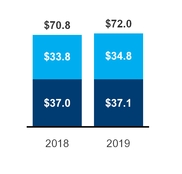
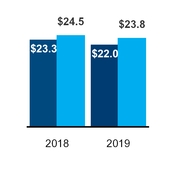
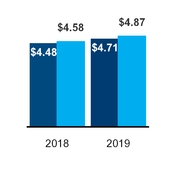
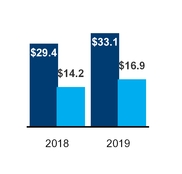
$72.0B | $22.0B | $23.8B | $4.71 | $4.87 | $33.1B | $16.9B | |||||||
GAAP | GAAP | non-GAAP1 | GAAP | non-GAAP1 | GAAP | non-GAAP1 | |||||||
Revenue up 2% from 2018; Data-centric up 3% and PC-centric flat | Operating income down $1.3B or 5% from 2018; 2019 operating margin at 31% | Operating income down $797M or 3% from 2018; 2019 operating margin at 33% | Diluted EPS up $0.23 or 5% from 2018 | Diluted EPS up $0.29 or 6% from 2018 | Operating cash flow up $3.7B or 13%; operating cash flow to net income at 157% | Free cash flow up $2.7B or 19%; free cash flow to non-GAAP net income at 78% | |||||||
High-performance product sales in the second half of 2019, partially offset by NAND pricing pressure and decrease in platform2 unit sales | Lower gross margin from decrease in NAND market pricing and lower platform unit sales, partially offset by platform ASP strength | Lower shares outstanding and platform ASP strength, partially offset by a decrease in platform unit sales and lower NAND market pricing | Working capital changes driven by tax and other assets and liabilities, partially offset by lower memory prepayments and inventory build | ||||||||||
GOAL (2019 - 2021) | GOAL (2019 - 2021) | GOAL (2019 - 2021) | GOAL (2019 - 2021) | |||||||
Low single-digit growth over the next three years to $76B-$78B; data-centric businesses high single- digit growth and PC-centric business approximately flat to slightly down | Keep non-GAAP operating margin roughly flat at approximately 32% over the next three years | Grow non-GAAP diluted EPS in line with revenue over the next three years | Achieve free cash flow of approximately 80% of non-GAAP net income by 2021 | |||||||
Progress | Progress | Progress | Progress | |||||||
Revenue grew 2% from 2018 to 2019, to $72.0B | Non-GAAP operating margin was 33% in 2019 | Non-GAAP diluted EPS grew 6% from 2018 to 2019; revenue grew 2% over the same period | Free cash flow was 78% of non-GAAP net income | |||||||
1 | See "Non-GAAP Financial Measures" within MD&A. |
2 | See "Our Products" within MD&A. |
 FUNDAMENTALS OF OUR BUSINESS FUNDAMENTALS OF OUR BUSINESS | 4 | |
DATA-CENTRIC BUSINESSES EXPAND WITH NEW OPPORTUNITIES | PC-CENTRIC BUSINESS INNOVATES | ||||
Data-Centric Portfolio Launch | 10nm-based 10th Generation Intel® CoreTM Shipping | ||||
We introduced a portfolio of data-centric solutions consisting of 2nd generation Intel® Xeon® Scalable processors, Intel® Optane™ DC memory and storage solutions, and software and platform technologies optimized to help our customers extract more value from their data. Our latest data center solutions target a wide range of use cases within cloud computing, network infrastructure, and intelligent edge applications, and support high-growth workloads, including AI and 5G. | |||||
We started shipping our 10nm-based 10th generation Intel® CoreTM processors, previously referred to as Ice Lake. Our 10th generation Intel® CoreTM processor silicon will enable the first wave of PCs with instructions for AI, includes an all-new CPU Core architecture and Gen 11 graphics engine, and is the first client CPU to integrate Wi-Fi 6 and Thunderbolt™ 3 connectivity modules. | |||||
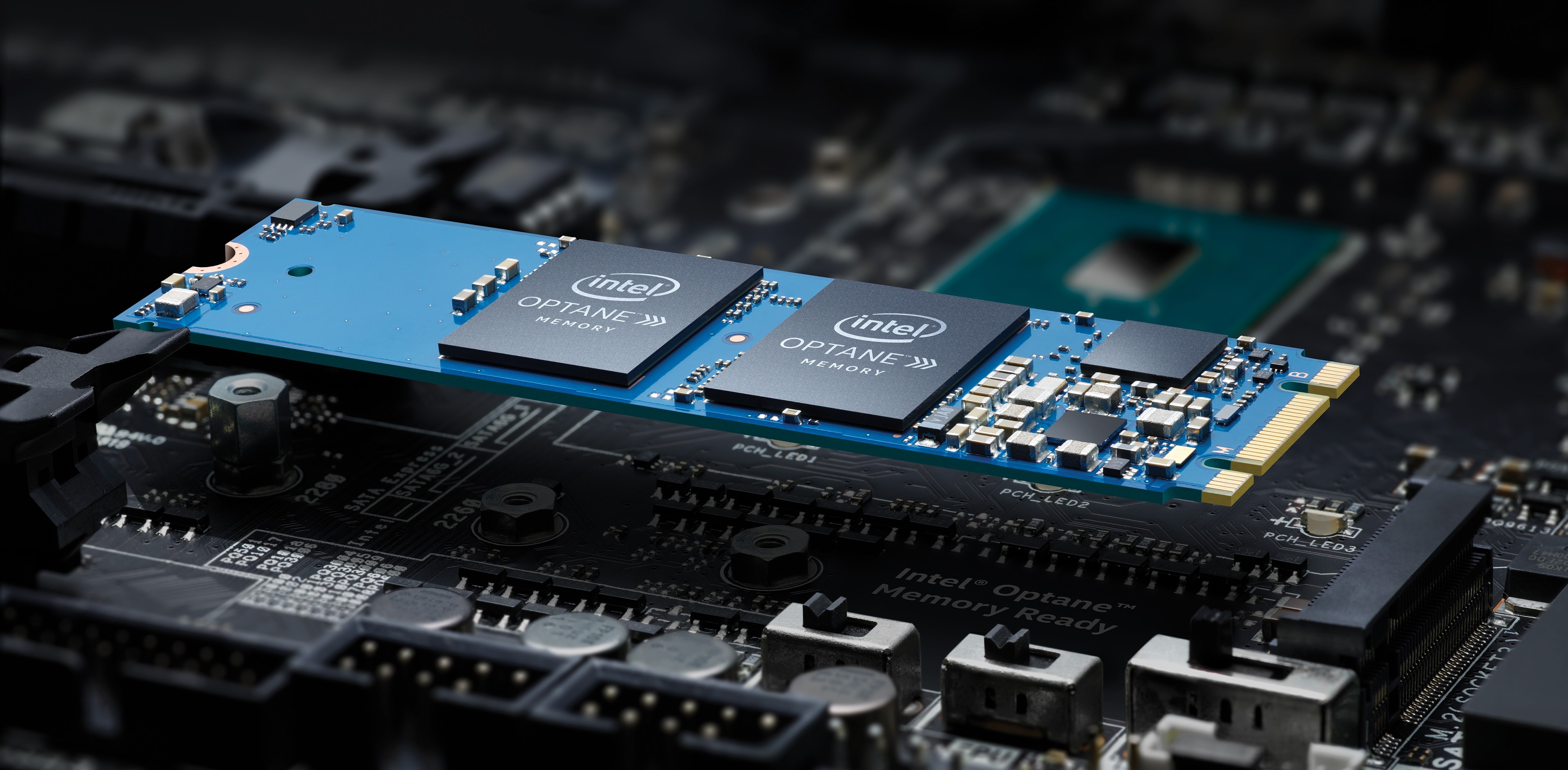 | 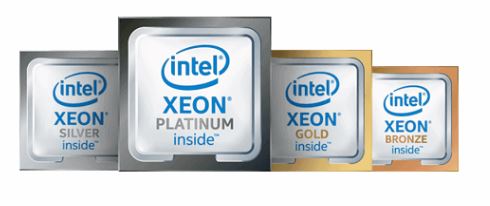 | ||||
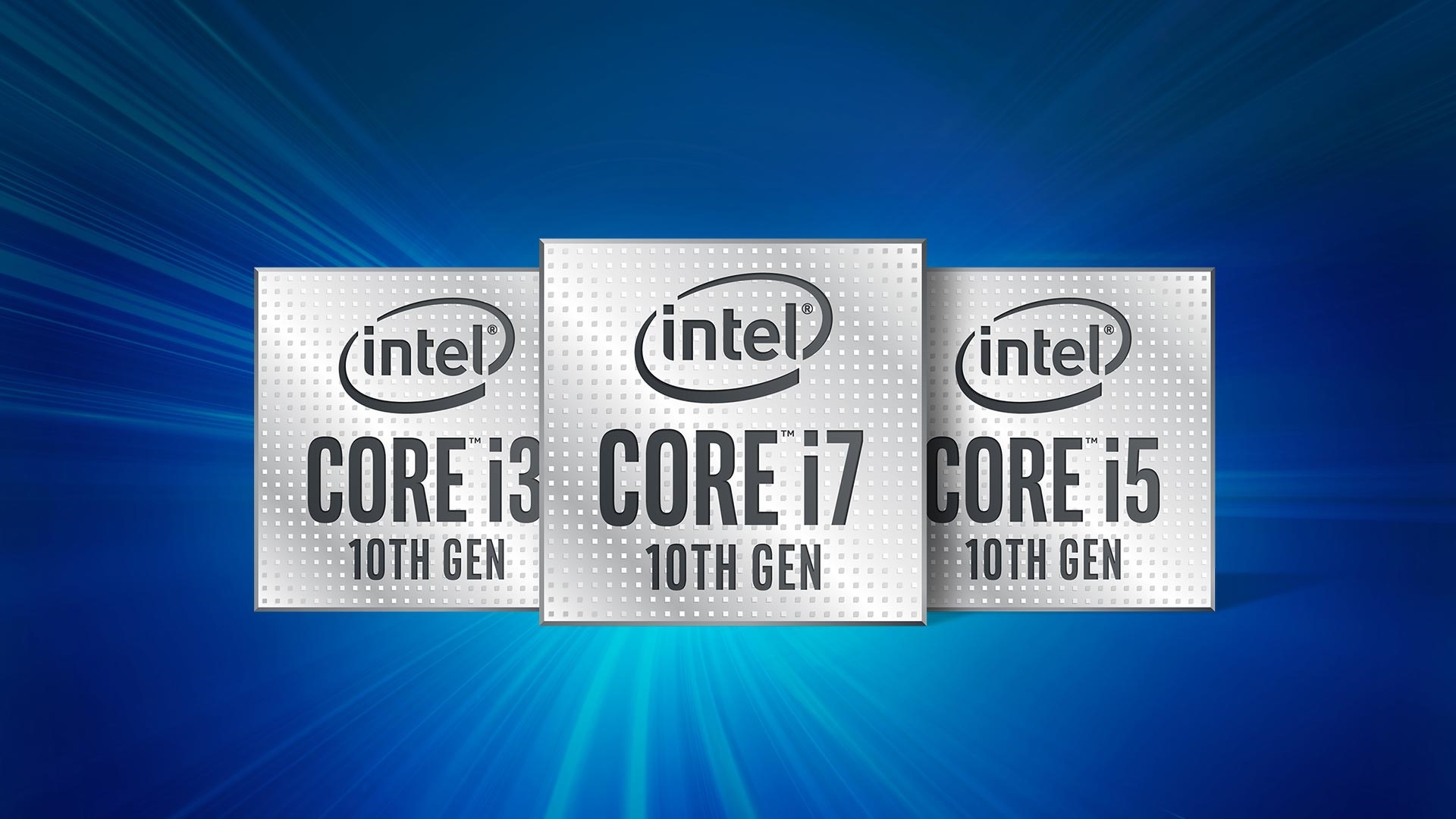 | |||||
10nm FPGAs Shipping | 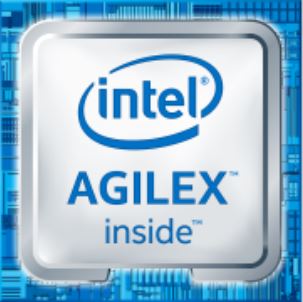 | ||||
We began shipping engineering samples of Intel® Agilex™ FPGAs to customers. The 10nm-based FPGAs are used by our customers to develop advanced solutions for networking, 5G, and accelerated data analytics. The Intel® Agilex™ FPGA family leverages heterogeneous 3D SiP technology to deliver higher performance or higher power efficiency. | |||||
Project Athena Innovation Program | |||||
Project Athena is a new multi-year innovation program to help the PC ecosystem create advanced laptops that meet ambitious key experience indicators in performance, responsiveness, battery life, form factor, and AI. The first laptops verified through the innovation program became | 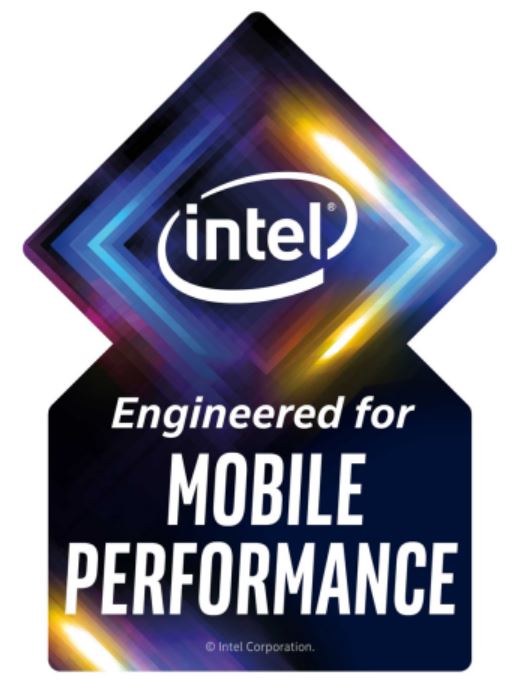 | ||||
Habana Labs Acquisition | |||||
We acquired Habana Labs Ltd., an Israel-based developer of programmable deep learning accelerators for the data center, for approximately $1.7 billion. Habana's AI processors provide data scientists and developers with accelerator hardware that improves processing performance and reduces power consumption. Habana's Gaudi* AI training processor is currently sampling with select hyperscale customers. Large-node training systems based on Gaudi* are expected to deliver up to four times increase in throughput versus systems built with the equivalent number of GPUs. The acquisition strengthens our AI portfolio and accelerates our efforts in the nascent, fast-growing AI silicon market. | |||||
available in 2019, identified by the visual marker "Engineered for Mobile Performance." | |||||
BIG BETS UPDATE | 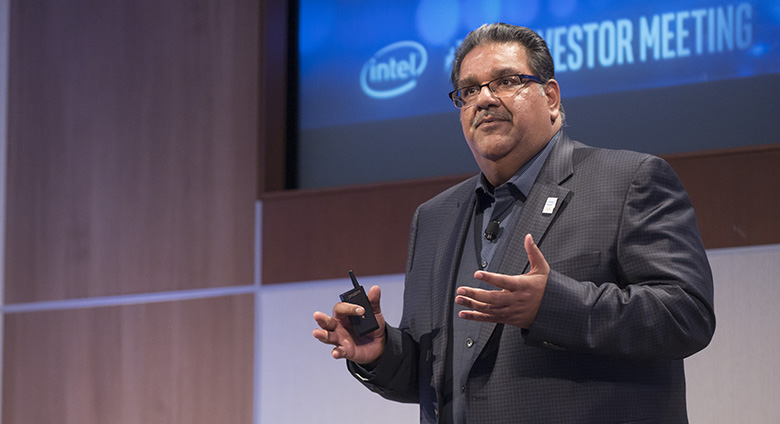 | ||||||
We aim to be at the forefront of the constant technological change in our industry. We will evaluate new and existing big bets based on the following criteria: the "bet" is leading the edge of a technology inflection, it plays a significant role in our customers' success, and it offers a clear path to profitability and attractive returns. Currently, our big bets are memory, autonomous driving, and 5G. | |||||||
We exited 5G smartphone modem business to increase the focus of our 5G efforts on the broader opportunity to modernize network and edge infrastructure. | |||||||
 | We continue to make progress in memory and autonomous driving. We launched Intel® Optane™ DC persistent memory for the data center and continue to take steps to improve NAND profitability. Mobileye's EyeQ*5, the vision central computer performing sensor fusion for fully autonomous driving, is operational in Mobileye's autonomous test vehicles. | ||||||
"While process and CPU leadership remain fundamentally important, an extraordinary rate of innovation is required across a combination of foundational building blocks, including architecture, memory, interconnect, security, and software, to take full advantage of the opportunities created by the explosion of data." —Dr. Venkata (Murthy) M. Renduchintala, Group President of the Technology, Systems Architecture and Client Group and Chief Engineering Officer | |||||||
 FUNDAMENTALS OF OUR BUSINESS FUNDAMENTALS OF OUR BUSINESS | 5 | |
OUR STRATEGY |
Data has become a driving force in society. Our customers are asking for solutions to turn data into actionable insights, amazing experiences, and operational efficiencies. Intel platforms provide the foundation for these solutions because we have developed a portfolio of data-centric technologies that span the data center to the edge, enabling us to play a differentiated and growing role in the success of our customers.
Moore’s Law, a law of economics predicted by Intel’s co-founder Gordon Moore more than 50 years ago, continues to be a strategic priority and differentiator. We make significant investments and innovations in our silicon manufacturing technologies and platforms. Our proprietary technologies make it possible to integrate products and platforms that address evolving customer needs and expand the markets we serve. However, making the best semiconductors requires more than just the best manufacturing process technologies.
We manufacture a majority of our products in our own facilities and make significant investments in silicon manufacturing technologies and platforms as an IDM. We are focused on strengthening our IDM position by collaborating with the broader silicon manufacturing and design ecosystem to improve our design efficiency, including increased strategic use of third-party design IP and foundries for certain components to allow us to focus on differentiating technology. We are also pursuing design simplification to accelerate innovation, including a significant reduction of design rules for future process nodes, to allow us to deliver the best solutions for our customer.
MAKE THE WORLD'S BEST SEMICONDUCTORS |
Product leadership is defined by our ability to optimize across six engineering pillars: process technology and packaging, architecture, memory, interconnect, security, and software. With these six pillars, we are accelerating product innovation with a focus on xPU platforms uniquely able to serve diverse new workload opportunities (e.g., CPU, GPU, AI accelerator and FPGA). These innovation efforts will extend Intel’s opportunities to deliver products beyond the CPU that will contribute to the success of our customers. | 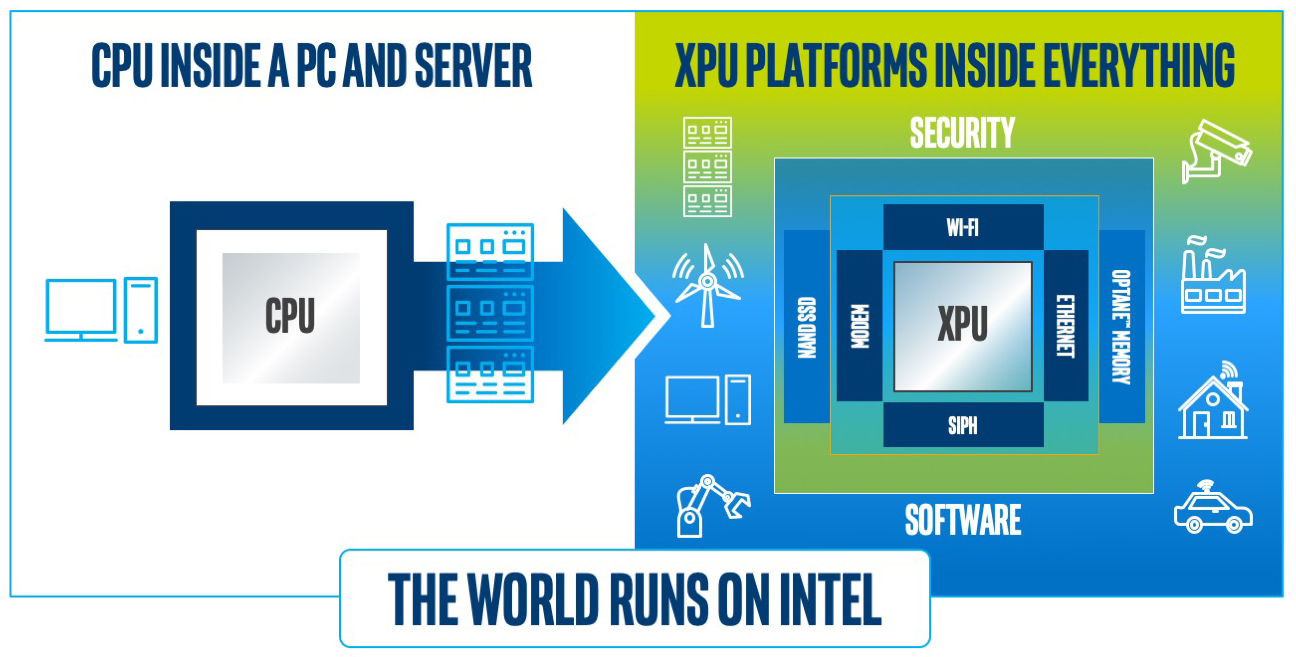 |
LEAD TECHNOLOGY INFLECTIONS |
Our strategic intent is to lead in key technology inflections that are fundamentally changing computing and communications. The most important drivers of change we see today are AI, the transformation of networks spearheaded by the transition to 5G, and the rise of the intelligent edge. We see a future where Intel® technologies enable our customers to move faster, store more, and process everything—from large complex applications in the cloud, to autonomous cars and small low-power devices on the edge.
AI helps our customers make sense of big data to unleash its potential. We offer a combination of hardware and software technologies that deliver broad capabilities to support computing, storage, transmission, and tuning in AI. We have taken a multi-architecture approach to AI hardware. Intel® Xeon® processors provide a foundation for analytics and AI, and software like the OpenVINO™ toolkit significantly simplifies the deployment of solutions. Intel® FPGAs allow customers to gain access to leading AI inferencing performance for their models. Similarly, the Intel® Nervana™ Neural Network Processors and Intel® Movidius™ Myriad™ VPUs are purpose-built for AI and support diverse approaches for innovation in a wide range of applications, from healthcare to autonomous driving to facial recognition. Habana's Gaudi* AI training Processor and Goya* AI Inference Processor offer an easy-to-program development environment to help customers deploy and differentiate their solutions as AI workloads continue to evolve with growing demands on compute, memory, and connectivity.
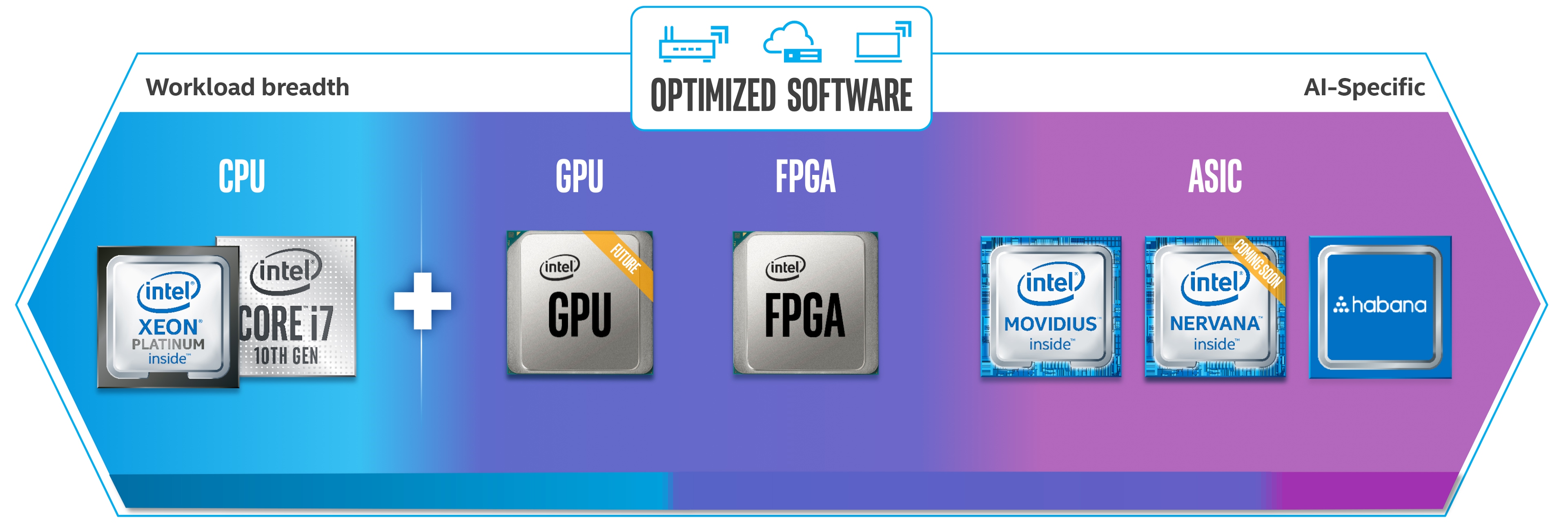
 FUNDAMENTALS OF OUR BUSINESS FUNDAMENTALS OF OUR BUSINESS | 6 | |
We are optimistic about the opportunity presented to us by the 5G transition and the cloudification1 of the network. 5G connectivity will transform industries from all business sectors and it continues to be a strategic priority across Intel. We are collaborating with ecosystem and vertical industry partners to define, prototype, test, and deliver 5G standards and solutions, and our team has developed products designed to support 5G network infrastructure and a valuable IP portfolio. With our exit from the 5G smartphone modem business, our 5G efforts are now focused on network infrastructure and other data-centric opportunities.
We provide the automobile industry’s leading solution for ADAS and we continue to build on that leadership in pursuit of higher levels of autonomy, developing Road Experience Management for real-time crowdsourced mapping, and the Responsibility Sensitive Safety model for autonomous vehicle safety. As the data explosion creates new opportunities, we continue to assess other service models that will leverage our product leadership and deep technical expertise to drive more value to our customers.
BE THE LEADING END-TO-END PLATFORM PROVIDER FOR THE NEW DATA WORLD | ||||
Customers look to Intel for our end-to-end capability to deliver solutions that enable customers to move faster, store more, and process everything. We continue to make investments in optimizing our Intel® Xeon® processors in response to our customers’ need for high-performance computing. We continue to develop innovative memory and storage solutions, including Intel® QLC 3D NAND Technology and Intel® Optane™ memory, to provide data center products that are optimized to deliver world-class performance and drive lower total cost of ownership for cloud workloads. Our advancements in FPGAs enable efficient management of the changing demands of next-generation data centers and accelerate the performance of emerging applications. | ||||
RELENTLESS FOCUS ON OPERATIONAL EXCELLENCE AND EFFICIENCY | ||||
Underlying our transformation to a data-centric company is a relentless focus on operational excellence and efficiency. This focus includes the elimination of lower growth investments and activities, and the simplification and automation of routine processes and activities. These efforts also extend to our product design processes, where we are striving to reduce the complexity of our designs to improve our efficiency and enhance quality. | ||||
These improvements enable us to achieve scale in our core operations, providing a stable and cost-effective platform to support additional investments in the design, development, and delivery of new products. Operational excellence helps us fund the expansion of our TAM through big-bet investments. | ||||
CONTINUE TO HIRE, DEVELOP, AND RETAIN THE BEST, MOST DIVERSE AND INCLUSIVE TALENT | |
At the core of our organization are highly skilled, diverse, and talented people capable of accelerating as one team in everything we do. We are proud of our past and inspired by how our employees are rising to the challenge to evolve our culture. Inclusion is the foundation of this evolution and runs through each of our culture attributes. These attributes reinforce: | |
● | Customer Obsessed: Our customer’s success is our success. We listen, learn, and anticipate our customers’ needs to deliver on their ambitions. |
● | One Intel: We are stronger together and commit to team over individual success. |
● | Fearless: We are bold and innovative. We take risks, fail fast, and learn from mistakes. |
● | Truth and Transparency: We are committed to being open and honest while bringing clarity to complex challenges. |
● | Inclusion: We strive to build a culture of belonging and welcome differences, knowing it makes us better. |
Our evolution is a multi-year journey, and one that requires new and different thinking, actions, systems, and processes to ensure that our employees are equipped to innovate for a world where all data needs to be processed, moved, stored, and analyzed. | |
1 | Intel's definition is included in "Key Terms" within the Financial Statements and Supplemental Details. |
 FUNDAMENTALS OF OUR BUSINESS FUNDAMENTALS OF OUR BUSINESS | 7 | |
OUR CAPITAL |
We deploy various forms of capital to execute our strategy in a way that seeks to reflect our corporate values, help our customers succeed, and create value for our stakeholders. |
CAPITAL | STRATEGY | VALUE |
FINANCIAL | ||
Leverage cash flow to invest in ourselves and grow our capabilities, supplement and strengthen our capabilities through acquisitions and strategic investments, and provide returns to stockholders. | We strategically invest financial capital to create long-term value and provide returns to our stockholders in the form of dividends and buybacks. | |
INTELLECTUAL | ||
Invest significantly in R&D and IP to ensure our process and product technologies are competitive in our strategic pursuit of making the world’s best semiconductors and realizing data-centric opportunities. | We develop IP for our platforms to enable next-generation products, create synergies across our businesses, provide a higher return as we expand into new markets, and establish and support our brands. | |
MANUFACTURING | ||
Invest timely and at a level sufficient to meet customer demand for current technologies and prepare for future technologies. | Our manufacturing scope and scale enables innovations to provide our customers and consumers with a broad range of leading-edge products. | |
HUMAN | ||
Develop the talent needed to remain at the forefront of innovation and create a diverse, inclusive, and safe workplace. | We attract and retain talented employees who enable the development of solutions and enhance the intellectual and manufacturing capital critical to helping our customers win the technology inflections of the future. | |
SOCIAL AND RELATIONSHIP | ||
Build trusted relationships for both Intel and our stakeholders, including employees, suppliers, customers, local communities, and governments. | We collaborate with stakeholders on programs to empower underserved communities through education and technology, and on initiatives to advance accountability and capabilities across our global supply chain, including accountability for the respect of human rights. | |
NATURAL | ||
Continually strive to reduce our environmental footprint through efficient and responsible use of natural resources and materials used to create our products. | Our proactive efforts help us mitigate climate and water impacts, achieve efficiencies and lower costs, and position us to respond to the expectations of our stakeholders. | |
 FUNDAMENTALS OF OUR BUSINESS FUNDAMENTALS OF OUR BUSINESS | 8 | |
FINANCIAL CAPITAL | |
Our financial capital allocation strategy focuses on building stockholder value. We have returned approximately 90% of free cash flow to investors over the past five years and expect to return approximately 100% in 2020.
CASH FROM OPERATING ACTIVITIES $B |
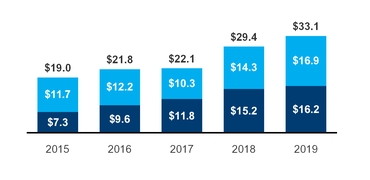
■ Capital Investment | ■ Free Cash Flow1 | |
OUR FINANCIAL CAPITAL ALLOCATION DECISIONS ARE DRIVEN BY THREE PRIORITIES |
INVEST IN THE BUSINESS | ACQUIRE AND INTEGRATE | RETURN CASH TO STOCKHOLDERS | ||||||
Our first allocation priority is to invest in R&D and capital spending to strengthen our competitive position. We shifted our R&D focus as we began a transformation to a data-centric company, while efficiently maintaining our investment at approximately 20% of revenue. We invested record levels of capital in logic (primarily platform wafer manufacturing) during the last two years to expand our capacity. With that investment, we increased our 14nm wafer capacity while also ramping 10nm production. We expect to further increase our PC client supply on both process nodes in 2020. | Our second allocation priority is to invest in companies around the world that will complement our strategic objectives and stimulate growth of data-centric opportunities. We look for acquisitions that leverage and strengthen our capital and R&D investments. In 2019, we completed various acquisitions, including Habana Labs and Barefoot Networks, to expand our product offerings and the markets we serve. We take action when investments do not meet our criteria, and in 2019 we divested the majority of our 5G smartphone modem business for this reason. | Our third allocation priority is to return cash to stockholders. We achieve this through our dividend and share repurchase programs. During 2019, we paid $5.6 billion in dividends and repurchased $13.6 billion in shares, up from 2018. In October 2019, we announced that we expect to repurchase $20.0 billion in shares over the next 15 to 18 months. Our approach has reduced diluted shares outstanding over time. | ||||||
Dividends Per Share | Diluted Shares Outstanding (In Millions) | |||||||
2019 | $1.26 | 8% CAGR | 4,473 | |||||
2018 | $1.20 | 4,701 | ||||||
2017 | $1.0775 | 4,835 | ||||||
R&D AND CAPITAL INVESTMENTS $B | ACQUISITIONS | CASH TO STOCKHOLDERS $B | |||
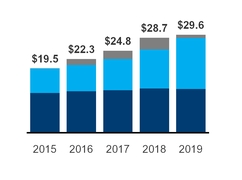
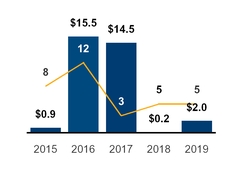

■ R&D | ■ Logic | ■ Memory | — # of Acquisitions | ■ Total Spent $B | ■ Buyback | ■ Dividend | |||
1 | See "Non-GAAP Financial Measures" within MD&A. |
 FUNDAMENTALS OF OUR BUSINESS FUNDAMENTALS OF OUR BUSINESS | Our Capital | 9 |
INTELLECTUAL CAPITAL | |
RESEARCH AND DEVELOPMENT
R&D is a critical factor in achieving our strategic objectives to make the world's best semiconductors, to lead technology inflections, and to provide leading end-to-end platform solutions. Successful R&D efforts can lead to new products and technologies or improvements to existing ones, which we seek to protect through our IP rights. We may augment our R&D initiatives through the following methods: acquiring or investing in companies, entering into R&D agreements, and directly purchasing or licensing technology.
PRODUCT TECHNOLOGY
Architecture. We are designing products for four major computing architectures—CPU, GPU, AI accelerator, and FPGA products—as we move toward a model of providing multiple "xPU" compute platforms for a more diverse era of computing. We shipped the 10th generation Intel® CoreTM processors with our next-generation CPU microarchitecture, which has architectural extensions designed for special-purpose computing tasks such as AI and cryptography, among other features. These processors also include the next generation of graphics microarchitecture, with performance and feature upgrades. We also continue to make progress on the development of our first discrete GPU.
Every year we make significant investments in R&D and we have intensified our focus on six engineering pillars to advance our product capabilities. Our objective is to improve user experiences and value through advances in performance, power, cost, connectivity, security, form factor, and other features with each new generation of products. We are also focused on reducing our design complexity to improve our efficiency, including a significant reduction of design rules for future process nodes. | 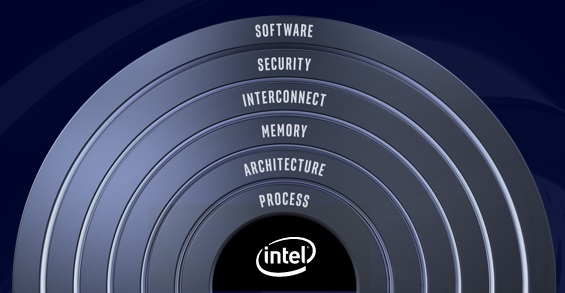 | |
Process. Development of next-generation manufacturing processes remains a critical and fundamental pillar. We announced that we are planning multiple waves of 10nm process, progressively increasing transistor performance. We also announced advances in our next-generation 2.5D (EMIB) and 3D (Foveros) packaging technology which will enable us to mix and match chips made on different processes into a single SiP, enabling new design flexibility and new device form factors. The Intel 10nm product era is underway, as we began shipping our new 10th generation Intel® CoreTM processors, previously referred to as Ice Lake. | ||
Six Pillars of Product Leadership | ||
Memory. With our Intel® 3D NAND technology and Intel® Optane™ technology, we are developing products to disrupt the memory and storage hierarchy. The 4th generation of Intel®-based SSDs are scheduled to launch in 2020 with 144-layer QLC memory technology. These SSDs are also Intel’s first NAND memory technology created independently by Intel since the conclusion of our partnership with Micron Technology, Inc. (Micron). The 2nd generation Intel® OptaneTM SSDs for data centers are scheduled to start shipping samples in 2020, and are designed to deliver three times the throughput while reducing application latency by four times. In addition, the second-generation Intel® OptaneTM DC persistent memory is expected to achieve PRQ in 2020, and is designed for use with our future Intel® Xeon® CPUs.
Interconnect. We have a broad portfolio of interconnect solutions, ranging from silicon to the data center to wireless. Our silicon photonics technology integrates lasers into silicon to create high-speed optical connections that can help remove networking bottlenecks in the data center. We announced two initiatives to help influence the industry—USB4 and CXL. USB4 advances the speed and capability for interconnect in client platforms. CXL, an open interconnect technology, creates a high-speed, low latency interconnect between the CPU and accelerators, such as GPUs, FPGAs, and networking.
Security. We continue to make significant investments in security technologies. We created the Intel Security Architecture and Technologies Group to serve as a center for security architecture across our products to design world-class product security architecture for the years ahead.
Software. The performance potential of our hardware products is unlocked with software. Our vision is to unify our software abstractions across all our xPU platforms. We are developing a project called oneAPI to simplify programming for developers across our CPU, GPU, FPGA, AI accelerator, and other accelerator products, providing a unified portfolio of developer tools for mapping software to the hardware that can best accelerate the code.
IP RIGHTS
We own and develop significant IP and related IP rights around the world that support our products, services, R&D, and other activities and assets. Our IP portfolio includes patents, copyrights, trade secrets, trademarks, mask work, and other rights. We actively seek to protect our global IP rights and to deter unauthorized use of our IP and other assets. For a detailed discussion of our IP rights, see "Intellectual Property Rights and Licensing" within Other Key Information.
 FUNDAMENTALS OF OUR BUSINESS FUNDAMENTALS OF OUR BUSINESS | Our Capital | 10 |
MANUFACTURING CAPITAL | |
We are an IDM. Unlike many other semiconductor companies, we primarily design and manufacture our products in our own manufacturing facilities, and we see our in-house manufacturing as an important advantage. We continue to develop new generations of manufacturing process technology as we seek to realize the benefits from Moore’s Law. Realizing Moore’s Law results in economic benefits as we are able to either reduce a chip's cost as we shrink its size, or increase functionality and performance of a chip while maintaining the same cost with higher density. This makes possible the innovation of new products with higher performance while balancing power efficiency, cost, and size to meet customers' needs. Our ability to optimize and apply our manufacturing expertise to deliver more advanced, differentiated products is foundational to our current and future success.
We are on track to deliver our first 7nm-based product, a data center-focused discrete GPU, at the end of 2021. We are approaching next-generation process nodes with a focus on striking an optimal balance between schedule, performance, power, and cost and will continue to drive intra-node advancement.
We improved our 10nm factory production, yield, and volume during 2019, and launched 10th-generation Intel® CoreTM processors, our first 10nm volume product, and Intel® AgilexTM, our first 10nm FPGA. We expect to deliver initial production shipments of our first 10nm-based Intel® Xeon® Scalable product, Ice Lake, in the latter part of 2020. |  | "Our technology and innovation pipeline is as full and as strong as it’s ever been. By embracing our ecosystems and delivering new capability on a predictable cadence, we will continue to drive Moore’s Law forward and create compelling products for our customers.” —Mike Mayberry, Senior Vice President, Chief Technology Officer and General Manager of Technology Development | |
NETWORK AND SUPPLY CHAIN
We previously announced multiple manufacturing site expansions with multi-year construction activities that began in 2019. In addition to expanding our own manufacturing capability, we are increasing our use of foundries to enable our differentiated manufacturing to produce more CPU products. We use third-party foundries to manufacture wafers for certain components and leverage subcontractors to augment capacity to perform assembly and test in addition to our in-house manufacturing, primarily for chipsets and adjacent products. As we considered the estimated $300 billion TAM1 opportunity ahead of us, it was imperative that we prepare our global manufacturing network to be responsive to changes in demand. However, despite increasing 14nm wafer capacity, we did not see a commensurate increase in client CPU unit volume as wafer capacity was largely consumed by increases in modem and chipset volumes, and unit die sizes. Our focus on capacity expansion and meeting customer expectations is critical as we move into 2020.
We have nine manufacturing sites—six are wafer fabrication and three are assembly/test facilities. The map marks our manufacturing sites and the countries where we have a significant R&D or sales and marketing presence. The majority of our logic wafer manufacturing is conducted in the U.S. We incur factory start-up costs as we ramp facilities for new process technologies. We ramped the 10nm process node in Oregon and Israel in 2019, and began production in Arizona in our 2020 fiscal year. We also expanded our memory facilities in Dalian, China. | 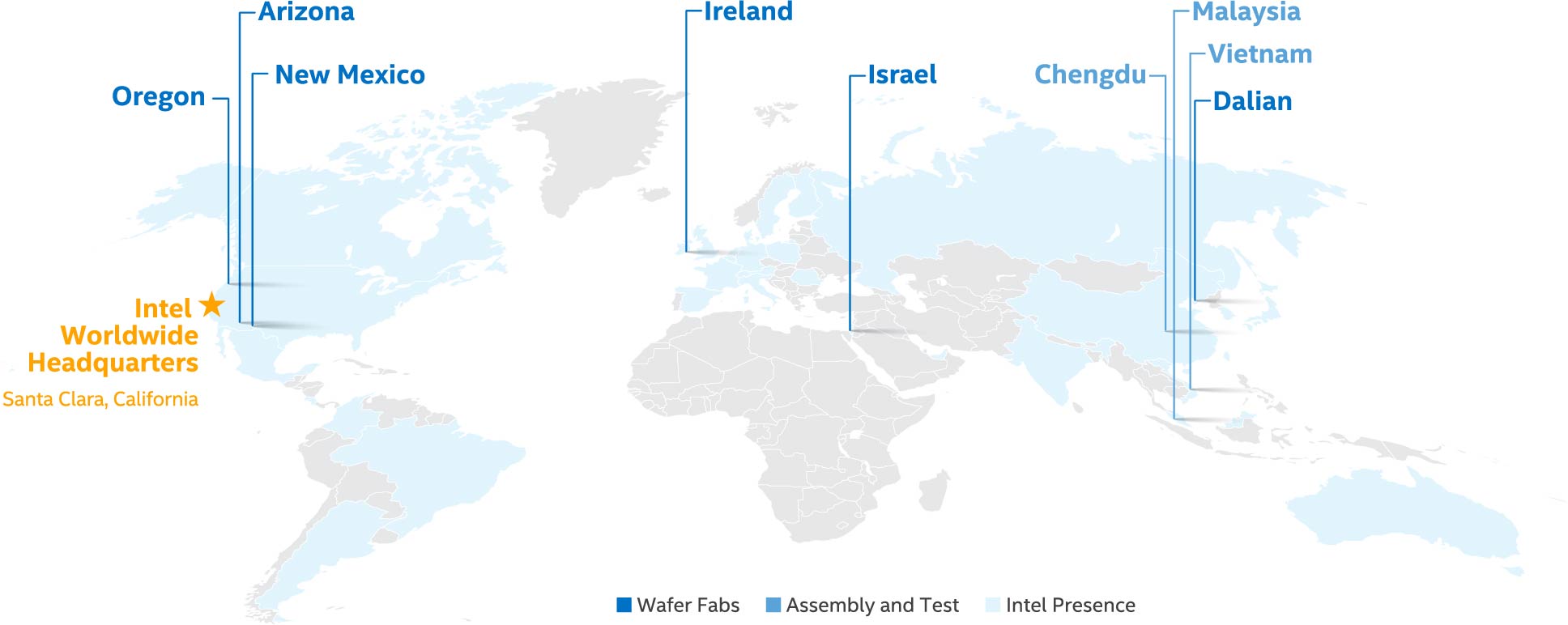 |
Our manufacturing facilities are primarily used for silicon wafer manufacturing of our platform and memory products. These facilities are built following a “copy exactly” methodology, whereby new process technologies are transferred identically from a central development fab to each manufacturing facility. This enables fast ramp of the operation as well as better quality control. These wafer fabs operate in a network of manufacturing facilities integrated as one factory to provide the most flexible supply capacity, allowing us to better analyze our production costs and adapt to changes in capacity needs.
In 2019, we ramped 96-layer 3D NAND technology and prepared to begin manufacturing our 144-layer 3D NAND technology in 2020 in our facility in Dalian, China. The next generation of Intel® Optane™ technology and SSDs are being developed in New Mexico following the sale of our non-controlling interest in IMFT to Micron on October 31, 2019. We will continue to purchase product manufactured by Micron at the IMFT facility under established supply agreements.
1 Source: Intel calculated 2024 TAM derived from industry analyst reports.
 FUNDAMENTALS OF OUR BUSINESS FUNDAMENTALS OF OUR BUSINESS | Our Capital | 11 |
HUMAN CAPITAL | |
Evolving our culture is critical to delivering on our growth strategy and for continuing to attract and retain top talent needed to support our transformation to a data-centric company. We have an amazing legacy of innovation and a powerful culture, yet our ambitions have grown. Together, we are evolving our culture to build an even brighter future. Our global workforce of 110,800 is highly educated, with approximately 90% of our people working in technical roles. We invest in creating a diverse, inclusive, and safe work environment where our employees can deliver their workplace best every day. | ||
All employees are responsible for upholding the Intel Values, Intel Code of Conduct, and Intel Global Human Rights Principles, which form the foundation of our policies and practices. For over a decade, we have tracked and publicly reported on key human capital metrics, including workforce demographics, diversity and inclusion data, turnover, and training data. |  | "Tapping into the richness of our diverse workforce is key to driving future growth. Intel will continue to be transparent about our progress and our challenges, so we can partner with our customers and ecosystem to find better solutions together." —Sandra Rivera, Executive Vice President and Chief People Officer |
DIVERSITY AND INCLUSION | 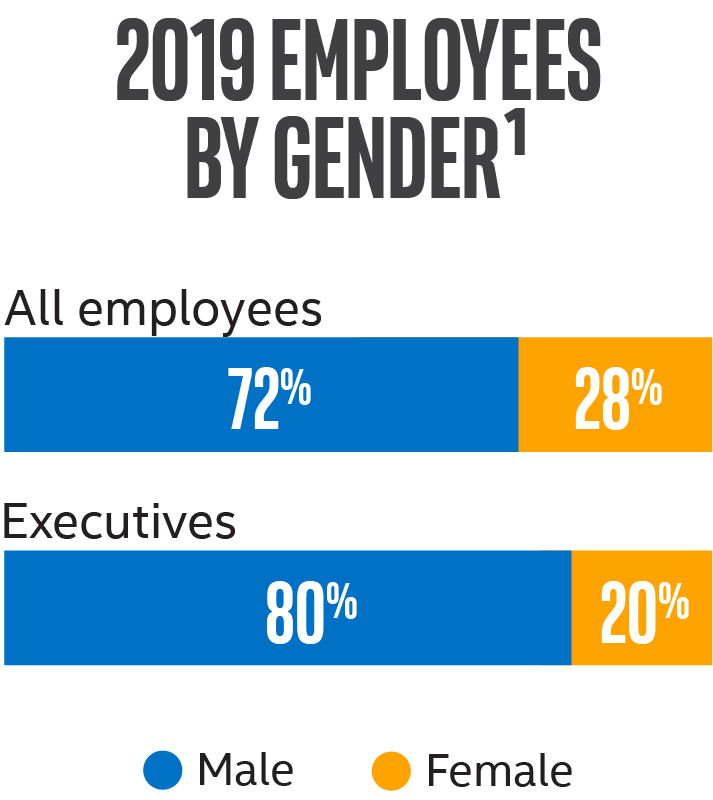 |
To shape the future of technology, we must be representative of that future. A diverse and inclusive workforce is a business imperative and key to our long-term success. We committed $300 million to advance diversity and inclusion in our workforce and in the technology industry. We achieved our goal of full representation in our U.S. workforce two years ahead of schedule, meaning our workforce now reflects the percentage of women and underrepresented minorities available in the skilled labor market in the U.S. This achievement was the result of a comprehensive strategy that considered hiring, retention, and progression. Though we are proud of what we have accomplished to advance diversity in our workforce, we still have work to do, including beyond the walls of Intel. We took action by joining 11 other companies to fund an initiative to double the number of women of color graduating with computing degrees in the U.S. by 2025. We also continue to look for and implement partnerships and programs to increase retention and advancement of women and underrepresented populations within our workplace. The breakout of employees by gender provides our current global gender diversity. | |
COMPENSATION AND BENEFITS |  |
We strive to provide pay, benefits, and services that help meet the varying needs of our employees. Our generous total rewards package includes market-competitive pay, broad-based stock grants and bonuses, an Employee Stock Purchase Plan, healthcare and retirement benefits, paid time off and family leave, parent reintegration, fertility assistance, flexible work schedules, sabbaticals, and on-site services. In 2019, we announced that we achieved gender pay equity globally by closing the gap in average pay between employees of different genders in the same or similar roles after accounting for legitimate business factors that can explain differences, such as performance, time at grade level, and tenure. We also continued to advance transparency in our pay and representation data by publicly releasing our 2017 and 2018 EEO-1 survey pay data mandated by the U.S. Equal Employment Opportunity Commission. The results reflected representation gaps and point to work that lies ahead. However, due to our diversity and inclusion efforts, there is promising growth of our junior female and underrepresented talent from which our future leadership will be drawn. Our challenge now is to create an environment that better helps our female and underrepresented employees develop and progress in their careers, while also ensuring we are expanding our hiring and retention of diverse talent at more senior, higher-paying positions. | |
1 | Executives refers to salary grades 12+ and equivalent grades. While we present male and female, we acknowledge this is not fully encompassing of all gender identities. |
 FUNDAMENTALS OF OUR BUSINESS FUNDAMENTALS OF OUR BUSINESS | Our Capital | 12 |
GROWTH AND DEVELOPMENT | 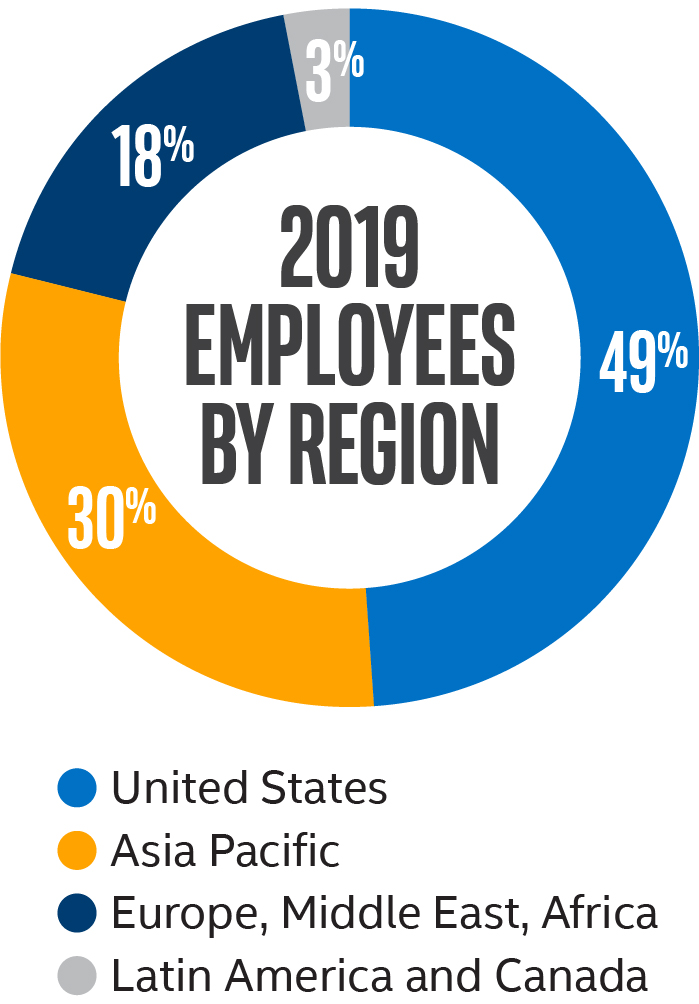 |
We invest significant resources to develop the talent needed to remain at the forefront of innovation and make Intel an employer of choice. We deliver training annually and provide rotational assignment opportunities. We launched a new performance management system to support our culture evolution and increase focus on continuous learning and development. Over the past five years, our undesired voluntary turnover rate has been at or below 5%. | |
COMMUNICATION AND ENGAGEMENT | |
Our success depends on employees understanding how their work contributes to the company’s overall strategy. We use a variety of channels to facilitate open and direct communication, including open forums with executives; employee experience surveys; and engagement through more than 30 different employee resource groups, including the Women at Intel Network, the Network of Intel African American Employees, the Intel Latino Network, and others. | |
HEALTH, SAFETY, AND WELLNESS | |
We are committed to the safety of our employees, customers, and communities, from operations to product development to supplier partnerships. Our ultimate goal is to achieve zero serious injuries through continued investment in and focus on our core safety programs and injury-reduction initiatives. We provide access to a variety of innovative, flexible, and convenient health and wellness programs, including on-site health centers. | |
SOCIAL AND RELATIONSHIP CAPITAL | |
We are committed to developing trusted relationships, giving back to our communities, and engaging in corporate responsibility and sustainability initiatives. Collaboration with stakeholders and investments in social impact initiatives, like the United Nations Sustainable Development Goals, led to our reputation as a leading corporate citizen and creates value in the form of consistent stakeholder support.
ECONOMIC, SOCIAL, AND HUMAN RIGHTS IMPACT
The health of our company and local economies depends on continued investments in innovation. We provide high-skill, high-paying jobs around the world. Many of these are manufacturing and R&D jobs located in our own domestic and international factories. We also impact economies through our R&D ecosystem spending, sourcing activities, consumer spending by our employees, and tax revenue. We make sizable capital investments and provide leadership in public-private partnerships to spur economic growth and innovation.
We are at the forefront of new technologies that are increasingly being used to empower individuals, companies, and governments around the world to solve major societal challenges. Simultaneously, we are empowering people through education and advancing social impact initiatives to create new career pathways into the technology industry, helping us build trust with key external stakeholders and support the interests of our employees. Our employees actively share their expertise and skills through volunteer initiatives, and contributed 1 million hours of service in the communities where we operate in 2019.
We are committed to maintaining and improving processes to avoid human rights violations related to our operations, supply chain, and products. While we do not always know nor can we control what products our customers create or the applications end-users may develop, we do not support or tolerate our products being used to violate human rights. Where we become aware of a concern that Intel products are being used by a business partner in connection with abuses of human rights, we will restrict or cease business with the third party until and unless we have high confidence that Intel’s products are not being used to violate human rights.
SUPPLY CHAIN RESPONSIBILITY
We have robust programs to educate and engage suppliers that support our global manufacturing operations to drive responsible and sustainable practices throughout the supply chain. Actively managing our supply chain creates business value for Intel and our customers by helping to reduce risk, improve product quality, achieve environmental and social goals, and raise the overall performance of our suppliers. Over the past five years, we completed more than 600 supplier audits using the Responsible Business Alliance Code of Conduct standard. We actively collaborate with other companies and lead industry initiatives on key issues such as advancing responsible minerals sourcing, improving transparency around climate and water impacts in the global electronics supply chain, and addressing risks of forced and bonded labor. Our commitment to building a diverse and inclusive workforce extends to the expectations we set for our suppliers—a diverse supply chain supports greater innovation and value for our business. We continue working toward our 2020 goal of reaching $1.0 billion in annual spending with diverse-owned suppliers. We also announced the "Intel Rule" to help improve diversity in the legal profession: Beginning in 2021, we will not retain or use outside law firms in the U.S. that are average or below average on diversity for their equity partners. We are applying a similar rule to firms used by our tax department, including non-legal firms.
 FUNDAMENTALS OF OUR BUSINESS FUNDAMENTALS OF OUR BUSINESS | Our Capital | 13 |
NATURAL CAPITAL | ||||
Driving to the lowest environmental footprint possible helps us achieve efficiency, lower costs, and respond to the needs of our stakeholders. We invest in conservation projects and set company-wide environmental targets, seeking to drive reductions in greenhouse gas emissions, energy use, water use, and waste generation. We focus on building energy efficiency into our products to help our customers lower their own emissions and energy costs. We also collaborate with policymakers and other stakeholders to identify opportunities to apply technology to environmental challenges such as climate change and water conservation.
 | "At Intel, we have long believed that to truly be a leader in manufacturing, we must also advance environmental sustainability and corporate responsibility. For more than two decades, our sustainability practices have enabled us to create significant value for our customers, investors, employees, and community stakeholders." —Ann Kelleher, Senior Vice President and General Manager of Manufacturing and Operations | |
CLIMATE AND ENERGY
We focus on reducing our own direct climate “footprint” and over the past two decades have reduced our direct emissions and electricity-generated emissions. Since 2012, we have invested more than $200 million in energy conservation projects in our global operations, resulting in cumulative savings of more than 4.5 billion kWh and cost savings of more than $500 million. In addition to conserving energy, we invest in green power and on-site alternative energy projects that provide power directly to our buildings and design all new buildings to LEED* standards. In 2019, we opened a LEED Platinum building in Israel with sensors that monitor lighting, temperature, ventilation, parking, and other building services and systems that enable and foster smart innovation. It also employs stormwater runoff collection and injection wells to avoid groundwater runoff. We also focus on increasing our “handprint”—the ways in which Intel technologies can help others reduce their footprints, including Internet of Things solutions that enable intelligence in machines, buildings, supply chains, and factories, and make electrical grids smarter, safer, and more efficient.
We are leveraging a leading framework developed by TCFD to communicate our approach to climate governance, strategy, risk management, and metrics and targets. In terms of governance and strategy, we follow an integrated approach to addressing climate change, with multiple teams responsible for managing climate-related activities, initiatives, and policies, including manufacturing and operations, government and public affairs, supply chain, and product teams. Strategies and progress toward goals are reviewed with senior executives and the Board’s Corporate Governance and Nominating Committee. We describe our overall risk management processes in our Proxy Statement, and we describe our climate-related risks and opportunities in our annual Corporate Responsibility Report, the Intel Climate Change Policy, and "Risk Factors" within this Form 10-K. Regarding metrics and goals, for two decades we have set aggressive GHG reduction goals, including our 2020 goal to reduce our direct GHG emissions by 10% on a per-unit basis from 2010 levels, which we are on track to achieve. Additional detail on our proactive efforts to address climate change is included in our Corporate Responsibility Report, as well as our CDP Climate Change Survey, both available on our website1.
WATER STEWARDSHIP
Water is essential to the semiconductor manufacturing process. We use ultrapure water to remove impurities from our silicon wafers, and we use industrial and reclaimed water to run our manufacturing facility systems. Over the last two decades, our sustainable water management efforts and partnerships have enabled us to conserve billions of gallons of water, and over the last decade we have returned approximately 80% of our water back to our communities. We continue to work toward our goal to restore 100% of our global water use by 2025, with more than 20 projects funded in collaboration with environmental and community partners through the end of 2019. We expect to restore approximately 1.5 billion gallons of water each year to local watersheds once these projects are complete.
CIRCULAR ECONOMY AND WASTE MANAGEMENT
We have long been committed to waste management, recycling, and circular economy strategies that enable the recovery and productive re-use of waste streams. We achieved our 2020 goal of recycling 90% of our non-hazardous waste ahead of schedule. We continue to work toward our 2020 goal of sending zero hazardous waste to landfills. Our aim is to continue to invest in reducing the amount of waste we generate while increasing the amount recycled and identifying re-use solutions that reduce costs and environmental impact.
1 The contents of our website and our Corporate Responsibility Report, Climate Change Policy, and CDP Climate Change Survey are referenced for general information only and are not incorporated by reference in this Form 10-K.
 FUNDAMENTALS OF OUR BUSINESS FUNDAMENTALS OF OUR BUSINESS | Our Capital | 14 |
VALUE WE CREATE
Each of our six forms of capital plays a critical role in our long-term value creation. We consider numerous indicators in determining the success of our capital deployment in creating value. Highlights of value created up to and in 2019 are as follows:
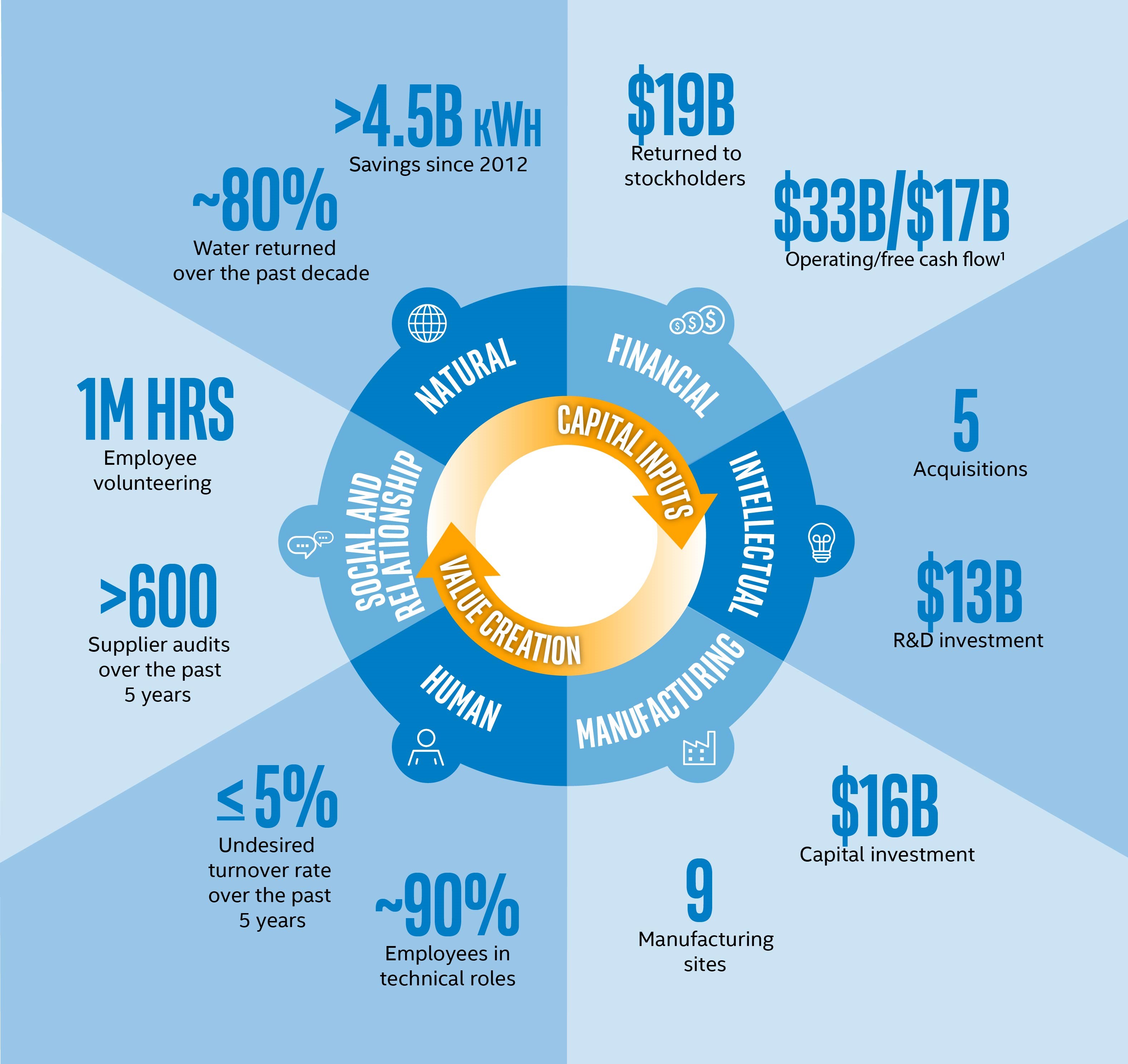 |
1 | See "Non-GAAP Financial Measures" within MD&A. |
 FUNDAMENTALS OF OUR BUSINESS FUNDAMENTALS OF OUR BUSINESS | Our Capital | 15 |
MANAGEMENT'S DISCUSSION AND ANALYSIS |

% INTEL REVENUE | KEY PRODUCTS AND MARKETS | HIGHLIGHTS | |||||
DCG | 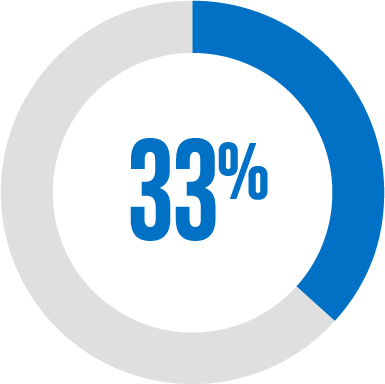 | Includes workload-optimized platforms and related products designed for cloud, enterprise, and communication infrastructure market segments. | Revenue for our data-centric businesses was up 3% year over year. Growth in DCG, IOTG, Mobileye, and NSG was offset by decline in PSG. We introduced new data-centric products, such as the Intel® AgilexTM FPGA, 2nd generation Intel® Xeon® Scalable processor, and Intel® Optane™ DC persistent memory. In addition, Mobileye continued to secure new design wins at major U.S. and global automakers and announced plans to commercialize MaaS. | ||||
IOTG |  | Includes high-performance compute solutions for targeted verticals and embedded applications in market segments such as retail, industrial, smart infrastructure, and vision. | |||||
OPPORTUNITIES | |||||||
MOBILEYE |  | Includes development of computer vision and machine learning-based sensing, data analysis, localization, mapping, and driving policy technology for ADAS and autonomous driving. | We have expanded our data-centric TAM to approximately $230 billion1 with acquisitions and product innovations. Our broadened portfolio enables new opportunities for us and creates better synergistic value for our customers. For example, our product offerings for AI workloads reach from the cloud to the edge, and we are developing CPU, GPU, FPGA, and AI accelerator products to span inference and training AI workloads, while also pursuing ongoing software optimizations for AI. | ||||
NSG |  | Includes memory and storage products like Intel® Optane™ technology and Intel® 3D NAND technology, primarily used in SSDs. | |||||
CHALLENGES | |||||||
DCG growth slowed as major cloud service providers and enterprise OEMs worked through inventory after a historic platform refresh in 2018. As we enter 2020, we expect to face an increasingly competitive market. In addition, challenging market conditions resulted in margin compression on memory products. | |||||||
PSG | 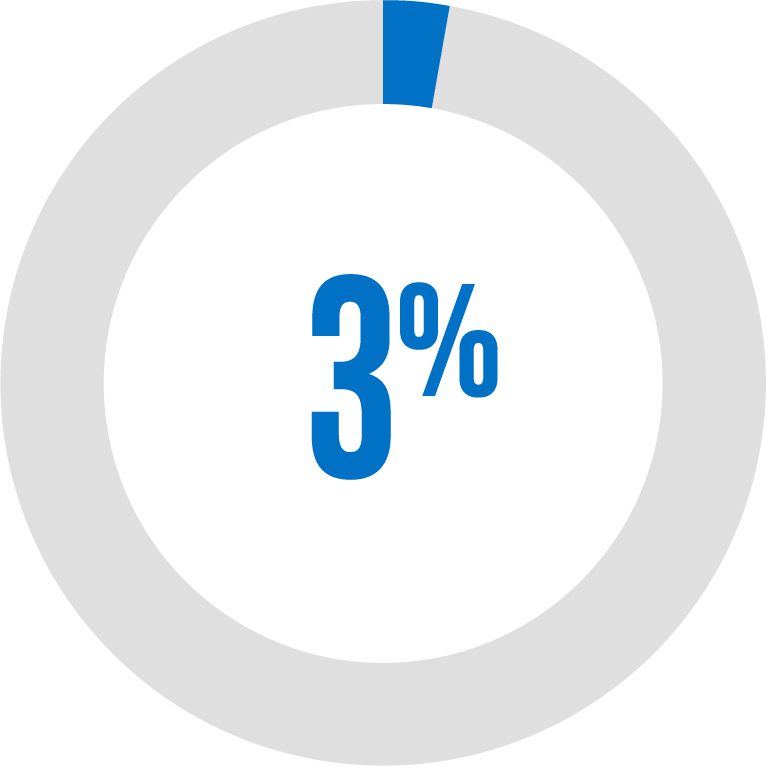 | Includes programmable semiconductors, primarily FPGAs and structured ASICs, and related products for communications, cloud and enterprise, and embedded market segments. | |||||

% INTEL REVENUE | KEY PRODUCTS AND MARKETS | ||||||
CCG | 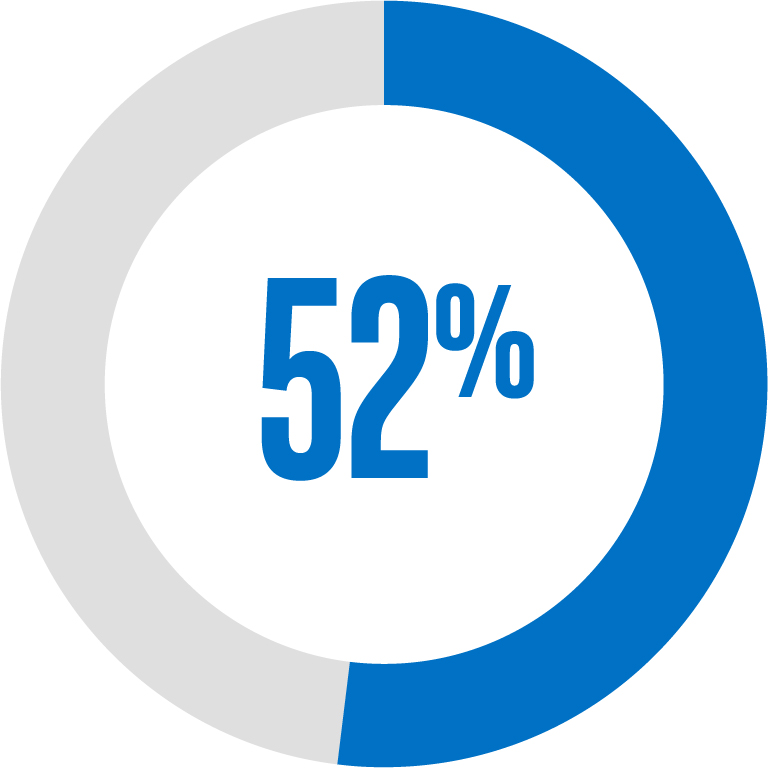 | Includes platforms designed for end-user form factors, focusing on higher growth segments of 2-in-1, thin-and-light, commercial and gaming, and growing adjacencies such as connectivity, graphics, and memory. | |||||
HIGHLIGHTS | OPPORTUNITIES | CHALLENGES | |||||
Our PC-centric business revenue remained flat year over year. We began shipping our 10nm-based 10th generation Intel® CoreTM processors, previously referred to as Ice Lake. These processors feature a new core architecture and are expected to deliver increased graphics performance, AI, and new levels of integrated connectivity for thin-and-light laptops and 2-in-1s. We divested the majority of our 5G smartphone modem business to increase the focus of 5G efforts on the broader opportunity to modernize network and edge infrastructure while retaining critical IP and modem technology. | We are targeting an approximately $70 billion PC-centric revenue TAM1. This expanded portfolio includes markets such as connectivity, graphics, and memory, which enables new opportunities as we innovate through the platform. We launched Project Athena, a multi-year innovation program designed to deliver advanced laptops that meet ambitious key experience indicators in performance, responsiveness, battery life, form factor, and AI. | Our PC-centric business is operating in an increasingly competitive environment and we are focused on executing an annual cadence of leadership products. Strong demand across our product lines, combined with increased capacity consumed by offsetting factors, contributed to tight supply, particularly at the value end of the PC market. We are making additional investments in our manufacturing facilities and working with customers to align demand with available supply. | |||||
1 Source: Intel calculated 2024 TAM derived from industry analyst reports.
 MD&A MD&A | 16 | |
OUR PRODUCTS |
OUR PRODUCTS PROVIDE END-TO-END SOLUTIONS | |

WE HAVE A BROAD PRODUCT PORTFOLIO | |
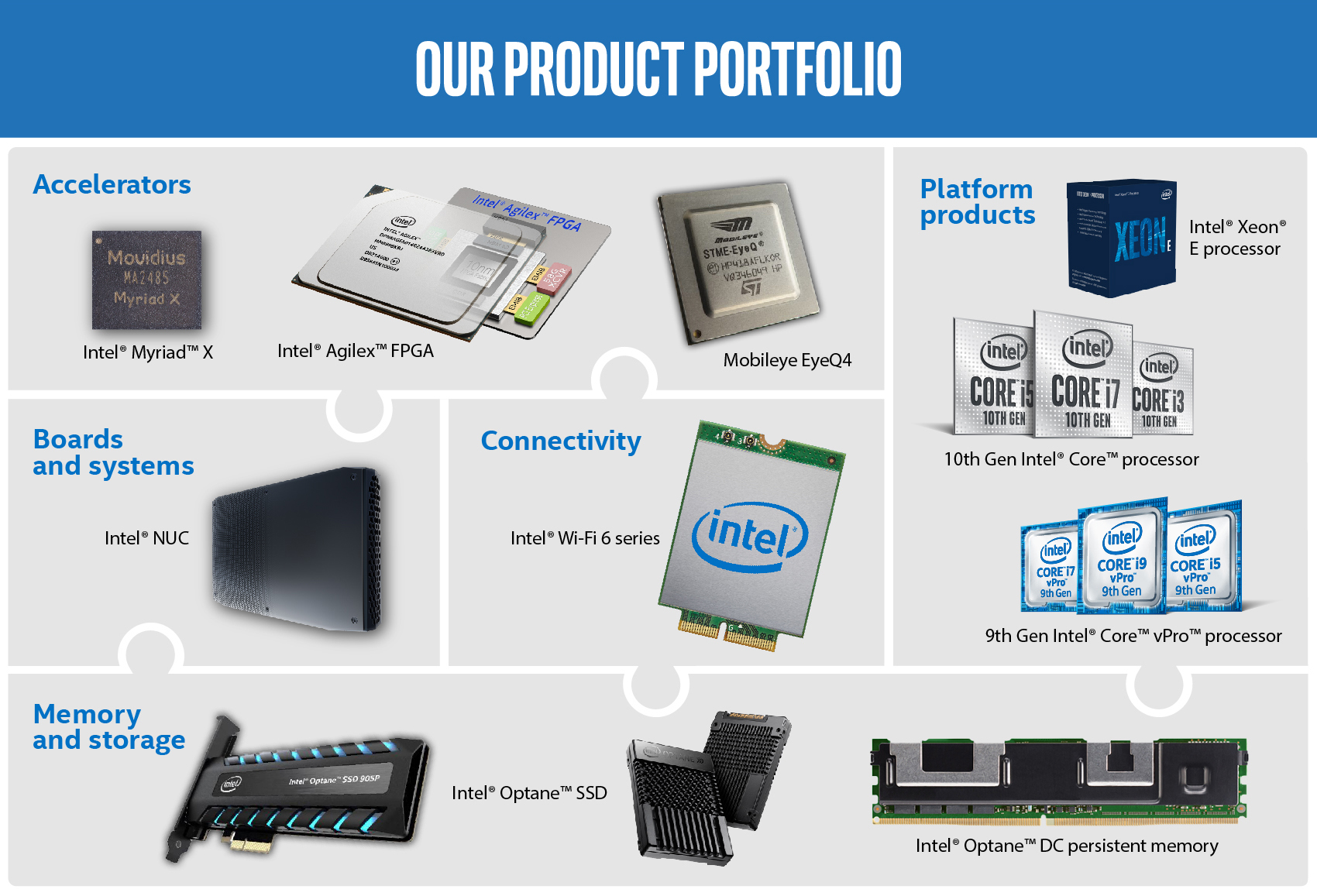
Platform products: Our platform products can be a CPU and chipset, an SoC, or a multichip package, based on Intel® architecture that processes data and controls other devices in a system. These products are primarily used in solutions sold through CCG, DCG, and IOTG.
Adjacent products: Our non-platform, or adjacent products, can be combined with platform products to form comprehensive platform solutions to meet customer needs. These products are used in solutions sold through each of our businesses and include the following:
• | Accelerators - Silicon products that can operate alone or accompany our processors in a system, such as FPGAs, VPUs, and Mobileye EyeQ* SoC |
• | Boards and systems - Server boards and small form factor systems such as Intel® NUCs |
• | Connectivity products - Cellular modems, Ethernet controllers, silicon photonics, Wi-Fi, and Bluetooth® |
• | Memory and storage products - SSD, persistent memory, and memory components |
 MD&A MD&A | 17 | |

OVERVIEW |  | |
DCG develops workload-optimized platforms for compute, storage, and network functions. Market segments include cloud service providers, enterprise and government, and communications service providers. In the first half of 2019, DCG customers, specifically the cloud service providers and enterprise and government market segments absorbed capacity and worked through inventory after a historic customer-driven platform refresh in 2018. As consumption picked back up in the second half of 2019, DCG returned to growth. Continued demand for cloud computing and solutions built for the network and edge fueled growth. | ||
HIGHLIGHTS AND SEGMENT IMPERATIVES | ||
"Our workload-optimized, broad portfolio strategy uniquely enables our customers to move, store, and process the world's data." —Navin Shenoy, Data Platforms Group2 General Manager | ||
● | We delivered sweeping innovation across our data-centric product portfolio, including introduction of the 2nd generation Intel® Xeon® Scalable processor family for the data center, first market introduction of Intel® OptaneTM DC persistent memory, new Intel® Xeon® D processors, and Intel® 800 series Ethernet adapters. | |
● | Adjacent products saw double-digit revenue growth primarily due to Intel® Silicon Photonics and Intel® OptaneTM DC persistent memory. | |
● | DCG has significant opportunities in cloud, networking, AI, and data analytics. As we broadened our product offerings and continued to innovate, the data center market TAM1 is expected to grow to approximately $90 billion by 2024. | |
5-YEAR TRENDS |
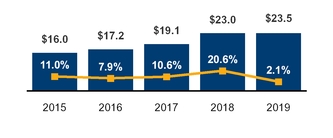
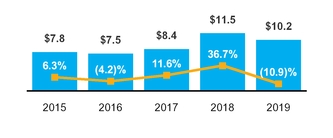
■ Revenue $B | — Year over Year Growth | ■ Op Income $B | — Year over Year Growth | |||
1 Source: Intel calculated 2024 TAM derived from industry analyst reports.
2 Our Data Platforms Group includes our DCG segment. See "Information About Our Executive Officers" within Other Key Information for more details.
 MD&A MD&A | 18 | |
MARKET AND BUSINESS OVERVIEW
Market trends and strategy
Data is a significant force in society, and is being generated at an unprecedented pace. Data center customers want to work with partners who can deliver platforms to address their most important technology challenges. Additionally, as more data is generated, organizations are seeking to analyze data closer to point of origin, giving rise to a data-centric edge environment across industries and providers. We expect the massive growth of data worldwide will increase demand to move, store, and process data and extract value from data. We are one of the few companies that touches every part of the data-centric compute landscape, and we have invested both organically and through acquisitions to capitalize on these demands. We expect these trends to continue to fuel demand in DCG and other data-centric businesses in the long term.

DCG focuses on three market segments: cloud service providers, enterprise and government, and communications service providers. In 2019, cloud revenue grew as service providers continued to invest in infrastructure to meet the explosive demand for digital services, AI, and data analytics. Cloud service provider revenue was down in the first half as customers absorbed capacity and worked through inventory after a historic 2018 platform refresh; this trend stabilized in the second half of 2019. In our enterprise and government market segment, legacy architecture continues to decline on-premise, but enterprises are rapidly embracing cloud as an architecture, and we expect to continue to see growth in hybrid and multi-cloud deployments. In the communications service provider market segment, we gained market segment share as customers chose to virtualize and transform their networks and prepare for the 5G transition using Intel® architecture.
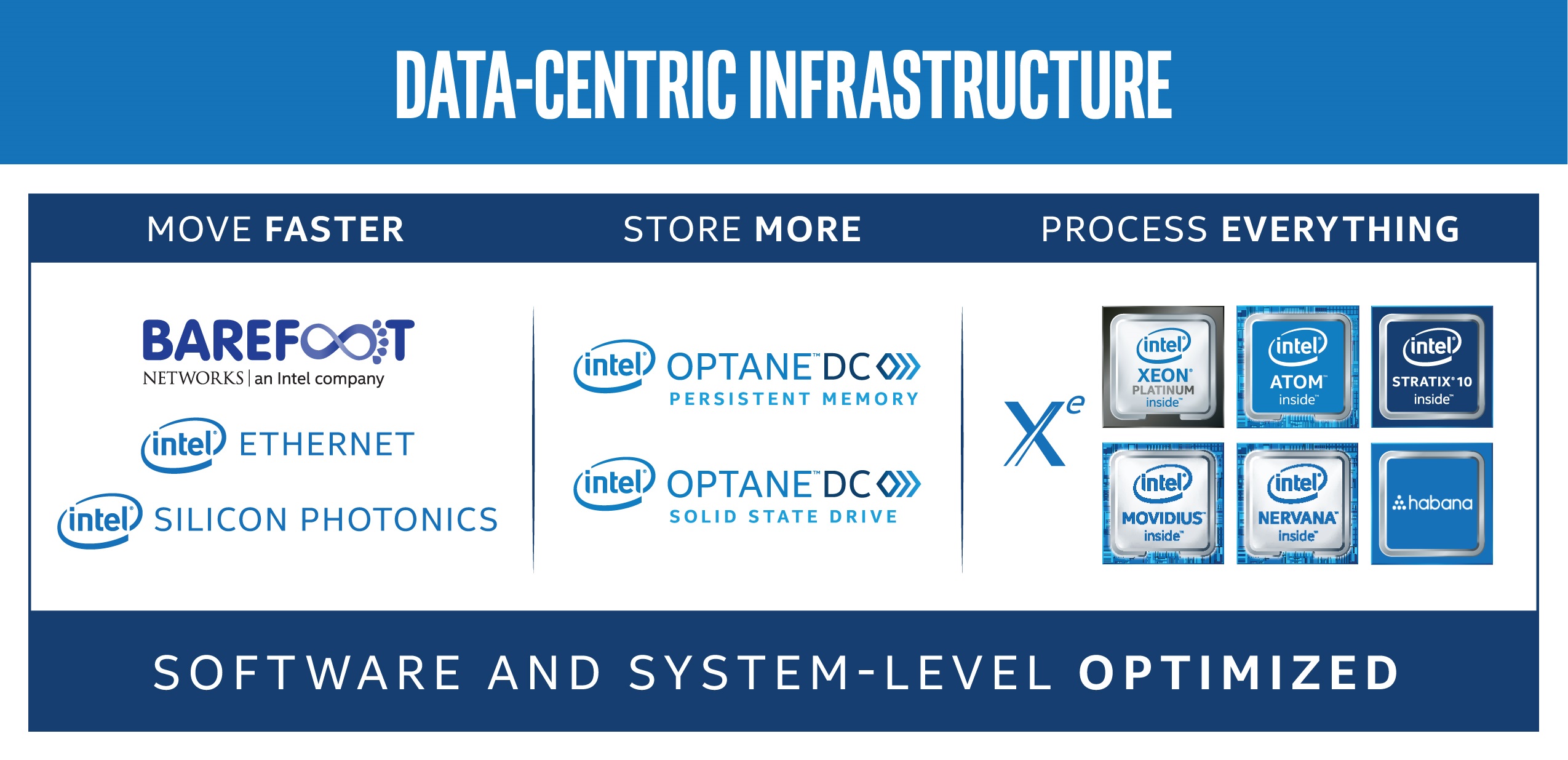
Products and competitiveness
We offer customers an unmatched, broad portfolio of platforms and technologies designed to provide workload-optimized performance across compute, storage, and network. These offerings span the full spectrum from the data center core to the network edge. In addition, DCG focuses on lowering the total cost of ownership and on other specific workload optimizations for the enterprise, cloud service provider, and communications service provider market segments, with hardware-enhanced performance optimizations for AI workloads. DCG's platform value can be extended through Intel adjacent products such as FPGAs and SSDs. As a leading provider of data center platforms, we face competition from competitors such as Advanced Micro Devices, Inc. (AMD), providers of GPU products such as NVIDIA Corporation (NVIDIA), companies using ARM* architecture, new entrants developing products customized for specific data center workloads, and from internally developed solutions by cloud service providers and others. We expect an increasingly competitive environment in 2020.
With over 23 million units shipped to date, the Intel® Xeon® Scalable platform provides the foundation for the data-centric era. In 2019, we launched our 2nd generation Intel® Xeon® Scalable processors, formerly Cascade Lake, which include Intel® Deep Learning Boost. As the industry's only CPUs with built-in AI acceleration, Intel® Xeon® processors can help customers solve challenging problems and gain insight for future opportunities. We also shipped new generations of our Intel® Xeon® D processor product family, designed to deliver improved performance in space- and power-constrained environments. Beyond processing everything, we are enhancing users' digital experiences through continued expansion of adjacent product offerings to store and move data more effectively, such as Intel® OptaneTM DC persistent memory and Intel® 800 series Ethernet adapters.
 MD&A MD&A | 19 | |
FINANCIAL PERFORMANCE
DCG REVENUE $B | DCG OPERATING INCOME $B | |||
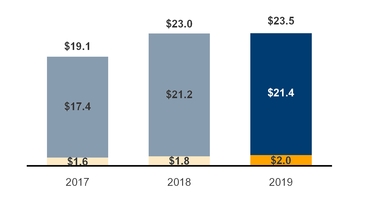
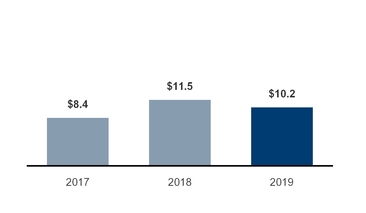
■ Platform | ■ Adjacent | |
REVENUE SUMMARY |
• | Higher platform ASPs from stronger core mix was partially offset by platform volume decline primarily from TAM contraction in the enterprise and government market segment. |
• | Adjacent growth driven by the continued expansion of Intel® Silicon Photonics in 2019. |
• | Comparing 2019 to 2018, revenue from cloud service providers was up 13%, enterprise and government was down 14%, and communications service providers was up 6% (up 40%, up 2%, and up 25%, respectively, comparing 2018 to 2017). |
2019 – 2018 | 2018 – 2017 | ||||||||||||
(Dollars in Millions) | % Growth | $ Impact | % Growth | $ Impact | |||||||||
Platform volume | down | (3)% | $ | (654 | ) | up | 13% | $ | 2,334 | ||||
Platform ASP | up | 5% | 940 | up | 7% | 1,382 | |||||||
Adjacent products | up | 11% | 204 | up | 13% | 211 | |||||||
Total change in revenue | $ | 490 | $ | 3,927 | |||||||||
OPERATING INCOME SUMMARY |
Operating income decreased 11% year over year, and operating margin was 44% in 2019.
(In Millions) | ||||
$ | 10,227 | 2019 Operating Income | ||
(805 | ) | Higher period charges, primarily associated with the initial ramp of 10nm | ||
(510 | ) | Higher operating expenses primarily related to R&D | ||
(140 | ) | Lower gross margin from adjacent businesses | ||
(80 | ) | Higher platform unit cost | ||
370 | Higher gross margin from platform revenue | |||
(84 | ) | Other | ||
$ | 11,476 | 2018 Operating Income | ||
3,445 | Higher gross margin from platform revenue | |||
(350 | ) | Higher platform unit cost | ||
(14 | ) | Other | ||
$ | 8,395 | 2017 Operating Income | ||
 MD&A MD&A | 20 | |

As more intelligence is moving to the edge, more industries are harnessing the power of data to create business value, to innovate, and to grow. We are using our architecture, accelerators, and software assets, combined with scale and partners, to develop a growing Internet of Things portfolio. Our Internet of Things portfolio is comprised of our IOTG and Mobileye businesses. IOTG develops high-performance compute for targeted verticals and embedded markets. Mobileye is the global leader in the development of computer vision and machine learning-based sensing, data analysis, localization, mapping, and driving policy technology for ADAS and autonomous driving.
INTERNET OF THINGS GROUP |
OVERVIEW |  | |
IOTG develops high-performance compute for targeted verticals and embedded markets. Our customers include retailers, manufacturers, healthcare providers, energy companies, automakers, and governments. We facilitate our customers creating, storing, and processing data generated by connected devices to accelerate business transformations. | ||
HIGHLIGHTS AND SEGMENT IMPERATIVES | ||
● | IOTG achieved record revenue and operating income in 2019 on broad business strength and growing demand for edge computing and computer vision-based applications. | |
● | Since 2015, IOTG has had average revenue growth of 14% and operating income growth of 22% per year. | "Intel’s pioneering work in AI and proven data-centric strategy enabled us to predict the massive opportunity of edge computing—years ahead of the industry. Edge is not just a theoretical market opportunity. Together with our ecosystem partners and developers, we’re delivering on this vision today and driving tangible financial results." —Tom Lantzsch, IOTG General Manager |
● | We see significant opportunity for growth driven by an architectural shift toward edge computing, which extends compute from centralized points to be closer to the source inputs. | |
● | We continue to provide updated solutions to accelerate market adoption of computer vision and AI applications. This includes advances in existing offerings such as the OpenVINO™ toolkit, development of the Edge AI Nanodegree* with Udacity to enrich and train the next generation of developers, and the release of Intel® AI DevCloud for the Edge, which allows customers to identify Edge AI solutions that deliver the best mix of performance, power, and price. | |
● | To deliver on the transformative promise of the Internet of Things, we are working with our ecosystem partners to continue to grow the portfolio of Intel® IoT Market Ready Solutions (Intel® IMRS)—scalable, end-to-end solutions that provide solid business results today and lay the foundation for the future. Currently, IOTG has over 170 Intel® IMRS supporting approximately 5,000 new end-to-end deployments in more than 100 countries. | |
 MD&A MD&A | 21 | |
5-YEAR TRENDS |
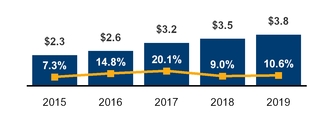
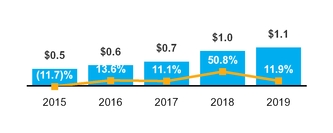
■ Revenue $B | — Year over Year Growth | ■ Op Income $B | — Year over Year Growth | |||||
MARKET AND BUSINESS OVERVIEW
Market trends and strategy
The Internet of Things market sits at the center of a global digital transformation. Through a robust network of devices, software, and sensors, the Internet of Things is transforming the way businesses create products, deliver services, and conduct operations—from schools and hospitals, to retailers and smart factories. Internet of Things-based solutions represent one of the fastest growing segments within the semiconductor industry. However, the Internet of Things is a highly fragmented market with a diverse collection of competitors, products, and vertical segments.
 | Many retailers are sitting on mountains of data that can be used to proactively address evolving customer demands. IOTG provides solutions that enable retailers to extract the right insights from their data, in the right place, at the right time, allowing them to use intelligence to transform their businesses to achieve their full potential. The result is greater efficiency, reduced complexity, increased sales, and a more personalized customer experience. | |||||
As a result of consumer preference for more customization and higher-quality manufactured goods, a new kind of factory is emerging—one that is cloud connected and data driven. It is an “intelligent factory” marked by hyper-agility, autonomous production, and the use of data as a transformative force for the business. | ||||||
We help cities and infrastructure providers turn data into actionable insights to enable smarter, safer, and more efficient solutions. Infrastructure providers and cities are seeking the best ways to use Internet of Things technology to enhance the quality of services, improve public safety, reduce congestion, and achieve new levels of efficiency. | ||||||
By 2022, we expect approximately 82% of data traffic will be video1. Processing high-quality video requires the ability to rapidly analyze vast streams of data near the source and to respond to that data in real time, moving only relevant insights to the cloud. Rather than a one-size-fits-all solution, Intel offers a powerful portfolio of scalable hardware and software solutions, including the OpenVINO™ toolkit and the new Intel® Vision Accelerator Design products, to move into an intelligent, data-powered future and to meet the various performance, power, and price requirements of any business, in any industry. | ||||||
Products and competitiveness
We have a long-standing position as a supplier of components and software for embedded products. This marketplace continues to expand significantly, with increasing types and numbers of smart and connected devices for retail, industrial, and consumer uses, including smart video. As this market segment evolves, we face numerous large and small incumbent processor competitors, as well as new entrants that use the ARM* architecture and other operating systems and software. In addition, the Internet of Things requires a broad range of connectivity solutions and we face competition from semiconductor companies providing traditional wireless solutions such as cellular, Wi-Fi, and Bluetooth®, as well as several new entrants who are taking advantage of new focused communications protocols.
IOTG utilizes platform and adjacent products across Intel while making the investments needed to adapt products to the specific requirements for our vertical segments. We offer end-to-end solutions with our wide spectrum of products, including Intel® Atom®, Intel® Core®, and Intel® Xeon® processor-based computing, wireless connectivity, FPGAs, Movidius VPUs, and developer tools such as the OpenVINO™ software toolkit. IOTG product development focuses on addressing the key challenges businesses face when implementing Internet of Things solutions, including interoperability, connectivity, safety, security, industrial use conditions, and long-life support.
1 Source: Cisco Visual Networking Index: Forecast and Trends, 2017-2022, updated February 27, 2019.
 MD&A MD&A | 22 | |
MOBILEYE |
OVERVIEW |  | |
Mobileye is the global leader in driving assistance and automation solutions. Our product portfolio employs a broad set of technologies, covering computer vision and machine learning-based sensing, data analysis, localization, mapping, and driving policy technology for ADAS and autonomous driving. Mobileye’s ADAS products form the building blocks for higher levels of autonomy. Our customers and strategic partners include major global OEMs and Tier 1 automotive system integrators. | ||
HIGHLIGHTS AND SEGMENT IMPERATIVES | ||
● | We achieved record revenue and operating income in 2019 primarily due to the increased adoption of ADAS. Our EyeQ* SoC volume grew approximately 43% and we expect to see additional growth in the adoption of enhanced ADAS technologies. | “Mobileye is fueling Intel’s entry into the Mobility-as-a-Service business and is fully committed to building on its leadership and know-how in the ADAS market in order to bring truly safe and scalable autonomous mobility to the market.” —Prof. Amnon Shashua, President and Chief Executive Officer, Mobileye |
● | We had more than 30 new design wins, 47 active production programs1 across 25 OEMs, and 16 program launches, including an industry-first 100-degree front-facing camera. | |
● | Production vehicles equipped with our EyeQ*4 SoC and REMTM technology are deployed across the globe and by the end of 2019 were collecting up to approximately 6 million kilometers of data each day. This data is automatically aggregated with high update frequency into "Roadbook™, a high-definition map, which is an essential component for Robotaxi (autonomous taxis), consumer AV, and the fast-growing L2+ segment. The insights gained from this data enhance existing driver-assistance propositions and provide customers with superior driving experiences, performance, and additional safety. | |
MARKET AND BUSINESS OVERVIEW
Market trends and strategy
The adoption of ADAS is expanding as consumers increasingly consider ADAS a differentiating factor in their automotive purchasing decisions. The continued growth of ADAS is dependent on various factors, including regulation, market demand, and consumers' recognition of its value. Mobileye's ADAS solutions also serve as a qualification space for our autonomous technology, using vast experience and proliferation to validate and constantly improve AV technology. AV technologies, in turn, make their way into premium ADAS solutions, broadening monetization opportunities and value proposition. The AV-ADAS interplay allows Mobileye to sustain its technology leadership.
Car manufacturers are looking to enhance current L2+ solutions by improving system fidelity, availability, and performance. High-definition maps with constant updates, global coverage, and various semantic features are a prerequisite for L2+ applications and the future deployment of Robotaxi and passenger car autonomy (Consumer AV). Canonical mapping methods rely on extensive manual labor and dedicated mapping vehicles. Mobileye's disruptive REM crowdsource mapping technology provides automatic map creation and updates. REM mapping capabilities are also being leveraged to extend the value of static and dynamic data to businesses in new market segments such as smart cities and infrastructure surveys.
We believe the future of autonomous driving will unfold in two phases: commercial Robotaxi and series-production passenger car Consumer AV. We expect Consumer AV to materialize only after the Robotaxi industry deploys and matures. The main inhibitors of a mass market product offering of Consumer AV are the cost of AV technology, ability to scale at a low cost, regulation structure, and public acceptance. Thus, we see the Robotaxi phase as a necessary corridor to Consumer AV. Mobileye is well positioned to play a significant role in the broader MaaS market with the commercialization of Robotaxi and the future Consumer AV market. Our full-stack self-driving system—geared with our camera-centric backbone and vast experience in productizing cutting-edge technology in the automotive industry—is the foundation for developing an economically competitive AV solution. Proliferation of data-collection vehicles alongside REM technology will allow for low-cost geographic expansion and coverage. Thus, Mobileye is entering the MaaS market segment as an end-to-end service provider at scale. |  |
1 Intel's definition is included in "Key Terms" within the Financial Statements and Supplemental Details.
 MD&A MD&A | 23 | |
Products and competitiveness
At its core, Mobileye's offering for ADAS and AV is propelled by our computer vision and AI expertise and software assets, deployed on our EyeQ* SoC family. The tight co-design of hardware and software gives the EyeQ* SoC the ability to support complex and computationally intense tasks and sets it apart from competition because it is purpose-fit for high-compute, low-power, automotive-compliant mission profiles. Mobileye’s 5th generation EyeQ*5 SoC is designed to act as the central computer for fully autonomous driving vehicles. Mobileye has been able to achieve power, performance, and cost targets by employing proprietary computational cores that are optimized for a wide variety of computer vision, signal processing, and machine learning tasks, including deep neural networks. Starting with EyeQ*5, Mobileye is supporting an automotive-grade standard operating system and providing a complete software development kit to allow customers to differentiate their solutions by deploying their algorithms on EyeQ*5. The EyeQ*5 SoC will be in final sampling stages in 2020 and is expected to be in commercial vehicles starting in 2021. The EyeQ*5 SoC is already operational in Mobileye’s autonomous test vehicles.
EyeQ*5 serves as the computational foundation for Mobileye’s scalable camera-only surround sensing system. The system consists of multiple independent computer vision engines and deep networks for algorithmic redundancy. The result is a robust and comprehensive model of the environment that allows end-to-end autonomous driving. The surround computer vision system is the backbone of Mobileye’s autonomous vehicle architecture and the flagship offering for next-generation ADAS.
The next significant building block in Mobileye’s complete offering is REM mapping technology, which compiles crowdsourced mapping data from EyeQ* SoC-equipped vehicles. Our REM Roadbook™ offering can enhance current ADAS applications through a variety of advanced features, including predictive adaptive cruise control, lane-level localization in all weather and road conditions, hands-free driving application, and real-time alerts, such as for construction activity and road hazards.
The third building block in Mobileye’s full stack offering is our unique formal model for AV safety (RSS). At its core, RSS is a pragmatic method to design and then to efficiently validate the safety of an AV, serving as the governing safety layer for the decision-making system. RSS formalizes human decision making for safe driving under two main principles: First, it acknowledges the need to balance safety with useful driving by making plausible worst-case scenario assumptions for other road users; and second, it provides a technology-neutral model and a transparent framework for the regulatory endeavor of building an industry standard for safety.
 MD&A MD&A | 24 | |
FINANCIAL PERFORMANCE
INTERNET OF THINGS REVENUE $B | INTERNET OF THINGS OP INCOME $B | |||
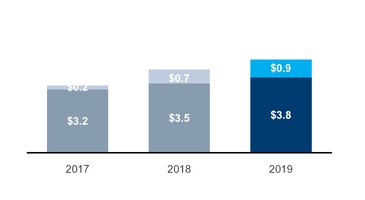

■ IOTG | ■ Mobileye1 | |
REVENUE SUMMARY |
2019 – 2018
IOTG net revenue increased $366 million, or 11%, driven by $283 million higher ASPs from stronger core mix and $92 million higher IOTG platform unit sales, partially offset by lower revenue from our divestiture of Wind River in Q2 2018, which negatively impacted the revenue comparison by approximately $153 million in the first half of 2019. After adjusting for Wind River, IOTG revenue grew $519 million, or 16%, year over year.
Mobileye net revenue was $879 million, up $181 million due to increasing adoption of ADAS.
2018 – 2017
IOTG net revenue increased $286 million, or 9%, driven by $632 million higher IOTG platform unit sales, offset by $212 million mix of platform products sold and $134 million lower adjacent revenue due to the divestiture of Wind River in Q2 2018. After adjusting for Wind River, IOTG revenue grew $447 million, or 16%, year over year. Revenue grew due to strength across the retail, industrial, video, and other market segments.
OPERATING INCOME SUMMARY |
2019 – 2018
IOTG operating income increased $117 million primarily due to higher platform revenue from stronger core mix offset by higher period charges related to reserves taken on legacy products.
Mobileye operating income was $245 million, up $102 million driven by growth in revenue partially offset by higher spending.
2018 – 2017
IOTG operating income increased $330 million due to higher revenue and lower spending as we reprioritized investments within the automotive business and Wind River.
1 Mobileye was acquired in Q3 2017; 2017 figures do not represent full-year results.
 MD&A MD&A | 25 | |
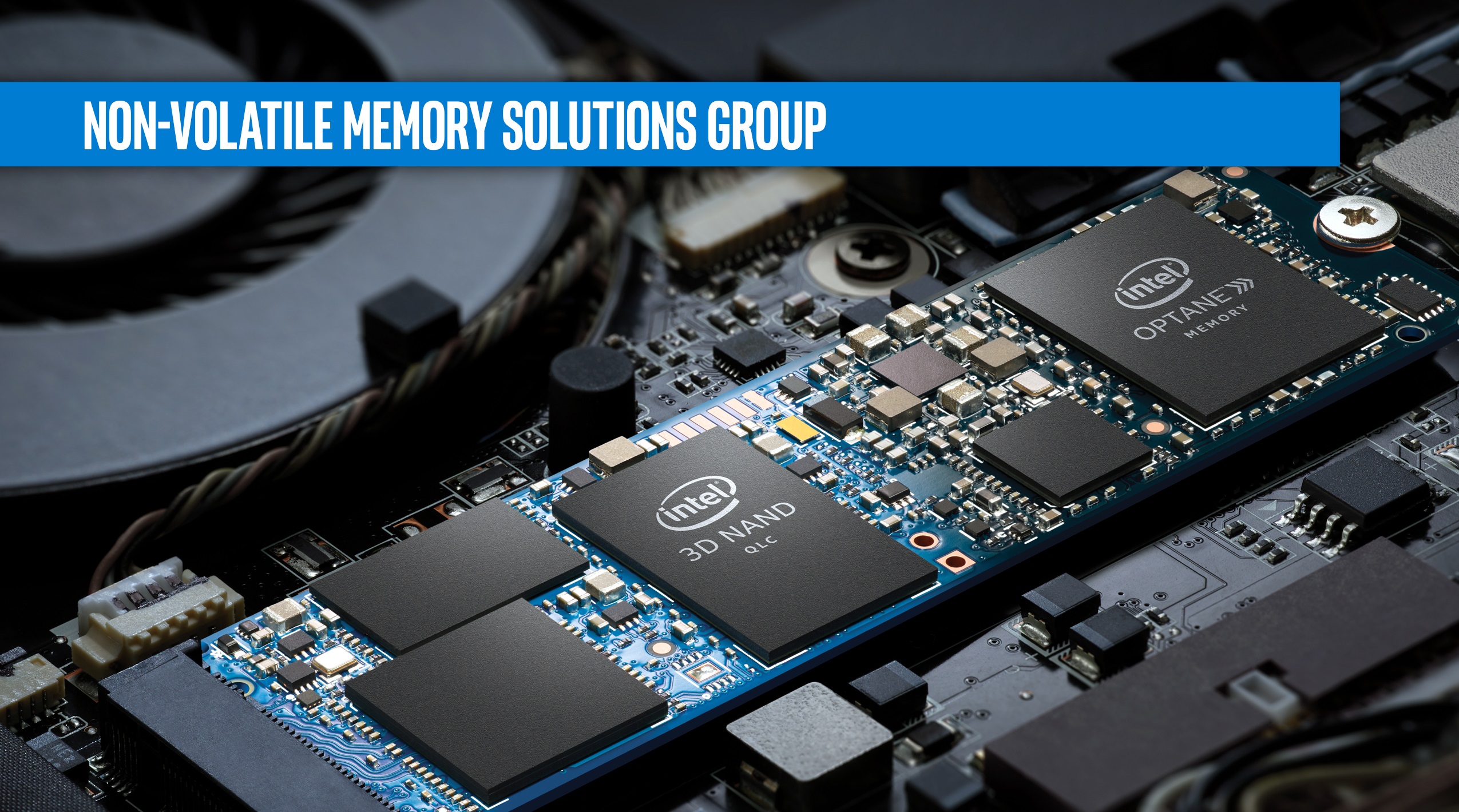
OVERVIEW |  | |
NSG is a technology leader in next-generation memory and storage products based on breakthrough Intel® Optane™ technology and Intel® 3D NAND technology. NSG is disrupting the memory and storage hierarchy with new tiers that balance capacity, performance, and cost. We offer 64-layer TLC and QLC NAND high-capacity SSDs, and unparalleled low latency and high performance with Intel® Optane™ technology—both available in innovative new form factors and densities to address the memory and storage challenges our customers face in a rapidly evolving technological landscape. Our customers include enterprise and cloud-based data centers, and users of business and consumer desktops and laptops. | ||
HIGHLIGHTS AND SEGMENT IMPERATIVES | “The world is generating data at an accelerating rate, and businesses are increasingly becoming overwhelmed with how to efficiently process it. Harvesting value from all this data will be critical in separating the winners from losers. It will require cutting-edge innovation in the memory-and-storage hierarchy, which is what we are driving at Intel.” —Rob Crooke, NSG General Manager | |
● | We achieved record revenue in 2019 driven by storage and memory bit TAM1 growth, despite significant NAND market pricing pressure. We are taking steps to improve NAND profitability. | |
● | We launched Intel® Optane™ memory H10 with Solid State Storage, the first to deliver responsiveness and capacity for the PC with the combination of Intel® Optane™ memory and Intel® QLC 3D NAND technology for thin-and-light notebooks and space-constrained platforms. | |
● | We launched the Intel® Optane™ SSD DC D4800X, the first dual-port SSD with Intel® Optane technology with redundant data paths for data availability, and industry-leading combination of high throughput and low latency for mission-critical enterprise storage solutions. | |
● | Our product roadmap includes our next generation of Intel® Optane™ DC persistent memory and our 2nd generation Intel® Optane™ SSD, which are being developed in the new center of Intel® Optane technology advancement at Intel’s Fab 11x in New Mexico. | |
5-YEAR TRENDS |
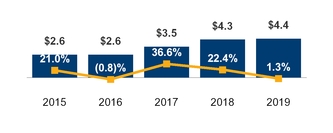
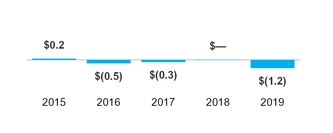
■ Revenue $B | — Year over Year Growth | ■ Op Income $B | ||||
1 Source: Intel calculated TAM growth derived from industry analyst reports.
 MD&A MD&A | 26 | |
MARKET AND BUSINESS OVERVIEW
Market trends and strategy
As a result of the combination of ever-exploding growth in data and the desire to analyze data for actionable insights, our customers are faced with balancing performance and real-time access and cost. Our technology innovations enable various tiers of memory and storage to ensure that critical, or "hot," data is close to the CPU for rapid access to larger data sets with Intel® Optane™-based products and efficient cost-effective capacity storage with Intel® 3D NAND TLC and QLC technology.
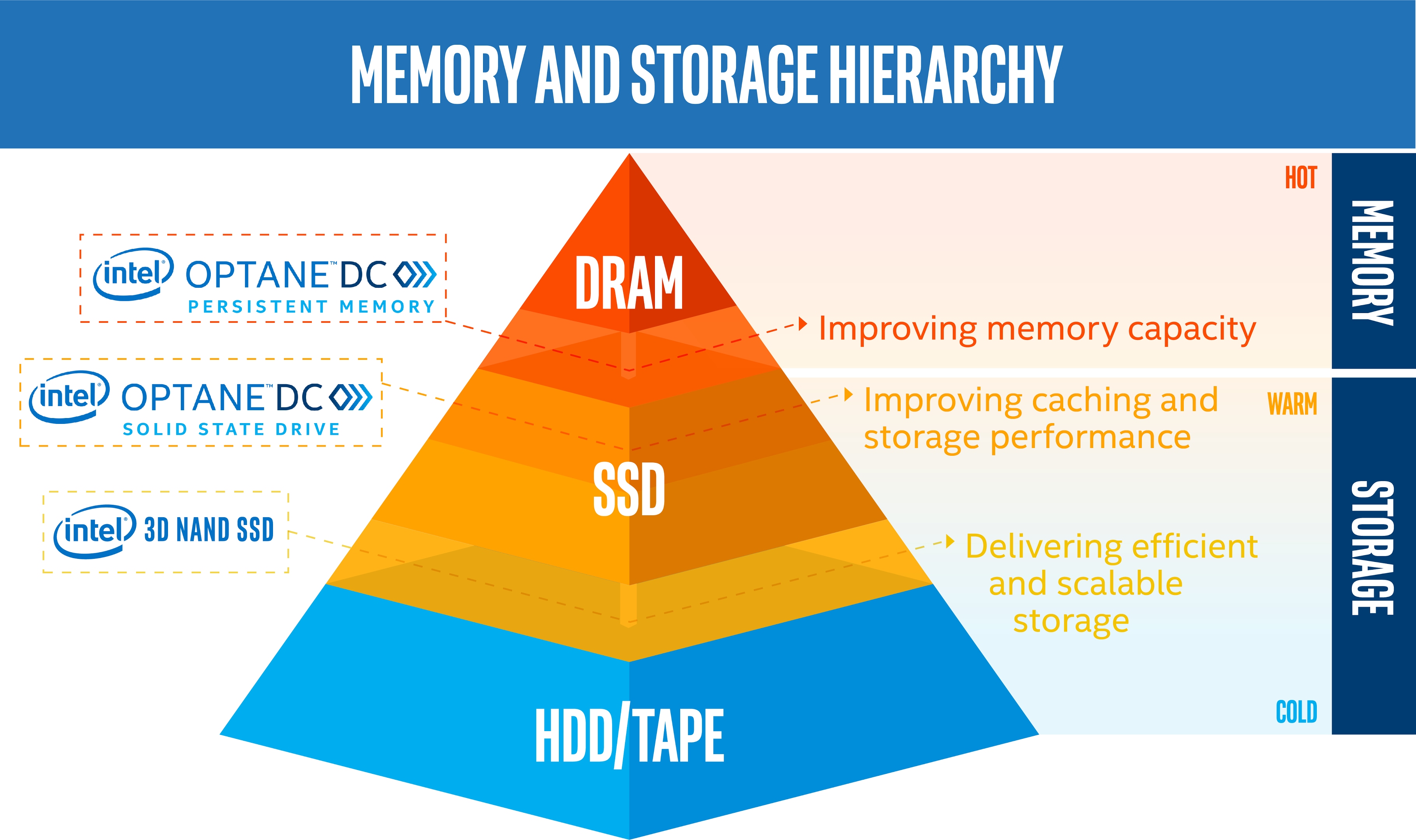
Non-volatile memory bit TAM1 grew 40% in 2019 as significant increases in storage and memory technologies were required to meet customer needs. Conversely, revenue TAM contracted 23% year over year due to an over-inventoried market through the first half of 2019. Our focus continues to be within the high-performance compute, financial services, cloud service provider, and Internet usage market segments.
Products and competitiveness
We compete against other providers of NAND flash memory products. We focus our efforts primarily on incorporating NAND flash memory into solution products and on our innovative Intel® Optane™ technology, which offers a unique combination of performance, density, power, non-volatility, and cost advantages that redefines the memory storage hierarchy between conventional DRAM memory and NAND. We believe that our memory offerings, including our Intel® Optane™ technology, complement our product offerings in our other segments.
The acceleration in data growth across our customer base requires significant innovation in storage and memory technology. Our storage and memory roadmap led the way in re-imagining usages and architecting innovative solutions that have disrupted the industry with 64-layer 3D NAND TLC and QLC solutions. We launched five new products to keep up with the evolving business needs of our customers. These new products have driven our 64-layer products to be more than 90% of 2019 NSG volume and we have seen a meaningful ramp in the Intel® Optane™ technology business.
In 2019 we launched our line of Intel® Optane™ DC persistent memory products, available for 2nd generation Intel® Xeon® processor platforms for data center usages. This technology redefines the memory storage hierarchy and offers the performance of memory with the large capacities and persistence characteristics of storage. We are also leading the way in delivering responsiveness and capacity to the latest generation PCs with the industry’s first drive to combine Intel® Optane™ memory and Intel® QLC 3D NAND technology. This new technology will enable innovative new form factors and higher capacity drives.
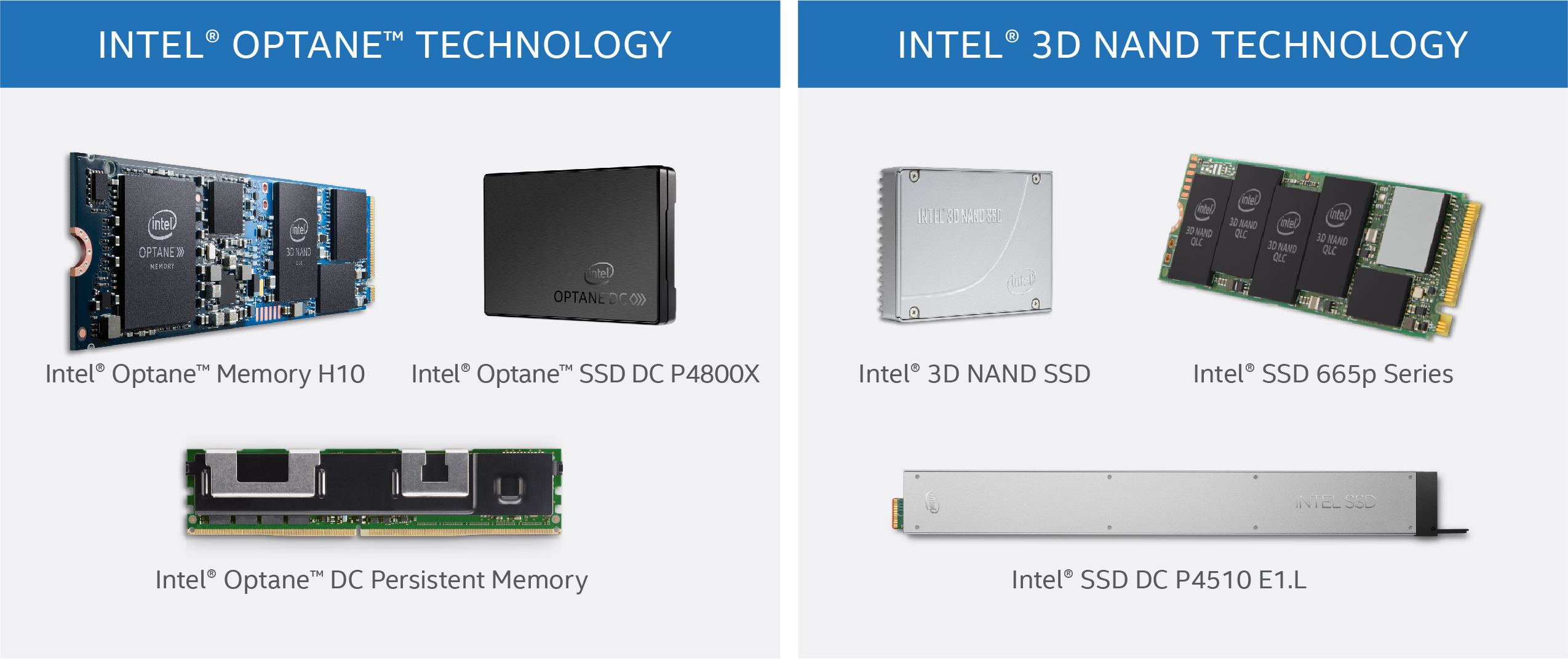
1 Source: Intel calculated TAM growth derived from industry analyst reports.
 MD&A MD&A | 27 | |
FINANCIAL PERFORMANCE
NSG REVENUE $B | NSG OPERATING INCOME $B | |||
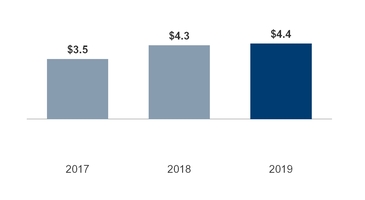
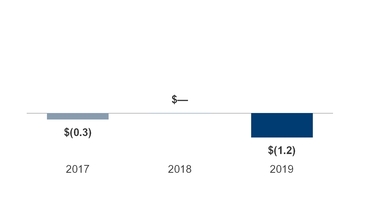
REVENUE SUMMARY |
2019 – 2018
Net revenue increased $55 million, driven by a $3.9 billion increase in unit sales due to an increase in demand for NAND products, offset by a $3.8 billion impact from lower ASP due to lower NAND market pricing.
2018 – 2017
Net revenue increased $787 million, driven by a $2.6 billion increase in unit sales due to strong demand in data center and client SSD and the ramp of Intel® Optane™ technology products, partially offset by $1.8 billion lower ASP due to NAND market pricing weakness and mix of products sold.
OPERATING INCOME SUMMARY |
NSG had an operating loss of $1.2 billion, down from an operating loss of $5 million in 2018. The operating loss was driven by $3.8 billion lower ASPs, partially offset by $1.6 billion of improved unit cost and $1.1 billion higher unit sales. While we continued to see the ramp at Fab 68 drive cost improvements, the decline in ASP and the absence of $160 million in government grants recognized in Q3 2018 more than offset improved unit cost, resulting in lower gross margin.
2018 – 2017
Operating income improved $255 million as our sales mix shifted to our latest 64-layer NAND and we continued to see the cost ramp at Fab 68. The improved unit costs and higher unit sales more than offset the decline in ASP. In addition, we had a total of $160 million earned government grants benefiting 2018.
 MD&A MD&A | 28 | |

OVERVIEW |  | |
PSG offers programmable semiconductors, primarily FPGAs, structured ASICs, and related products, for a broad range of market segments, including communications, data center, industrial, and military. The PSG product portfolio delivers FPGA acceleration in tandem with Intel microprocessors and enables Intel to combine the benefits of its broad portfolio of technologies to allow more flexibility for systems to operate with increased efficiency and higher performance. | ||
HIGHLIGHTS AND SEGMENT IMPERATIVES | ||
● | PSG revenue was down 6% year over year driven by a decline in our cloud and enterprise market segment, partially offset by strength in wireless and advanced products. | "Intel FPGAs and structured ASICs accelerate key workloads on Intel-based platforms and provide the flexibility and agility that enable our customers to innovate and adapt to changing requirements with highly customized hardware and software solutions.” —David Moore, PSG General Manager |
● | We announced the new 10nm Intel® AgilexTM FPGA family that will offer customers application-specific optimization and customization to bring new levels of flexibility and agility to data-intensive infrastructure. We began shipping engineering samples to customers. | |
● | We extended our Intel® Stratix® 10 FPGA and Intel® Programmable Acceleration Card (Intel® PAC) families, which deliver new technology innovations and enable further synergy with Intel’s complete portfolio, including support for Intel® Ultra Path Interconnect (Intel® UPI) and a controller for Intel® Optane™ technology to enable coherent memory and memory expansion with Intel® Xeon® Scalable processors and other Intel products. | |
● | PSG’s FPGA technology and structured ASIC technology play an important role in Intel’s portfolio and platform strategy, enabling acceleration and programmability for customers in all data-focused markets. | |
4-YEAR TRENDS |
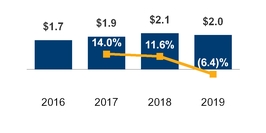
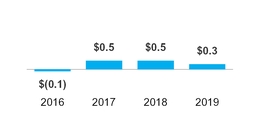
■ Revenue $B | — Year over Year Growth | ■ Op Income $B | ||||
 MD&A MD&A | 29 | |
MARKET AND BUSINESS OVERVIEW
Market trends and strategy
With the rise of pervasive connectivity and autonomous transactions, vast networks of devices and systems are linked from the edge through infrastructure to the cloud. The Intel® FPGA portfolio enables this transformation with discrete FPGAs and software-defined, hardware-based, multi-function acceleration cards that allow faster development times, high performance, and power efficiency with lower overall total cost of ownership.
PSG enables a broad range of solutions targeting the data center, wireless, networking, military, medical, and industrial market segments. The configurability and efficiency of FPGAs provide advantages to enable transformative applications such as 5G wireless, network function virtualization acceleration, and edge acceleration for video analytics and Industry 4.0. At the edge, where systems ingest large amounts of data, Intel® FPGAs are ideal for pre-processing data to accelerate Intel processors. In the network, where data traffic is increasing and network functions are being virtualized to improve transport efficiency, Intel® FPGAs are built to deliver high-bandwidth aggregation and processing. In the cloud, where workloads shift dynamically and algorithms change, Intel® FPGAs are the ideal solution for adapting to new demands through reconfigurability.
Products and competitiveness
PSG delivers solutions in the PLD market, primarily FPGAs and structured ASICs, to accelerate applications that help secure, power, and connect billions of devices and the infrastructure of the smart, connected, data-centric world. We face competition from other programmable logic companies, as well as companies that make other types of semiconductor products, such as ASICs, application-specific standard products, GPUs, digital signal processors, and CPUs. Targeted growth areas for our programmable solutions include communications, data center, industrial, and military applications. The FPGA life cycle is long relative to other Intel products. It generally takes three or more years from the time that a design win is secured before a customer starts volume production and we receive the associated revenue.
PSG continues to invest in the Intel® eASIC™ silicon portfolio of structured ASICs. These products serve as an intermediary technology between FPGAs and standard-cell ASICs that provides lower unit cost and lower power compared to FPGAs, and faster time-to-market and lower non-recurring engineering cost compared to standard-cell ASICs. Intel® eASIC™ products have growth opportunities through adoption in 5G applications and scale across a wide range of markets.
PSG expanded its FPGA silicon portfolio by offering additional capability with the Intel® Stratix® 10 FPGA family and by introducing the brand-new Intel® Agilex™ FPGA family. The Intel® Agilex™ FPGA family combines FPGA fabric built on Intel’s 10nm process with innovative heterogeneous 3D SiP technology, which provides the capability to integrate analog, memory, custom computing, custom I/O, and Intel® eASIC™ device tiles into a single package with the FPGA fabric. Intel® Agilex™ FPGAs began shipping to early access program customers. PSG also expanded its Intel® PAC portfolio with the introduction of the Intel® PAC N3000 and Intel® PAC D5005. The Intel® PAC portfolio, complete with an acceleration software stack, enables customers to plug cards directly into an Intel® Xeon® processor-based server for application accelerations in markets such as 5G, finance, genomics, video transcoding, and database acceleration. | 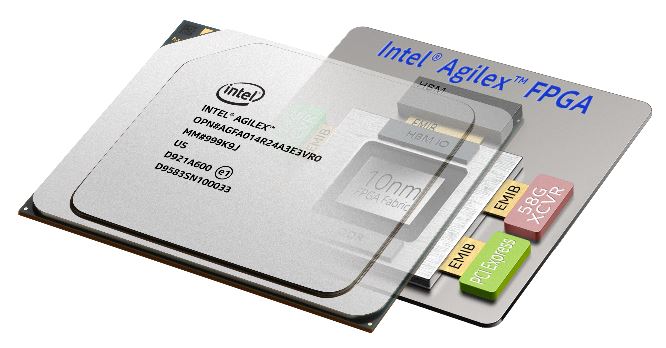 |
 MD&A MD&A | 30 | |
FINANCIAL PERFORMANCE
PSG REVENUE $B | PSG OPERATING INCOME $B | |||
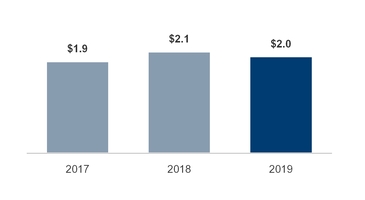
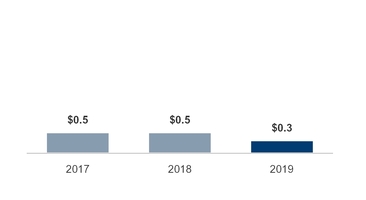
REVENUE SUMMARY |
2019 – 2018
Revenue decreased $136 million, driven by a decline in our cloud and enterprise market segment, offset by strength in wireless and advanced products.
2018 – 2017
Revenue increased $221 million, driven by growth in the data center market segment and our advanced products (28nm, 20nm, and 14nm process technologies), which grew approximately 60% from 2017.
OPERATING INCOME SUMMARY |
2019 – 2018
Operating income decreased $148 million, driven by lower revenue in our cloud and enterprise market segment, offset by strength in wireless and advanced products.
2018 – 2017
Operating income was flat year over year, at $466 million. Revenue increased from the growth in the data center and advanced products, but was offset by higher costs from an unfavorable product mix and increased investments.
 MD&A MD&A | 31 | |
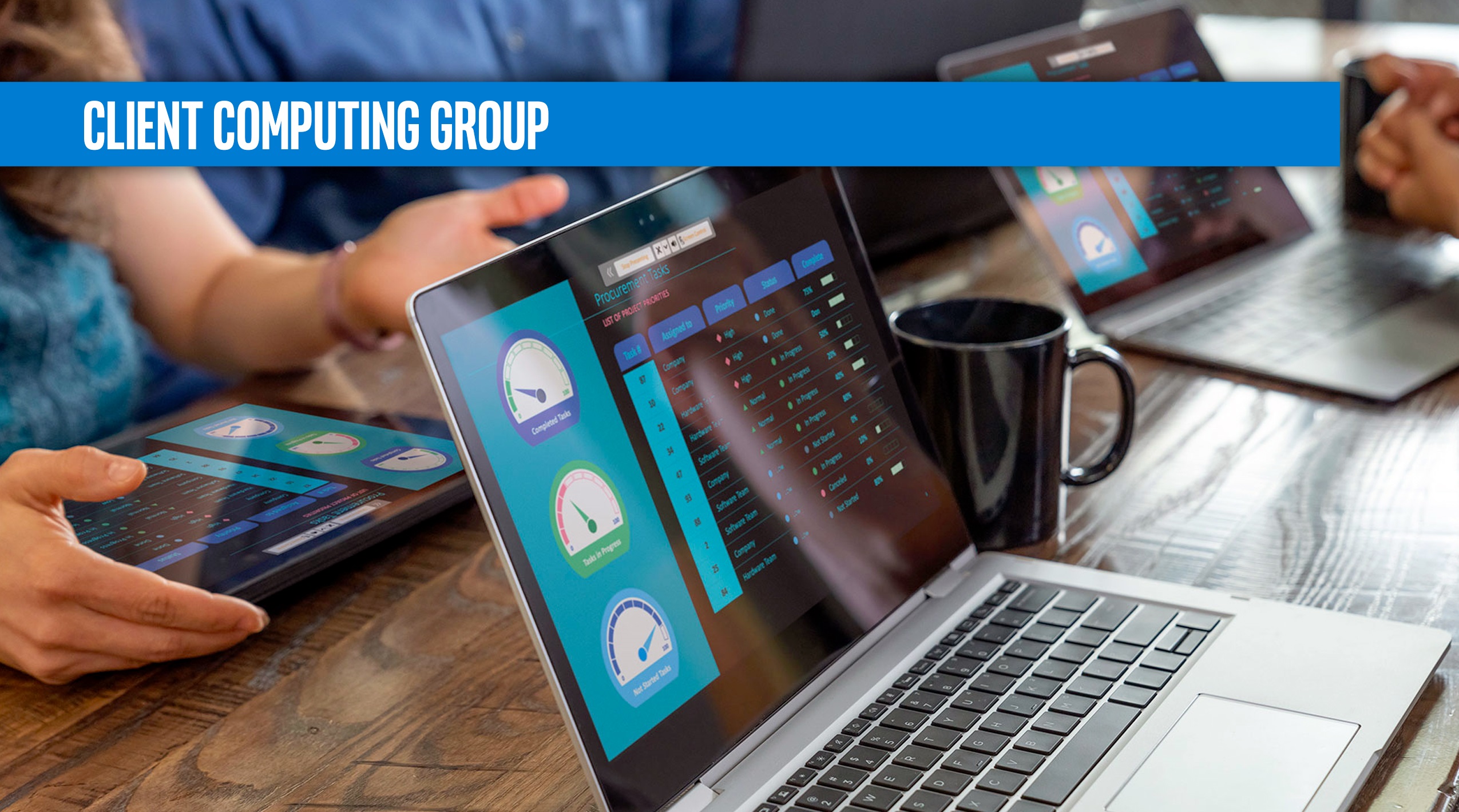
OVERVIEW |  | |
As we evolve to deliver leading end-to-end products across architectures and workloads for the data explosion, CCG’s contribution is the human touchpoint of this new data-centric era—the PC. As the largest business unit at Intel, CCG deploys platforms that connect people to data, allowing each person to focus, create, and engage in ways that unlock their individual potential. The PC market remains a critical facet of our business, providing an important source of IP, scale, and cash flow. Our mission is to continue to deliver leadership products in our PC business as well as our adjacent businesses. | ||
HIGHLIGHTS AND SEGMENT IMPERATIVES | ||
● | We delivered our fourth consecutive year of revenue growth and record operating profit as we managed through supply constraints. We maintained focus on high-growth segments and disciplined portfolio management. Since 2015, we have increased profitability by 86%. | "I believe we can transform the PC into a platform that powers every person's greatest contribution by enabling them to focus, create, and engage in more meaningful ways." —Gregory Bryant, CCG General Manager |
● | Delivering an annual cadence of leadership products is foundational to our business. This year, we introduced our 10th Gen Intel® Core™ processor-based systems built on 10nm process technology and launched our new 9th Gen Intel® Core™ vPro® processors. | |
● | We are accelerating the pace of innovation to deliver new experiences and form factors. We launched Project Athena, a multi-year innovation program, designed to deliver advanced laptops. | |
● | We exited the 5G smartphone modem business, while continuing to meet current customer commitments for our existing 4G modem product lines. We are also assisting OEM partners in the development, certification, and support of 5G modem solutions for PCs. | |
5-YEAR TRENDS |
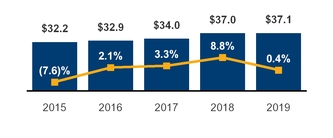
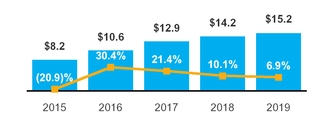
■ Revenue $B | — Year over Year Growth | ■ Op Income $B | — Year over Year Growth | |||
 MD&A MD&A | 32 | |
MARKET AND BUSINESS OVERVIEW
Market trends and strategy
Overall market conditions continue to improve, but we are operating in an increasingly competitive market. With continued investment in product and process technology, and in partnership with our customers, we are delivering platform innovation across several key vectors. We were supply constrained particularly at the value-end of the market as higher than expected PC demand outpaced our supply. We made capacity investments to improve our supply throughout the year, increasing our second-half PC CPU supply by double digits compared with the first half of this year. Supply remains tight in our PC business, where we are operating with limited inventory buffers.
 |  |  |
Products and competitiveness
We are accelerating the pace of innovation and delivering an annual cadence of leadership products, including for modern notebooks and high-end enthusiast PCs. We deliver value to our customers by leveraging our engineering capabilities and working with our partners to deliver technology across every major vector of the computing experience, including performance, battery life, connectivity, memory, graphics, and form factors to create the most advanced PC platforms.
We introduced our 10th Gen Intel® Core™ processor, previously referred to as Ice Lake, a highly integrated new CPU core architecture with new Gen11 graphics, first integrated Wi-Fi6 (11AX) and Thunderbolt™ 3 connectivity, and Intel® Deep Learning Boost. Built on Intel’s advanced 10nm process technology, these processors deliver increased graphics performance, AI, and new levels of integrated connectivity for thin-and-light laptops and 2-in-1s. Further, they give our OEM partners the freedom to innovate on design and aesthetic by reducing the silicon footprint while still delivering the latest standards and world-class performance.
We also expanded our 9th Gen family with 14 new Intel® Core™ vPro® processors for high-performance mobile and desktop PCs, bringing the Intel® Core™ i9 processor to the best-for-business platform for the first time. We launched Intel® Xeon® E workstation processors with up to eight cores, 16 threads, 5-GHz turbo frequency, Wi-Fi 6 (Gig+), Intel® Optane™ memory; and delivered a special edition i9-9900KS desktop SKU, with 5-GHz all-core turbo and Intel® Performance Maximizer.
In May 2019, we launched our multi-year innovation program, Project Athena, with more than 20 verified devices on shelves in time for the holiday season. These devices meet the criteria of our Project Athena 1.0 specification, and are tested and verified in Intel labs to ensure they deliver new experience targets or key experience indicators defined by real-world usage models and innovation across six areas: instant action, performance and responsiveness, intelligence, battery life, connectivity, and form factor.
Our platform products continue to be enhanced by new adjacent technologies. We launched the Wi-Fi6 11X connectivity solution, the first Wi-Fi6 solution in the PC market, featuring faster speeds, increased throughput, and better experiences. We are driving new industry standards for USB-C connector-based products with Thunderbolt™ 3. In addition, we are delivering a new level of performance and high-capacity storage with Intel® Optane™ memory H10 with Solid State Storage to enable enhanced SSD experiences.
Our advanced pace of innovation is more important than ever as we are operating in an increasingly competitive market. We face strong competition from AMD, as well as vendors who use applications processors based on ARM* architecture, such as Qualcomm Inc. (Qualcomm), and customers who internally develop their own semiconductors. We are expecting an increasingly competitive environment in 2020.
 MD&A MD&A | 33 | |
FINANCIAL PERFORMANCE
CCG REVENUE $B | CCG OPERATING INCOME $B | |||
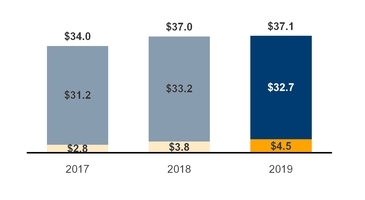
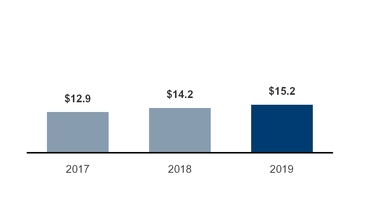
■ Platform | ■ Adjacent | |
REVENUE SUMMARY |
• | Decreased unit sales due to supply constraints particularly at the value-end of the market, and lower market share. |
• | Increased demand for performance products drove strong product mix and higher ASP as the commercial market segment remained strong. |
• | Strength in modem drove higher adjacent revenue. |
2019 – 2018 | 2018 – 2017 | |||||||||||||
(Dollars in Millions) | % | $ Impact | % | $ Impact | ||||||||||
Desktop platform volume | down | (6)% | $ | (705 | ) | down | (6)% | $ | (608 | ) | ||||
Desktop platform ASP | up | 3% | 307 | up | 11% | 1,181 | ||||||||
Notebook platform volume | down | (5)% | (1,080 | ) | up | 4% | 839 | |||||||
Notebook platform ASP | up | 5% | 929 | up | 3% | 677 | ||||||||
Adjacent products and other | 691 | 912 | ||||||||||||
Total change in revenue | $ | 142 | $ | 3,001 | ||||||||||
OPERATING INCOME SUMMARY |
Operating income increased 7% year over year, and operating margin was 41% in 2019.
(In Millions) | ||||
$ | 15,202 | 2019 Operating Income | ||
1,425 | Lower period charges primarily due to lower factory start-up costs and sell-through of previously reserved non-qualified platform product associated with our 10nm process technology | |||
725 | Lower operating expenses primarily driven by lower investment in modem | |||
(1,170 | ) | Higher platform unit cost | ||
(145 | ) | Lower gross margin from platform revenue | ||
145 | Other | |||
$ | 14,222 | 2018 Operating Income | ||
2,080 | Higher gross margin from platform revenue | |||
235 | Lower operating expenses | |||
(690 | ) | Higher platform unit cost due to increased mix to performance products | ||
(225 | ) | Higher period charges, primarily due to reserved non-qualified platform product as we ramp 10nm | ||
(97 | ) | Other | ||
$ | 12,919 | 2017 Operating Income | ||
 MD&A MD&A | 34 | |
CONSOLIDATED RESULTS OF OPERATIONS |
Our transformation to a data-centric company continued in 2019 as we experienced strong demand and reached critical product milestones. Most of our segments experienced continued growth with record total revenue for the fourth year in a row.
Years Ended (In Millions, Except Per Share Amounts) | December 28, 2019 | December 29, 2018 | December 30, 2017 | ||||||||||||||||||
Amount | % of Net Revenue | Amount | % of Net Revenue | Amount | % of Net Revenue | ||||||||||||||||
Net revenue | $ | 71,965 | 100.0 | % | $ | 70,848 | 100.0 | % | $ | 62,761 | 100.0 | % | |||||||||
Cost of sales | 29,825 | 41.4 | % | 27,111 | 38.3 | % | 23,663 | 37.7 | % | ||||||||||||
Gross margin | 42,140 | 58.6 | % | 43,737 | 61.7 | % | 39,098 | 62.3 | % | ||||||||||||
Research and development | 13,362 | 18.6 | % | 13,543 | 19.1 | % | 13,035 | 20.8 | % | ||||||||||||
Marketing, general and administrative | 6,150 | 8.5 | % | 6,750 | 9.5 | % | 7,452 | 11.9 | % | ||||||||||||
Restructuring and other charges | 393 | 0.5 | % | (72 | ) | (0.1 | )% | 384 | 0.6 | % | |||||||||||
Amortization of acquisition-related intangibles | 200 | 0.3 | % | 200 | 0.3 | % | 177 | 0.3 | % | ||||||||||||
Operating income | 22,035 | 30.6 | % | 23,316 | 32.9 | % | 18,050 | 28.8 | % | ||||||||||||
Gains (losses) on equity investments, net | 1,539 | 2.1 | % | (125 | ) | (0.2 | )% | 2,651 | 4.2 | % | |||||||||||
Interest and other, net | 484 | 0.7 | % | 126 | 0.2 | % | (349 | ) | (0.6 | )% | |||||||||||
Income before taxes | 24,058 | 33.4 | % | 23,317 | 32.9 | % | 20,352 | 32.4 | % | ||||||||||||
Provision for taxes | 3,010 | 4.2 | % | 2,264 | 3.2 | % | 10,751 | 17.1 | % | ||||||||||||
Net income | $ | 21,048 | 29.2 | % | $ | 21,053 | 29.7 | % | $ | 9,601 | 15.3 | % | |||||||||
Earnings per share - Diluted | $ | 4.71 | $ | 4.48 | $ | 1.99 | |||||||||||||||
 MD&A MD&A | 35 | |
REVENUE
Compared to a year ago, data-centric revenue was up 3%, driven by a strong mix of high-performance product sales in the second half of 2019, partially offset by TAM contraction in the DCG enterprise and government market segment and continued pressure on NAND pricing. Our PC-centric business was flat, driven by a strong mix of higher performance products as the commercial segment of the PC market remained strong, and modem continued to grow, offset by lower year over year platform volume.
Our total revenue grew from $55.4 billion in 2015 to $72.0 billion in 2019, representing 7% CAGR. Data-centric businesses collectively grew faster than Intel as a whole at 11% CAGR over the last five years, and are approaching 50% of our revenue.
PC TO DATA-CENTRIC TRANSFORMATION OVER THE LAST 5 YEARS |
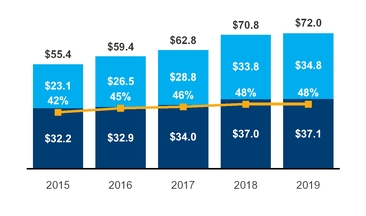
■ PC-centric $B | ■ Data-centric $B | — Data-centric as a % of total Intel revenue | ||
SEGMENT REVENUE WALK $B |

2019 – 2018
In 2019, revenue was $72.0 billion, up $1.1 billion, or 2%, from 2018. Our data-centric businesses collectively grew 3% year over year and made up nearly half of our total revenue in 2019. Platform ASPs increased due to stronger core mix offset by a decline in NSG ASPs due to lower NAND market pricing and a decrease in DCG platform unit sales as the enterprise and government market segment contracted. Our PC-centric business was flat year over year as ASP strength from richer commercial segment mix and modem growth were offset by declines in platform volume.
2018 – 2017
In 2018, revenue was $70.8 billion, up $8.1 billion, or 13%, from 2017. The increase in revenue was primarily driven by strong performance across our data-centric businesses, which collectively grew 18% year over year and made up nearly half of our total revenue in 2018. Our Mobileye business had revenue of $698 million. Our PC-centric business grew 9%, above our expectations, due to PC TAM1 growth and demand for our leadership products. The increase in 2018 revenue was partially offset by the loss of revenue from businesses that were divested, specifically $534 million from the divestiture of the ISecG and approximately $165 million from the divestiture of Wind River.
1 Source: Intel calculated PC TAM derived from industry analyst reports.
 MD&A MD&A | 36 | |
GROSS MARGIN
We derived most of our overall gross margin dollars from the sale of platform products in the DCG and CCG operating segments. Our overall gross margin dollars in 2019 decreased by $1.6 billion, or 4%, compared to 2018, and in 2018 increased by $4.6 billion, or 12%, compared to 2017. In 2019, our adjacent products revenue continued to grow primarily due to memory and modem products, which have a lower gross margin percentage than our overall average. Lower platform unit sales and margin compression on memory products resulted in lower gross margins, which were partially offset by platform ASP strength.
GROSS MARGIN $B |
(Percentages in chart indicate gross margin as a percentage of total revenue) |
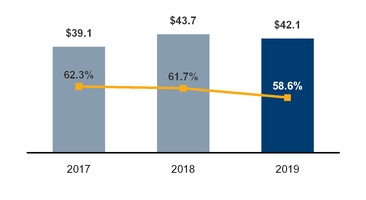
(In Millions) | ||||
$ | 42,140 | 2019 Gross Margin | ||
(1,360 | ) | Lower gross margin from adjacent businesses primarily due to NAND, DCG adjacencies, and PSG offset by higher gross margin on Mobileye | ||
(1,300 | ) | Higher platform unit cost primarily from increased mix of performance products | ||
580 | Higher gross margin from platform revenue | |||
490 | Lower period charges primarily due to lower factory start-up costs and sell-through of previously reserved non-qualified platform product, offset by higher initial production costs associated with our 10nm process technology | |||
(7 | ) | Other | ||
$ | 43,737 | 2018 Gross Margin | ||
5,810 | Higher gross margin from platform revenue | |||
(1,085 | ) | Higher platform unit cost, primarily from increased mix of performance products | ||
(86 | ) | Other, primarily due to impact from divestitures, offset by higher gross margin from adjacent businesses | ||
$ | 39,098 | 2017 Gross Margin | ||
 MD&A MD&A | 37 | |
OPERATING EXPENSES
Total R&D and MG&A expenses for 2019 were $19.5 billion, down 4% from 2018. These expenses represented 27.1% of revenue for 2019 and 28.6% of revenue for 2018.
We continue to invest in R&D to accelerate our growth and profitability while driving operational efficiencies to reduce our MG&A spending. Over the next three years, we plan to continue to reduce our spending as a percentage of revenue down to 25%.
RESEARCH AND DEVELOPMENT $B | MARKETING, GENERAL AND ADMINISTRATIVE $B | |
(Percentages indicate expenses as a percentage of total revenue) | ||
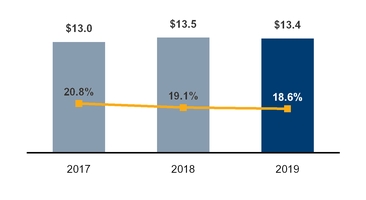
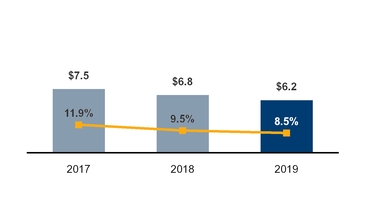
RESEARCH AND DEVELOPMENT |
2019 – 2018 | |
R&D spending decreased by $181 million, or 1%, driven by the following: | |
- | Ramp down of 5G smartphone modem business and other projects |
- | Profit-dependent compensation |
- | Corporate spending efficiencies |
+ | Investments in our data-centric businesses |
+ | Investments in process technology |
2018 – 2017 | |
R&D spending increased by $508 million, or 4%, driven by the following: | |
+ | Investments in our data-centric businesses |
+ | Investments in 10nm process technology |
+ | Profit-dependent compensation due to an increase in net income |
- | Lower expenses due to the divestiture of ISecG in Q2 2017 and Wind River in Q2 2018 |
MARKETING, GENERAL AND ADMINISTRATIVE |
2019 – 2018 | |
MG&A spending decreased by $600 million, or 9%, driven by the following: | |
- | Corporate spending efficiencies |
- | Reduction in marketing programs |
- | Profit-dependent compensation |
- | Lower expenses due to the Wind River divestiture in Q2 2018 |
2018 – 2017 | |
MG&A spending decreased by $702 million, or 9%, driven by the following: | |
- | Reduction in marketing programs |
- | Lower acquisition costs due to our 2017 acquisition of Mobileye |
- | Lower expenses due to the divestiture of ISecG in Q2 2017 and Wind River in Q2 2018 |
- | Change to the Intel Inside® Program in 2017 |
+ | Olympics* sponsorship in 2018 |
+ | Profit-dependent compensation due to an increase in net income |
 MD&A MD&A | 38 | |
GAINS (LOSSES) ON EQUITY INVESTMENTS AND INTEREST AND OTHER, NET
Years Ended (In Millions) | Dec 28, 2019 | Dec 29, 2018 | Dec 30, 2017 | |||||||||
Ongoing mark-to-market adjustments on marketable equity securities | $ | 277 | $ | (129 | ) | $ | — | |||||
Observable price adjustments on non-marketable equity securities | 293 | 202 | — | |||||||||
Impairment charges | (122 | ) | (424 | ) | (833 | ) | ||||||
Sale of equity investments and other | 1,091 | 226 | 3,484 | |||||||||
Gains (losses) on equity investments, net | $ | 1,539 | $ | (125 | ) | $ | 2,651 | |||||
Interest and other, net | $ | 484 | $ | 126 | $ | (349 | ) | |||||
GAINS (LOSSES) ON EQUITY INVESTMENTS, NET
Ongoing mark-to-market net gains and losses reported in 2019 and 2018 were primarily driven by ASML Holding N.V. (ASML) and Cloudera Inc. (Cloudera). During 2019 we sold our equity investment in ASML.
In 2019, we recognized $293 million in observable price adjustments primarily from one investment.
During 2018, we recognized an impairment charge of $290 million in our equity method investment in IMFT. During 2017, we recognized impairment charges in our investments of Cloudera for $278 million and Unisoc for $308 million.
Major drivers of sales of equity investments and other in 2019 were dividends of $632 million from McAfee and a gain of $107 million from our sale of our non-controlling interest in IMFT. In 2017, we recognized $3.4 billion in realized gains on sales of a portion of our interest in ASML.
INTEREST AND OTHER, NET
We recognized a higher net gain in interest and other in 2019 compared to 2018, primarily due to lower loss on debt conversions and larger divestiture gains in 2019 compared to 2018.
We recognized a net gain in interest and other in 2018 compared to a net loss in 2017, primarily due to lower losses on debt conversions, higher assets under construction resulting in more capitalized interest, and larger divestiture gains in 2018 compared to 2017.
 MD&A MD&A | 39 | |
LIQUIDITY AND CAPITAL RESOURCES
We consider the following when assessing our liquidity and capital resources:
(Dollars in Millions) | Dec 28, 2019 | Dec 29, 2018 | ||||||
Cash and cash equivalents, short-term investments, and trading assets | $ | 13,123 | $ | 11,650 | ||||
Other long-term investments | $ | 3,276 | $ | 3,388 | ||||
Loans receivable and other | $ | 1,239 | $ | 1,550 | ||||
Reverse repurchase agreements with original maturities greater than three months | $ | 350 | $ | 250 | ||||
Total debt | $ | 29,001 | $ | 26,359 | ||||
Temporary equity | $ | 155 | $ | 419 | ||||
Debt as a percentage of permanent stockholders’ equity | 37.4 | % | 35.4 | % | ||||
Cash generated by operations is our primary source of liquidity. When assessing our sources of liquidity, we include investments as shown in the preceding table. We maintain a diverse investment portfolio that we continually analyze based on issuer, industry, and country. Substantially all of our investments in debt instruments and financing receivables are in investment-grade securities.
Other potential sources of liquidity include our commercial paper program and our automatic shelf registration statement on file with the SEC, pursuant to which we may offer an unspecified amount of debt, equity, and other securities. Under our commercial paper program, we have an ongoing authorization from our Board of Directors to borrow up to $10.0 billion. As of December 28, 2019, no commercial paper remained outstanding. During 2019, we issued a total of $2.8 billion aggregate principal amount of senior notes and received proceeds of $648 million aggregate principal amount of bonds issued by the Industrial Development Authority of the City of Chandler, Arizona and the State of Oregon Business Development Commission. We also redeemed our $915 million, 4.70% senior notes due December 2045. Additionally, we repaid $170 million of our 3.25% senior notes that matured in December 2019 and paid $1.5 billion in cash to satisfy conversion requests for a portion of our $2.0 billion 2009 Debentures. In November 2019, we issued a notice of redemption for the remaining $372 million of 2009 Debentures with a redemption date of January 9, 2020.
We believe we have sufficient financial resources to meet our business requirements in the next 12 months, including capital expenditures for worldwide manufacturing and assembly and test; working capital requirements; and potential acquisitions, strategic investments, dividends, and common stock repurchases.
 | "Our finance team plays a fundamental role in partnering with the business to ensure we have the capital and financial resources available to fund our global operations and future growth initiatives." —Sharon Heck, Corporate Vice President, Treasurer, and Chief Tax Officer | |
 MD&A MD&A | 40 | |
SOURCES AND USES OF CASH (In Millions) |
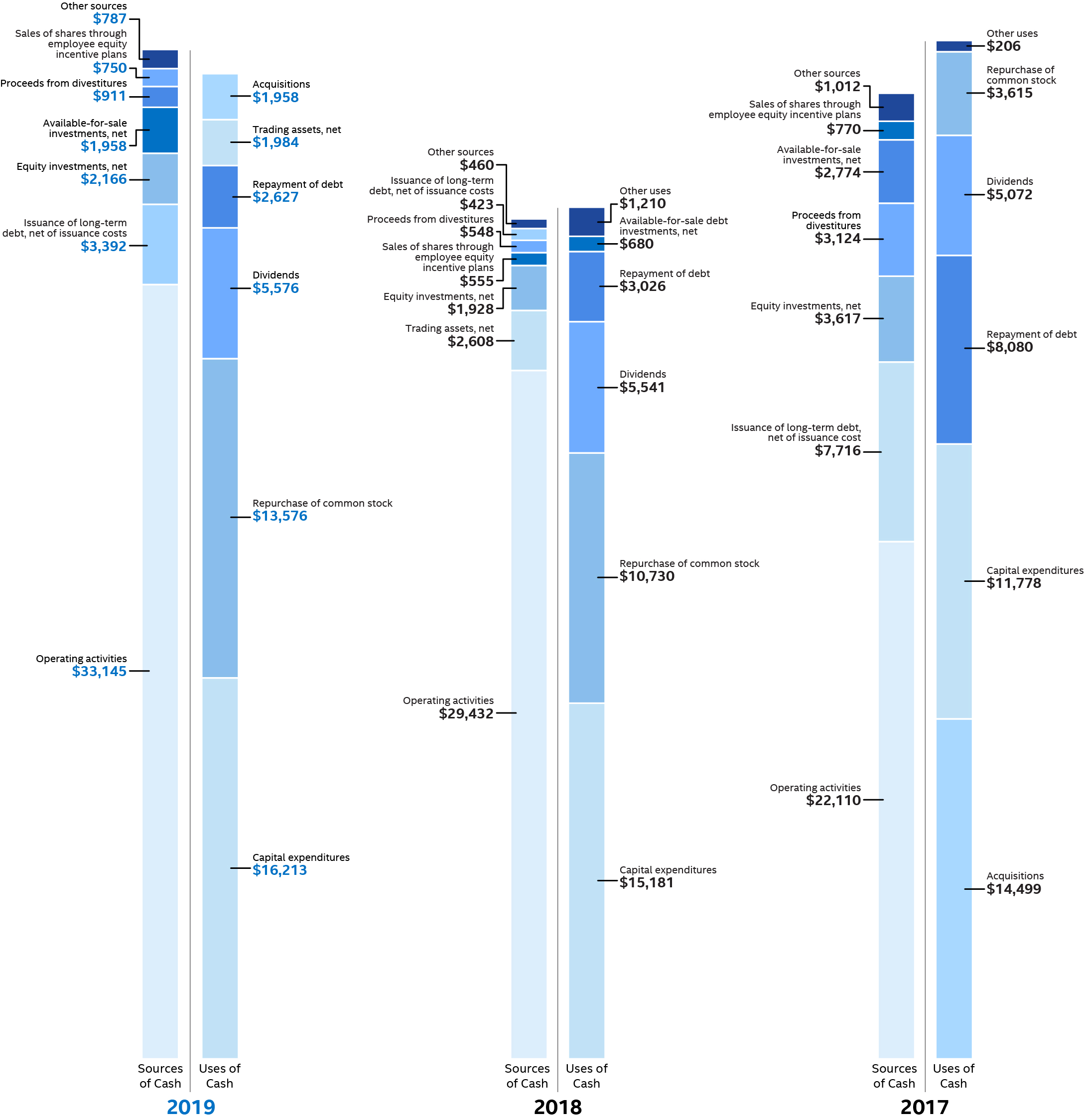
In summary, our cash flows for each period were as follows:
Years Ended (In Millions) | Dec 28, 2019 | Dec 29, 2018 | Dec 30, 2017 | |||||||||
Net cash provided by operating activities | $ | 33,145 | $ | 29,432 | $ | 22,110 | ||||||
Net cash used for investing activities | (14,405 | ) | (11,239 | ) | (15,762 | ) | ||||||
Net cash provided by (used for) financing activities | (17,565 | ) | (18,607 | ) | (8,475 | ) | ||||||
Net increase (decrease) in cash and cash equivalents | $ | 1,175 | $ | (414 | ) | $ | (2,127 | ) | ||||
 MD&A MD&A | 41 | |
OPERATING ACTIVITIES
Cash provided by operating activities is net income adjusted for certain non-cash items and changes in assets and liabilities.
For 2019 compared to 2018, the $3.7 billion increase in cash provided by operating activities was primarily due to changes in working capital. Changes in working capital were driven by taxes, other assets and liabilities, and accounts receivable, offset by customer utilization of prepaid supply agreement payments and inventory build.
For 2018 compared to 2017, the $7.3 billion increase in cash provided by operating activities was primarily due to higher net income, offset by changes in working capital. Changes in working capital were driven by taxes and accounts receivables, offset by relatively flat inventory levels. Income taxes paid, net of refunds, in 2018 compared to 2017 were flat as the benefit of a lower U.S. corporate tax rate was offset by the payment related to the 2017 U.S. Tax Reform transition tax. We received $1.4 billion of customer deposits and prepaid supply agreements in 2018, net of customer utilization, compared to $1.1 billion in 2017.
INVESTING ACTIVITIES
Investing cash flows consist primarily of capital expenditures; investment purchases, sales, maturities, and disposals; and proceeds from divestitures and cash used for acquisitions. Our capital expenditures were $16.2 billion in 2019 ($15.2 billion in 2018 and $11.8 billion in 2017).
The increase in cash used for investing activities in 2019 compared to 2018 was primarily due to net trading asset activity, acquisitions, and capital expenditures. The increase was partially offset by net available-for-sale debt investment activity.
The decrease in cash used for investing activities in 2018 compared to 2017 was primarily due to lower cash paid on acquisitions and increased cash from net trading asset activity. This was partially offset by increased capital expenditures, net available-for-sale debt investments activity, decreased proceeds from divestitures, and decreased sales of equity investments (substantially all from ASML sales).
FINANCING ACTIVITIES
Financing cash flows consist primarily of repurchases of common stock, payment of dividends to stockholders, issuance and repayment of short-term and long-term debt, and proceeds from the sale of shares of common stock through employee equity incentive plans.
The decrease in cash used for financing activities in 2019 compared to 2018 was primarily due to increased long-term debt issuance, offset by increased repurchases of common stock. During 2019, we repurchased $13.6 billion of common stock under our authorized common stock repurchase program, compared to $10.7 billion in 2018. In October 2019, the Board of Directors approved a $20.0 billion increase in our authorized stock repurchase program authorization, and we announced that we expect to repurchase $20.0 billion in stock over the next 15 to 18 months. As of December 28, 2019, $23.8 billion remained available for repurchasing common stock under the repurchase authorization limit. In general, we base our level of common stock repurchases on internal cash management decisions, and this level may fluctuate in the future. Our total dividend payments were $5.6 billion in 2019 compared to $5.5 billion in 2018. We have paid a cash dividend in each of the past 109 quarters. In Q1 2020, the Board of Directors declared a quarterly cash dividend of $0.33 per share of common stock, payable on March 1, 2020 to stockholders of record on February 7, 2020.
The increase in cash used for financing activities in 2018 compared to 2017 was primarily due to decreased long-term debt issuance and increased repurchases of common stock.
 MD&A MD&A | 42 | |
CONTRACTUAL OBLIGATIONS
Significant contractual obligations as of December 28, 2019 were as follows:
Payments Due by Period | ||||||||||||||||||||
(In Millions) | Total | Less Than 1 Year | 1–3 Years | 3–5 Years | More Than 5 Years | |||||||||||||||
Operating lease obligations1 | $ | 595 | $ | 178 | $ | 232 | $ | 128 | $ | 57 | ||||||||||
Capital purchase obligations2 | 10,918 | 9,300 | 1,595 | 14 | 9 | |||||||||||||||
Other purchase obligations and commitments3 | 2,757 | 1,636 | 947 | 147 | 27 | |||||||||||||||
Tax obligations4 | 4,442 | 10 | 746 | 1,853 | 1,833 | |||||||||||||||
Long-term debt obligations5 | 41,328 | 4,706 | 8,510 | 3,508 | 24,604 | |||||||||||||||
Other long-term liabilities6 | 1,692 | 898 | 640 | 40 | 114 | |||||||||||||||
Total7 | $ | 61,732 | $ | 16,728 | $ | 12,670 | $ | 5,690 | $ | 26,644 | ||||||||||
1 | Operating lease obligations represent the undiscounted lease payments under non-cancelable leases, but exclude non-lease components. |
2 | Capital purchase obligations represent commitments for the construction or purchase of property, plant and equipment. They were not recorded as liabilities on our Consolidated Balance Sheets as of December 28, 2019, as we had not yet received the related goods nor taken title to the property. |
3 | Other purchase obligations and commitments include payments due under various types of licenses and agreements to purchase goods or services. |
4 | Tax obligations represent the future cash payments related to Tax Reform enacted in 2017 for the one-time transition tax on our previously untaxed foreign earnings. For further information, see "Note 9: Income Taxes" within the Consolidated Financial Statements. |
5 | Amounts represent principal payments for all debt obligations and interest payments for fixed-rate debt obligations. Interest payments on floating-rate debt obligations, as well as the impact of fixed-rate to floating-rate debt swaps, are excluded. Debt obligations are classified based on their stated maturity date, regardless of their classification on the Consolidated Balance Sheets. |
6 | Amounts represent future cash payments to satisfy other long-term liabilities recorded on our Consolidated Balance Sheets, including the short-term portion of these long-term liabilities. Derivative instruments are excluded from the preceding table, because they do not represent the amounts that may ultimately be paid. |
7 | Total excludes contractual obligations already recorded on our Consolidated Balance Sheets as current liabilities, except for the short-term portions of long-term debt obligations and other long-term liabilities. |
The expected timing of payments of the obligations in the preceding table is estimated based on current information. Timing of payments and actual amounts paid may be different, depending on the time of receipt of goods or services, or changes to agreed-upon amounts for some obligations.
Contractual obligations for purchases of goods or services included in "Other purchase obligations and commitments" in the preceding table include agreements that are enforceable and legally binding and that specify all significant terms, including fixed or minimum quantities to be purchased; fixed, minimum, or variable price provisions; and the approximate timing of the transaction. For obligations with cancellation provisions, the amounts included in the preceding table were limited to the non-cancelable portion of the agreement terms or the minimum cancellation fee.
For the purchase of raw materials, we have entered into certain agreements that specify minimum prices and quantities based on a percentage of the total available market or based on a percentage of our future purchasing requirements. Due to the uncertainty of the future market and our future purchasing requirements, as well as the non-binding nature of these agreements, obligations under these agreements have been excluded from the preceding table. Our purchase orders for other products are based on our current manufacturing needs and are fulfilled by our vendors within short time horizons. In addition, some of our purchase orders represent authorizations to purchase rather than binding agreements.
Contractual obligations that are contingent upon the achievement of certain milestones have been excluded from the preceding table. Approximately half of our milestone-based contracts are tooling related for the purchase of capital equipment. These arrangements are not considered contractual obligations until the milestone is met by the counterparty. As of December 28, 2019, assuming that all future milestones are met, the additional required payments would be approximately $498 million.
For the majority of RSUs granted, the number of shares of common stock issued on the date the RSUs vest is net of the minimum statutory withholding requirements that we pay in cash to the appropriate taxing authorities on behalf of our employees. The obligation to pay the relevant taxing authority is excluded from the preceding table, as the amount is contingent upon continued employment. In addition, the amount of the obligation is unknown, as it is based in part on the market price of our common stock when the awards vest.
QUANTITATIVE AND QUALITATIVE DISCLOSURES ABOUT MARKET RISK
We are affected by changes in currency exchange and interest rates, as well as equity and commodity prices. Our risk management programs are designed to reduce, but may not entirely eliminate, the impacts of these risks. All of the following potential changes are based on sensitivity analyses performed on our financial positions as of December 28, 2019 and December 29, 2018. Actual results may differ materially.
 MD&A MD&A | 43 | |
CURRENCY EXCHANGE RATES
We are exposed to currency exchange risks of non-U.S.-dollar-denominated investments in debt instruments and loans receivable, and may economically hedge this risk with foreign currency contracts, such as currency forward contracts or currency interest rate swaps. Gains or losses on these non-U.S.-currency investments are generally offset by corresponding losses or gains on the related hedging instruments. We are exposed to currency exchange risks from our non-U.S.-dollar-denominated debt indebtedness and may use foreign currency contracts designated as cash flow hedges to manage this risk.
Substantially all of our revenue is transacted in U.S. dollars. However, a significant portion of our operating expenditures and capital purchases are incurred in other currencies, primarily the euro, the Japanese yen, the Israeli shekel, and the Chinese yuan. We have established currency risk management programs to protect against currency exchange rate risks associated with non-U.S. dollar forecasted future cash flows and existing non-U.S. dollar monetary assets and liabilities. We may also hedge currency risk arising from funding of foreign currency-denominated future investments. We may utilize foreign currency contracts, such as currency forwards or option contracts in these hedging programs. We considered the historical trends in currency exchange rates and determined that it was reasonably possible that a weighted average adverse change of 10% in currency exchange rates could be experienced in the near term. Such an adverse change, after taking into account balance sheet hedges only and offsetting recorded monetary asset and liability positions outstanding as of December 28, 2019 and December 29, 2018, would result in an adverse impact on income before taxes of less than $38 million and less than $46 million, respectively.
INTEREST RATES
We are exposed to interest rate risk related to our fixed-rate investment portfolio and outstanding debt. The primary objective of our investment policy is to preserve principal and the financial flexibility to fund our business while maximizing yields, which generally track the U.S. dollar three-month LIBOR. We generally enter into interest rate contracts to convert the returns on our fixed-rate debt investment with remaining maturities longer than six months into U.S. dollar three-month LIBOR-based returns. We also enter into swaps to convert fixed-rate coupon payments into floating-rate coupon payments for our existing indebtedness. Gains or losses on these instruments are generally offset by corresponding losses or gains on the related hedging instruments.
A hypothetical increase in benchmark interest rates of up to 1.0%, after taking into account investment hedges, would have resulted in a decrease in the fair value of our investment portfolio of approximately $88 million as of December 28, 2019 (a hypothetical decrease of 1.0% would have resulted in an increase of approximately $110 million as of December 29, 2018).
Taking into account floating-rate debt and fixed-rate debt that is swapped to floating-rate debt, a hypothetical increase in interest rates of up to 1.0% would result in an increase in annual interest expense on our indebtedness of approximately $139 million from debt outstanding as of December 28, 2019 (an increase of approximately $215 million from debt outstanding as of December 29, 2018).
EQUITY PRICES
Our investments include marketable equity securities and equity derivative instruments. We typically do not attempt to reduce or eliminate our equity market exposure through hedging activities at the inception of our investments. In the event we do decide to enter into hedge arrangements, before doing so we evaluate legal, market, and economic factors, as well as the expected timing of disposal, to determine whether hedging is appropriate. Our equity market risk management program may include equity derivatives with or without hedge accounting designation that utilize warrants, equity options, or other equity derivatives.
We also utilize total return swaps to offset changes in liabilities related to the equity market risks of certain deferred compensation arrangements. Gains or losses from changes in fair value of these total return swaps are generally offset by the losses or gains on the related liabilities.
As of December 28, 2019, the fair value of our marketable equity investments and our equity derivative instruments, including hedging positions, was $450 million ($1.4 billion as of December 29, 2018). A substantial majority of our marketable equity investments portfolio as of December 29, 2018 was concentrated in our investment in ASML of $1.1 billion. During 2019, we fully sold our investment in ASML. To determine reasonably possible decreases in the market value of our marketable equity investments, we have analyzed the historical market price sensitivity of our marketable equity investment portfolio. Assuming a decline of 40% in market prices, and after reflecting the impact of hedges and offsetting positions, the aggregate value of our marketable equity investments could decrease by approximately $180 million, based on the value as of December 28, 2019 (a decrease in value of approximately $576 million, based on the value as of December 29, 2018 using an assumed decline of 40%). Beginning in 2018, as explained in "Note 2: Accounting Policies" within the Consolidated Financial Statements, changes in the fair value of our marketable equity securities will be measured and recorded at fair value with changes in fair value recorded through the income statement.
 MD&A MD&A | 44 | |
Many of the same factors that could result in an adverse movement of equity market prices affect our non-marketable equity investments, although we cannot always quantify the impacts directly. Financial markets are volatile, which could negatively affect the prospects of the companies we invest in, their ability to raise additional capital, and the likelihood of our ability to realize value in our investments through liquidity events such as initial public offerings, mergers, and private sales. These types of investments involve a great deal of risk, and there can be no assurance that any specific company will grow or become successful; consequently, we could lose all or part of our investment. Our non-marketable equity securities had a carrying amount of $3.5 billion as of December 28, 2019 ($3.0 billion as of December 29, 2018) and included our investment in Unisoc of $658 million ($658 million for Unisoc as of December 29, 2018). The carrying amount of our equity method investments was $37 million as of December 28, 2019 ($1.6 billion as of December 29, 2018). Substantially all of our equity method investments balance as of December 29, 2018 was concentrated in our investment in IMFT. During 2019, we sold our non-controlling interest in IMFT to Micron.
COMMODITY PRICE RISK
Although we operate facilities that consume commodities, we are not directly affected by commodity price risk to a material degree. We have established forecasted transaction risk management programs to protect against fluctuations in commodity prices. We may use commodity derivatives contracts, such as commodity swaps, in these hedging programs. In addition, we have sourcing plans in place that are designed to mitigate the risk of a potential supplier concentration for our key commodities.
NON-GAAP FINANCIAL MEASURES
In addition to disclosing financial results in accordance with U.S. GAAP, this document contains references to the non-GAAP financial measures below. We believe these non-GAAP financial measures provide investors with useful supplemental information about the financial performance of our business, enable comparison of financial results between periods where certain items may vary independent of business performance, and allow for greater transparency with respect to key metrics used by management in operating our business and measuring our performance.
Our non-GAAP financial measures reflect adjustments based on one or more of the following items, as well as the related income tax effects where applicable. Income tax effects have been calculated using an appropriate tax rate for each adjustment. These non-GAAP financial measures should not be considered a substitute for, or superior to, financial measures calculated in accordance with U.S. GAAP, and the financial results calculated in accordance with U.S. GAAP and reconciliations from these results should be carefully evaluated.
ACQUISITION-RELATED ADJUSTMENTS
Acquisition-related adjustments exclude charges related to amortization of acquisition-related intangible assets, inventory valuation adjustments, and other acquisition-related charges.
Amortization of acquisition-related intangible assets consists of amortization of intangible assets such as developed technology, brands, and customer relationships acquired in connection with business combinations. Cost of sales and operating expenses in our U.S. GAAP financial statements include amortization charges for intangible assets acquired primarily for the acquisitions of Mobileye in 2017 and Altera in 2016. These charges are inconsistent in size and are significantly impacted by the timing and valuation of our acquisitions.
Business combination accounting principles require us to measure acquired inventory at fair value. The fair value of inventory reflects the acquired company’s cost of manufacturing plus a portion of the expected profit margin. The acquisition-related inventory valuation adjustments exclude the expected profit margin component from cost of sales that was recorded under business combination accounting principles associated with our acquisition of Mobileye.
Other acquisition-related charges primarily include bankers' fees, compensation-related costs, and valuation charges for stock-based compensation incurred in connection with the acquisition of Mobileye.
Our non-GAAP adjustments exclude these charges to facilitate a better evaluation of our current operating performance and comparison to our past operating performance, and provide investors with additional means to reflect costs of sales, gross margin and spending trends.
RESTRUCTURING AND OTHER CHARGES
Restructuring charges are costs associated with a formal restructuring plan and are primarily related to employee severance and benefit arrangements. Other charges include asset impairments, pension charges, and costs associated with the exit of the 5G smartphone modem business and the ISecG divestiture. We exclude restructuring and other charges, including any adjustments to charges recorded in prior periods, for purposes of calculating certain non-GAAP measures. These costs do not reflect our current operating performance. Consequently, our non-GAAP adjustments exclude these charges to facilitate an evaluation of our current operating performance and comparisons to our past operating performance.
GAINS OR LOSSES FROM DIVESTITURE
We divested our 5G smartphone modem business in 2019, Wind River in 2018, and ISecG in 2017. We exclude gains or losses and related tax impacts resulting from divestitures when calculating certain non-GAAP measures. These adjustments facilitate a better evaluation of our current operating performance and comparisons to our past operating performance.
 MD&A MD&A | 45 | |
ONGOING MARK-TO-MARKET ON MARKETABLE EQUITY SECURITIES
When calculating certain non-GAAP measures, we exclude gains and losses resulting from ongoing mark-to-market adjustments of our marketable equity securities after the initial mark-to-market adjustment is recorded upon a security becoming marketable, as we do not believe this volatility correlates to our core operational performance. Consequently, our non-GAAP earnings per share figures exclude these impacts to facilitate an evaluation of our current performance and comparisons to our past operating performance.
TAX REFORM ADJUSTMENT
We recognized a higher income tax expense in Q4 2017 as a result of Tax Reform and made adjustments to the original estimate during 2018. We exclude the provisional tax estimate and adjustments when calculating certain non-GAAP measures. These adjustments facilitate a better evaluation of our current operating performance and comparisons to past operating results.
FREE CASH FLOW
We reference a non-GAAP financial measure of free cash flow, which is used by management when assessing our sources of liquidity, capital resources, and quality of earnings. This non-GAAP financial measure is helpful to investors in understanding our capital requirements and provides an additional means to reflect the cash flow trends of our business.
Following are the reconciliations of our most comparable U. S. GAAP measures to our non-GAAP measures presented:
Years Ended (In Millions, Except Per Share Amounts) | Dec 28, 2019 | Dec 29, 2018 | Dec 30, 2017 | |||||||||
Operating income | $ | 22,035 | $ | 23,316 | $ | 18,050 | ||||||
Acquisition-related adjustments | 1,324 | 1,305 | 1,257 | |||||||||
Restructuring and other charges | 393 | (72 | ) | 384 | ||||||||
Non-GAAP operating income | $ | 23,752 | $ | 24,549 | $ | 19,691 | ||||||
Operating margin | 30.6 | % | 32.9 | % | 28.8 | % | ||||||
Acquisition-related adjustments | 1.8 | % | 1.8 | % | 2.0 | % | ||||||
Restructuring and other charges | 0.5 | % | (0.1 | )% | 0.6 | % | ||||||
Non-GAAP operating margin | 33.0 | % | 34.7 | % | 31.4 | % | ||||||
Net income | $ | 21,048 | $ | 21,053 | $ | 9,601 | ||||||
Acquisition-related adjustments | 1,324 | 1,305 | 1,257 | |||||||||
Restructuring and other charges | 393 | (72 | ) | 384 | ||||||||
(Gains) losses from divestiture | (690 | ) | (494 | ) | (387 | ) | ||||||
Ongoing mark-to-market on marketable equity securities | (277 | ) | 129 | — | ||||||||
Tax Reform | — | (294 | ) | 5,444 | ||||||||
Income tax effect | (14 | ) | (102 | ) | 454 | |||||||
Non-GAAP net income | $ | 21,784 | $ | 21,525 | $ | 16,753 | ||||||
Earnings per share—Diluted | $ | 4.71 | $ | 4.48 | $ | 1.99 | ||||||
Acquisition-related adjustments | 0.29 | 0.28 | 0.25 | |||||||||
Restructuring and other charges | 0.09 | (0.02 | ) | 0.08 | ||||||||
(Gains) losses from divestiture | (0.16 | ) | (0.11 | ) | (0.08 | ) | ||||||
Ongoing mark-to-market on marketable equity securities | (0.06 | ) | 0.03 | — | ||||||||
Tax Reform | — | (0.06 | ) | 1.13 | ||||||||
Income tax effect | — | (0.02 | ) | 0.09 | ||||||||
Non-GAAP earnings per share—Diluted | $ | 4.87 | $ | 4.58 | $ | 3.46 | ||||||
Years Ended (In Millions) | Dec 28, 2019 | Dec 29, 2018 | Dec 30, 2017 | Dec 31, 2016 | Dec 26, 2015 | |||||||||||||||
Net cash provided by operating activities | $ | 33,145 | $ | 29,432 | $ | 22,110 | $ | 21,808 | $ | 19,018 | ||||||||||
Additions to property, plant and equipment | (16,213 | ) | (15,181 | ) | (11,778 | ) | (9,625 | ) | (7,326 | ) | ||||||||||
Free cash flow | $ | 16,932 | $ | 14,251 | $ | 10,332 | $ | 12,183 | $ | 11,692 | ||||||||||
Net cash used for investing activities | $ | (14,405 | ) | $ | (11,239 | ) | $ | (15,762 | ) | $ | (25,817 | ) | $ | (8,183 | ) | |||||
Net cash provided by (used for) financing activities | $ | (17,565 | ) | $ | (18,607 | ) | $ | (8,475 | ) | $ | (5,739 | ) | $ | 1,912 | ||||||
 OTHER KEY INFORMATION OTHER KEY INFORMATION | 46 | |
OTHER KEY INFORMATION |
SELECTED FINANCIAL DATA
Years Ended (Dollars in Millions, Except Per Share Amounts) | Dec 28, 2019 | Dec 29, 2018 | Dec 30, 2017 | Dec 31, 2016 | Dec 26, 2015 | |||||||||||||||
Net revenue | $ | 71,965 | $ | 70,848 | $ | 62,761 | $ | 59,387 | $ | 55,355 | ||||||||||
Gross margin1 | $ | 42,140 | $ | 43,737 | $ | 39,098 | $ | 36,233 | $ | 34,679 | ||||||||||
Gross margin percentage1 | 58.6 | % | 61.7 | % | 62.3 | % | 61.0 | % | 62.6 | % | ||||||||||
Research and development1 | $ | 13,362 | $ | 13,543 | $ | 13,035 | $ | 12,685 | $ | 12,128 | ||||||||||
Marketing, general and administrative1 | $ | 6,150 | $ | 6,750 | $ | 7,452 | $ | 8,377 | $ | 7,930 | ||||||||||
R&D and MG&A as a percentage of revenue1 | 27.1 | % | 28.6 | % | 32.6 | % | 35.5 | % | 36.2 | % | ||||||||||
Operating income1 | $ | 22,035 | $ | 23,316 | $ | 18,050 | $ | 13,133 | $ | 14,002 | ||||||||||
Net income2 | $ | 21,048 | $ | 21,053 | $ | 9,601 | $ | 10,316 | $ | 11,420 | ||||||||||
Effective tax rate2 | 12.5 | % | 9.7 | % | 52.8 | % | 20.3 | % | 19.6 | % | ||||||||||
Earnings per share2 | ||||||||||||||||||||
Basic | $ | 4.77 | $ | 4.57 | $ | 2.04 | $ | 2.18 | $ | 2.41 | ||||||||||
Diluted | $ | 4.71 | $ | 4.48 | $ | 1.99 | $ | 2.12 | $ | 2.33 | ||||||||||
Weighted average diluted shares of common stock outstanding | 4,473 | 4,701 | 4,835 | 4,875 | 4,894 | |||||||||||||||
Dividends per share of common stock, declared and paid | $ | 1.26 | $ | 1.20 | $ | 1.0775 | $ | 1.04 | $ | 0.96 | ||||||||||
Net cash provided by operating activities | $ | 33,145 | $ | 29,432 | $ | 22,110 | $ | 21,808 | $ | 19,018 | ||||||||||
Additions to property, plant and equipment | $ | 16,213 | $ | 15,181 | $ | 11,778 | $ | 9,625 | $ | 7,326 | ||||||||||
Repurchase of common stock | $ | 13,576 | $ | 10,730 | $ | 3,615 | $ | 2,587 | $ | 3,001 | ||||||||||
Payment of dividends to stockholders | $ | 5,576 | $ | 5,541 | $ | 5,072 | $ | 4,925 | $ | 4,556 | ||||||||||
(Dollars in Millions) | Dec 28, 2019 | Dec 29, 2018 | Dec 30, 2017 | Dec 31, 2016 | Dec 26, 2015 | |||||||||||||||
Property, plant and equipment, net | $ | 55,386 | $ | 48,976 | $ | 41,109 | $ | 36,171 | $ | 31,858 | ||||||||||
Total assets | $ | 136,524 | $ | 127,963 | $ | 123,249 | $ | 113,327 | $ | 101,459 | ||||||||||
Debt | $ | 29,001 | $ | 26,359 | $ | 26,813 | $ | 25,283 | $ | 22,670 | ||||||||||
Stockholders’ equity | $ | 77,504 | $ | 74,563 | $ | 69,019 | $ | 66,226 | $ | 61,085 | ||||||||||
Employees (in thousands) | 110.8 | 107.4 | 102.7 | 106.0 | 107.3 | |||||||||||||||
1 | In Q1 2018, we adopted "Retirement Benefits - Improving the Presentation of Net Periodic Pension Cost and Net Periodic Postretirement Benefit Cost" on a retrospective basis. As a result of the adoption of this standard, cost of sales, operating expenses, and interest and other, net for periods 2017 and 2016 in the preceding table have been restated. |
2 | In Q4 2017, we recognized a $5.4 billion higher income tax expense as a result of one-time impacts from Tax Reform. In 2018, our effective tax rate benefited from the reduction of the U.S. statutory federal tax rate. |
 OTHER KEY INFORMATION OTHER KEY INFORMATION | 47 | |
SALES AND MARKETING
CUSTOMERS
We sell our products primarily to OEMs, ODMs, and cloud service providers. ODMs provide design and manufacturing services to branded and unbranded private-label resellers. In addition, our customers include other manufacturers and service providers, such as industrial and communication equipment manufacturers and cloud service providers, who buy our products through distributor, reseller, retail, and OEM channels throughout the world. For more information about our customers, including customers who accounted for greater than 10% of our net consolidated revenue, see "Note 4: Operating Segments" within the Consolidated Financial Statements.
Our worldwide reseller sales channel consists of thousands of indirect customers—systems builders that purchase Intel® processors and other products from our distributors. We have incentive programs that allow distributors to sell our microprocessors and other products in small quantities to systems integrators. Our microprocessors and other products are also available in direct retail outlets.
SALES ARRANGEMENTS
Our products are sold through distribution channels throughout the world. Sales of our products are frequently made via purchase order acknowledgments that contain standard terms and conditions covering matters such as pricing, payment terms, and warranties, as well as indemnities for issues specific to our products, such as patent and copyright indemnities. From time to time, we may enter into additional agreements with customers covering, for example, changes from our standard terms and conditions, new product development and marketing, and private-label branding. Our sales are routinely made using electronic and web-based processes that allow the customer to review inventory availability and track the progress of specific goods ordered. Pricing on particular products may vary based on volumes ordered and other factors. We also offer discounts, rebates, and other incentives to customers to increase acceptance of our products and technology.
In accordance with contract terms, revenue for product sales is recognized at the time of product shipment from our facilities or delivery to the customer location, as determined by the agreed-upon shipping terms. Our standard terms and conditions of sale typically provide that payment is due at a later date, 30 days after shipment or delivery. We assess credit risk through quantitative and qualitative analysis. From this analysis, we establish shipping and credit limits, and determine whether we will seek to use one or more credit support protection devices, such as obtaining a parent guarantee, standby letter of credit, or credit insurance. Credit losses may still be incurred due to bankruptcy, fraud, or other failure of the customer to pay.
Our sales to distributors are typically made under agreements allowing for price protection on unsold merchandise and a right of return on stipulated quantities of unsold merchandise. Under the price protection program, we give distributors credits for the difference between the original price paid and the current price that we offer. Our products typically have no contractual limit on the amount of price protection, nor is there a limit on the time horizon under which price protection is granted. The right of return granted generally consists of a stock rotation program in which distributors are able to exchange certain products based on the number of qualified purchases made by the distributor.
DISTRIBUTION
Distributors typically handle a wide variety of products, including those that compete with our products, and fill orders for many customers. Customers may place orders directly with us or through distributors. We have several distribution warehouses that are located in proximity to key customers.
SEASONAL TRENDS
Historically, our net revenue has typically been higher in the second half of the year than in the first half of the year, accelerating in the third quarter and peaking in the fourth quarter.
MARKETING
Our global marketing objectives are to build a strong, well-known, differentiated, and meaningful Intel corporate brand that drives preference with businesses and consumers, and to offer a limited number of meaningful and valuable brands in our portfolio to aid businesses and consumers in making informed choices about technology purchases. The Intel® Core™ processor family and the Intel® Quark™, Intel Atom®, Celeron®, Pentium®, Intel® Xeon®, and Itanium® trademarks make up our CPU brands.
We promote brand awareness and preference, and generate demand through our own direct marketing, as well as through co-marketing programs. Our direct marketing activities primarily include advertising through digital and social media and television, as well as consumer and trade events, industry and consumer communications, and press relations. We market to consumer and business audiences, and focus on building awareness and generating demand for our products. Our key messaging focuses on increased performance, improved energy efficiency, and other capabilities such as connectivity and communications.
 OTHER KEY INFORMATION OTHER KEY INFORMATION | 48 | |
Certain customers participate in cooperative advertising and marketing programs. These cooperative advertising and marketing programs broaden the reach of our brands beyond the scope of our own direct marketing. Certain customers are licensed to place Intel® logos on computing devices containing our microprocessors and processor technologies, and to use our brands in their marketing activities. The program partially reimburses customers for marketing activities for products featuring Intel® brands, subject to customers meeting defined criteria. These marketing activities primarily include advertising through digital and social media and television, as well as press relations. We have also entered into joint marketing arrangements with certain customers.
COMPETITION
We discuss competitive conditions in our businesses, the market segments in which we compete, our competitors, and the principal methods of competition in the "Segment Trends and Results" section of MD&A, particularly under the heading "Market and Business Overview" for each business, as well as in "Risk Factors," particularly in the risk factors "We face significant competition" and "Our investments in new businesses, products, and technologies are inherently risky and do not always succeed."
Our key competitive advantages include those discussed in "Our Strategy" and "Our Capital" within Fundamentals of our Business, and the "Our Products" section of MD&A, particularly the discussions of our broad product portfolio and in-house manufacturing capabilities. Our competitive challenges include those discussed in Risk Factors, particularly in the risk factors "We face significant competition"; "Our investments in new businesses, products, and technologies are inherently risky and do not always succeed"; and "We are subject to risks associated with the development and implementation of new manufacturing process technology."
INTELLECTUAL PROPERTY RIGHTS AND LICENSING
Intel owns and develops significant IP and related IP rights around the world that relate to our products, services, R&D, and other activities and assets. Our IP portfolio includes patents, copyrights, trade secrets, trademarks, trade dress rights, and mask work rights. We actively seek to protect our global IP rights and to deter unauthorized use of our IP and other assets. Such efforts can be difficult, however, particularly in countries that provide less protection to IP rights and in the absence of harmonized international IP standards. For a discussion of the risks related to IP and our IP rights, please see “We are subject to IP risks and risks associated with litigation and regulatory proceedings” in "Risk Factors" within Other Key Information. While our IP rights are important to our success, our business as a whole is not significantly dependent on any single patent, copyright, or other IP right.
We have obtained patents in the U.S. and other countries. Because of the fast pace of innovation and product development, and the comparative pace of governments’ patenting processes, our products are often obsolete before the patents related to them expire; in some cases, our products may be obsolete before the patents related to them are granted. As we expand our product offerings into new industries, we also seek to extend our patent development efforts to patent such products. In addition to developing patents based on our own R&D efforts, we may purchase or license patents from third parties. Established competitors in existing and new industries, as well as companies that purchase and enforce patents and other IP, may already have patents covering similar products. There is no assurance that we will be able to obtain patents covering our own products, or that we will be able to obtain licenses from other companies on favorable terms or at all.
The software that we distribute, including software embedded in our component-level and platform products, is entitled to copyright and other IP protection. To distinguish our products from our competitors’ products, we have obtained trademarks and trade names for our products, and we maintain cooperative advertising programs with customers to promote our brands and to identify products containing genuine Intel components. We also protect details about our processes, products, and strategies as trade secrets, keeping confidential the information that we believe provides us with a competitive advantage.
 | "Intel carefully protects its innovations, and we have a long history of vigilantly enforcing our IP rights against infringement. Strong IP protections make it possible for Intel to continue to invest the enormous resources required to innovate and advance our strategic goals to make the world’s best semiconductors, lead technology inflections, and be the leading end-to-end platform provider for the new data world." —Steve Rodgers, Executive Vice President and General Counsel | |
 OTHER KEY INFORMATION OTHER KEY INFORMATION | 49 | |
CRITICAL ACCOUNTING ESTIMATES
The methods, assumptions, and estimates that we use in applying our accounting policies may require us to apply judgments regarding matters that are inherently uncertain. We consider an accounting policy to be a critical estimate if: (1) we must make assumptions that were uncertain when the judgment was made, and (2) changes in the estimate assumptions, or selection of a different estimate methodology, could have a significant impact on our financial position and the results that we report in our Consolidated Financial Statements. While we believe that our estimates, assumptions, and judgments are reasonable, they are based on information available when the estimate was made.
Refer to "Note 2: Accounting Policies" within the Consolidated Financial Statements for further information on our critical accounting estimates and policies, which are as follows:
• | Inventories—the transition of manufacturing costs to inventory, excluding factory excess capacity costs. Inventory reflected at the lower of cost or net realizable value considering future demand and market conditions; |
• | Long-lived assets—the valuation methods and assumptions used in assessing the impairment of property, plant and equipment, identified intangibles, and goodwill, including the determination of asset groupings and the identification and allocation of goodwill to reporting units; |
• | Non-marketable equity investments—the valuation estimates and assessment of impairment and observable price adjustments; and |
• | Loss contingencies—the estimation of when a loss is probable and reasonably estimable. |
RISK FACTORS
The following risks could materially and adversely affect our business, financial condition, cash flows, and results of operations, and the trading price of our common stock could decline. These risk factors do not identify all risks that we face; our operations could also be affected by factors that are not presently known to us or that we currently consider to be immaterial to our operations. Due to risks and uncertainties, known and unknown, our past financial results may not be a reliable indicator of future performance, and historical trends should not be used to anticipate results or trends in future periods. Refer also to the other information set forth in this Annual Report on Form 10-K, including in MD&A and our Consolidated Financial Statements and the related notes.
CHANGES IN PRODUCT DEMAND CAN ADVERSELY AFFECT OUR FINANCIAL RESULTS.
Demand for our products is variable and hard to predict. Our products are used in different market segments, and demand for our products varies within or among the market segments served by our PC-centric and data-centric businesses. It is difficult to forecast these changes and their impact. For example, in the first half of 2019, customers of our DCG business worked through inventory and absorbed computing capacity purchased in 2018, leading to a year over year decline in DCG platform revenue in the first half, followed by growth in DCG platform demand and revenue in the second half of 2019. Changes in the demand for our products, particularly our CCG and DCG platform products, can reduce our revenue, lower our gross margin, or require us to write down the value of our assets.
Important factors that lead to variation in the demand for our products include:
• | business conditions, including downturns in the market segments in which we operate, or in the global or regional economies; |
• | consumer confidence or income levels, and the levels of customer capital spending, which may be impacted by changes in market conditions, including changes in government borrowing, taxation, or spending policies; the credit market; or expected inflation, employment, and energy or other commodity prices; |
• | our ability to timely introduce competitive products; |
• | competitive and pricing pressures, including new product introductions and other actions taken by competitors; |
• | the level of our customers’ inventories and computing capacity; |
• | customer order patterns, including order cancellations, which can be affected by maturing product cycles for our products, customers’ products, and related products such as operating system upgrade cycles; disruptions affecting customers; and other factors; |
• | market acceptance and industry support of our new and maturing products, including the introduction and availability of products used together with our products; and |
• | customer product needs and emerging technology trends, including changes in the levels and nature of customer and end-user computing workloads. |
 OTHER KEY INFORMATION OTHER KEY INFORMATION | 50 | |
Due to the complexity of our manufacturing operations, we are not always able to timely respond to fluctuations in demand and we may incur significant charges and costs. Because we own and operate high-tech fabrication facilities, our operations have high costs that are fixed or difficult to reduce in the short term, including our costs related to utilization of existing facilities, facility construction and equipment, R&D, and the employment and training of a highly skilled workforce. To the extent product demand decreases or we fail to forecast demand accurately, we could be required to write off inventory or record excess capacity charges, which would lower our gross margin. To the extent the demand decrease is prolonged, our manufacturing or assembly and test capacity could be underutilized, and we may be required to write down our long-lived assets, which would increase our expenses. We may also be required to shorten the useful lives of under-used facilities and equipment and accelerate depreciation. Conversely, to the extent product demand increases or we fail to forecast accurately and produce the mix of products demanded, we may be unable to add capacity or increase production fast enough to meet market demand, which can result in a loss of revenue opportunities or market share, legal claims, and/or damage to customer relationships. For example, we have been experiencing supply constraints and have been prioritizing production of our server and high-performance PC products, which during 2019 contributed to loss of share in the value end of the PC market, where we were short of supply while demand remained healthy.
We face significant competition. The industry in which we operate is highly competitive and subject to rapid technological and market developments; changes in industry standards; changes in customer and end-user needs, expectations, and preferences; and frequent product introductions and improvements. If we do not anticipate and respond to these developments, our competitive position can weaken, and our products or technologies can become uncompetitive or obsolete. Our competitive environment has intensified, and we expect it to continue to do so in the future.
Our products primarily compete based on performance, energy efficiency, integration, ease-of-use, innovative design, features, price, quality, reliability, security, software ecosystem and developer support, time-to-market, reliable product roadmap execution, brand recognition, customer support and customization, and availability. The importance of these factors varies by product—for example, performance is a key competitive factor for data center platform products, and failure to introduce new products with performance advantages can harm our competitive position and market segment share in our DCG business. For our memory products, price, density, and non-volatility are among the most important competitive factors. We will not realize our strategic goal to become the leading end-to-end provider for the new data world if our products do not meet our customers’ requirements across these factors in an increasingly competitive landscape.
We face intense competition across our product portfolio from companies offering platform products, such as AMD and Qualcomm; accelerator products such as GPUs, including those offered by NVIDIA; other accelerator products such as ASICs, application-specific standard products, and FPGAs; memory and storage products; connectivity and networking products; and other semiconductor products. Some of these competitors have developed or utilize competing computing architectures and platforms for specific market segments or applications, such as the ARM* architecture, and these architectures and platforms can produce beneficial network effects for competitors when an ecosystem of customers and application developers for such architectures and platforms grows at scale. We also compete with internally developed semiconductors from OEMs, cloud service providers, and others, including customers. Some of these customers vertically integrate their own semiconductor designs with their software assets or customize their designs for specific computing workloads. Most of our competitors rely on third-party foundries, such as Taiwan Semiconductor Manufacturing Company, Ltd. or Samsung Electronics Co., Ltd., and subcontractors for manufacture and assembly and test of their semiconductor components and products. As an IDM, we have higher capital expenditures and R&D spending than many of our “fabless” competitors. We also face new sources of competition as a result of changes in industry participants through, for example, acquisitions or business collaborations, as well as new entrants, including in China, which could have a significant impact on our competitive position.
Introduction of competitive new products and technologies, aggressive pricing, and other actions taken by competitors can harm demand for our products, exert downward pricing pressure on our products, and adversely affect our business. Additionally, a number of business combinations and strategic partnerships in the semiconductor industry have occurred over the last several years, and more could occur in the future. Consolidation could lead to fewer customers, partners, or suppliers, any of which could negatively affect our financial results.
To compete successfully, we must maintain a successful R&D effort, develop new products and production processes, and improve our existing products and processes, all ahead of competitors. We are focusing our R&D efforts across six engineering pillars: process technology, architecture, memory, interconnect, security, and software. These include ambitious initiatives, such as our unified oneAPI portfolio of developer tools, and we cannot guarantee that all of these efforts will deliver the benefits we anticipate. For example, to the extent we do not timely introduce new manufacturing process technologies that improve transistor density with sufficient manufacturing yields and operational efficiency, relative to competing foundry processes, we can face cost and product performance disadvantages. Similarly, to the extent our R&D efforts do not timely produce semiconductor designs for our platform products with improvements in areas like performance, performance per watt, die utilization, and core counts, and with new features such as optimizations for AI and other workloads, our competitive position can be harmed.
We do not expect all of our R&D investments to be successful. Some of our efforts to develop and market new products fail, and the products and technologies we invest in and develop are not always well received by customers, who may adopt competing technologies. We make significant investments in R&D, and our investments at times do not contribute to our future operating results for several years, if at all, and such contributions at times do not meet our expectations or even cover the costs of such investments.
If we are not able to compete effectively, our financial results will be adversely affected, including reduced revenue and gross margin, and we may be required to accelerate the write-down of the value of certain assets.
 OTHER KEY INFORMATION OTHER KEY INFORMATION | 51 | |
Our investments in new businesses, products, and technologies are inherently risky and do not always succeed. In recent years, in connection with our strategic transformation to a data-centric company, we have entered new areas and introduced adjacent products in programmable solutions, AI, and autonomous driving. We also expanded our adjacent product offerings in client computing, the data center, the Internet of Things, and memory, with offerings such as modems, silicon photonics solutions, and Intel® Optane™ technology products, and we have made investments in discrete graphics and networking infrastructure products. These efforts are not always successful. In April 2019, we announced that we would be exiting the 5G smartphone modem business based on our determination that there was no clear path to profitability for the business, and in November 2019, we completed the sale of the majority of our smartphone modem business.
These new and developing areas and products represent a significant portion of our expanded TAM, and they also introduce new sources of competition, including, in certain of these market segments, incumbent competitors with established technologies and customer bases, lower prices or costs, and greater brand recognition. These developing products and market segments require significant investment, do not always grow as significantly as projected, or at all, or sometimes utilize technologies that are different from the ones that we develop and manufacture, and we may not realize an adequate return on our investments. For example, AI and machine learning are increasingly driving innovations in technology, but if they fail to deliver the benefits anticipated, or if our customers use competing technologies for these workloads, we may not realize a return on our investments in these areas. Similarly, while we see significant opportunity in networking infrastructure and the distribution of computing to the network edge, we expect intense competition for this opportunity and may not succeed in our efforts. To be successful, we need to cultivate new industry relationships with customers and partners in these market segments. In addition, we must continually improve the cost, performance, integration, time-to-market, and energy efficiency of our products, as well as expand our software capabilities to provide customers with comprehensive computing solutions. Some of these new businesses face challenging market conditions. For example, market pricing for NAND memory products has been, and may continue to be, highly volatile, and NAND pricing pressure led to an operating loss for our NSG business in 2019. Despite our ongoing efforts, there is no guarantee that we will achieve or maintain market demand or acceptance for our products and services in these various market segments or realize an adequate return on our investments, which could lead to impairment of assets and restructuring charges.
Changes in the mix of products sold can impact our financial results. Our pricing and margins vary across our products and market segments due in part to marketability of our products and differences in their features or manufacturing costs. For example, our platform product offerings range from lower-priced and entry-level platforms, such as those based on Intel Atom® processors, to higher-end platforms based on Intel® Xeon® processors. Our adjacent products also typically have significantly lower margins than our higher-priced platform products. To the extent demand shifts from our higher-priced to lower-priced platform products in any of our market segments, or our adjacent products represent an increasingly greater share of our mix of products sold, our gross margin percentage may decrease.
WE OPERATE GLOBALLY AND ARE SUBJECT TO SIGNIFICANT RISKS IN MANY JURISDICTIONS.
Global or regional conditions can harm our financial results. We have manufacturing, assembly and test, R&D, sales, and other operations in many countries, and some of our business activities are concentrated in one or more geographic areas. Moreover, sales outside the U.S. accounted for approximately 78% of our revenue for the fiscal year ended December 28, 2019, with revenue from billings to China, including Hong Kong, contributing approximately 28% of our total revenue. As a result, our operations and our financial results, including our ability to manufacture, assemble and test, design, develop, or sell products, and the demand for our products, are at times adversely affected by a number of global and regional factors outside of our control.
Adverse changes in global or regional economic conditions, including recession or slowing growth, changes or uncertainty in fiscal, monetary, or trade policy, higher interest rates, tighter credit, inflation, lower capital expenditures by businesses including on IT infrastructure, increases in unemployment, and lower consumer confidence and spending, periodically occur and can significantly harm demand for our products and make it more challenging to forecast our operating results and make business decisions, including regarding prioritization of investments in our business. An economic downturn or increased uncertainty may also lead to increased credit and collectability risks, higher borrowing costs or limits on our access to capital markets, reduced liquidity, adverse impacts on our suppliers, failures of counterparties and other financial institutions, and declines in the value of our financial instruments.
International trade disputes at times result in increased tariffs, trade barriers, and other protectionist measures that can increase our manufacturing costs, make our products less competitive, reduce demand for our products, limit our ability to sell to certain customers, limit our ability to procure components or raw materials, or impede or slow the movement of our goods across borders. Increasing protectionism and economic nationalism may lead to further changes in trade policy, domestic sourcing initiatives, or other formal and informal measures that could make it more difficult to sell our products in, or restrict our access to, some markets.
Escalating trade tensions between the U.S. and China have led to increased tariffs and trade restrictions, including tariffs applicable to some of our products, and have affected customer ordering patterns. The U.S. has imposed restrictions on the export of U.S.-regulated products and technology to certain Chinese technology companies, including certain of our customers. These restrictions have reduced our sales, and continuing or future restrictions could adversely affect our financial results, result in reputational harm to us due to our relationship with such companies, or lead such companies to develop or adopt technologies that compete with our products. It is difficult to predict what further trade-related actions governments may take, which may include additional or increased tariffs and trade restrictions, and we may be unable to quickly and effectively react to such actions. For example, U.S. legislation has expanded the power of the U.S. Department of Commerce to restrict the export of “emerging and foundational technologies” yet to be identified, which could impact our current or future products.
 OTHER KEY INFORMATION OTHER KEY INFORMATION | 52 | |
Trade disputes and protectionist measures, or continued uncertainty about such matters, could result in declining consumer confidence and slowing economic growth or recession, and could cause our customers to reduce, cancel, or alter the timing of their purchases with us. Sustained trade tensions could lead to long-term changes in global trade and technology supply chains, which could adversely affect our business and growth prospects.
We can be adversely affected by other global and regional factors that periodically occur, including:
• | geopolitical and security issues, such as armed conflict and civil or military unrest, political instability, human rights concerns, and terrorist activity, including, for example, geopolitical tensions and conflict affecting Israel, where our Mobileye business headquarters and certain of our fabrication facilities are located; |
• | natural disasters, public health issues, and other catastrophic events; |
• | inefficient infrastructure and other disruptions, such as supply chain interruptions and large-scale outages or unreliable provision of services from utilities, transportation, data hosting, or telecommunications providers; |
• | formal or informal imposition of new or revised export, import, or doing-business regulations, including trade sanctions, tariffs, and changes in the ability to obtain export licenses, which could be changed without notice; |
• | government restrictions on, or nationalization of, our operations in any country, or restrictions on our ability to repatriate earnings from a particular country; |
• | adverse changes relating to government grants, tax credits, or other government incentives; |
• | differing employment practices and labor issues; |
• | ineffective legal protection of our IP rights in certain countries; |
• | local business and cultural factors that differ from our current standards and practices; |
• | continuing uncertainty regarding social, political, immigration, and tax and trade policies in the U.S. and abroad, including as a result of the United Kingdom's vote to withdraw from the European Union; |
• | fluctuations in the market values of our domestic and international investments, which can be negatively affected by liquidity, credit deterioration or losses, interest rate changes, financial results, political risk, sovereign risk, or other factors; and |
• | uncertainty regarding LIBOR—certain of our interest rate derivatives and investments are based on LIBOR, and a portion of our indebtedness bears interest at variable interest rates, primarily based on LIBOR: LIBOR is the subject of recent national, international and other regulatory guidance and proposals for reform, which may cause LIBOR to disappear entirely after 2021 or to perform differently than in the past, and while we expect that reasonable alternatives to LIBOR will be implemented prior to the 2021 target date, we cannot predict the consequences and timing of these developments, and they could include an increase in our interest expense and/or a reduction in our interest income. |
We are subject to laws and regulations worldwide that differ among jurisdictions, affecting our operations in areas including, but not limited to: IP ownership and infringement; tax; import and export requirements; anti-corruption; foreign exchange controls and cash repatriation restrictions; data privacy requirements; competition; advertising; employment; product regulations; environment, health, and safety requirements; and consumer laws. Compliance with such requirements can be onerous and expensive, and may otherwise impact our business operations negatively. For example, unfavorable developments with evolving laws and regulations worldwide related to 5G or autonomous driving technology may limit global adoption, impede our strategy, and negatively impact our long-term expectations for our investments in these areas. Expanding privacy legislation and compliance costs of privacy-related and data protection measures could adversely affect our customers and their products and services, particularly in cloud, Internet of Things, and AI applications, which could in turn reduce demand for our products used for those workloads.
Although we have policies, controls, and procedures designed to help ensure compliance with applicable laws, there can be no assurance that our employees, contractors, suppliers, or agents will not violate such laws or our policies. Violations of these laws and regulations can result in fines; criminal sanctions against us, our officers, or our employees; prohibitions on the conduct of our business; and damage to our reputation. The technology industry is subject to intense media, political, and regulatory scrutiny, which can increase our exposure to government investigations, legal actions, and penalties.
We are affected by fluctuations in currency exchange rates. We are exposed to adverse as well as beneficial movements in currency exchange rates. Although most of our sales occur in U.S. dollars, expenses may be paid in local currencies. An increase in the value of the dollar can increase the real cost to our customers of our products in those markets outside the U.S. where we sell in dollars, and a weakened dollar can increase the cost of expenses such as payroll, utilities, tax, and marketing expenses, as well as overseas capital expenditures. We also conduct certain investing and financing activities in local currencies. Our hedging programs may not be effective to offset any, or more than a portion, of the adverse impact of currency exchange rate movements; therefore, changes in exchange rates can harm our results of operations and financial condition.
 OTHER KEY INFORMATION OTHER KEY INFORMATION | 53 | |
Catastrophic events can have a material adverse effect on our operations and financial results. Our operations and business, and those of our customers and suppliers, can be disrupted by natural disasters; industrial accidents; public health issues; cybersecurity incidents; interruptions of service from utilities, transportation, telecommunications, or IT systems providers; manufacturing equipment failures; or other catastrophic events. For example, we have at times experienced disruptions in our manufacturing processes as a result of power outages, improperly functioning equipment, and disruptions in supply of raw materials or components, including due to cybersecurity incidents affecting our suppliers. Our headquarters and many of our operations and facilities are in locations that are prone to earthquakes and other natural disasters. Global climate change can result in certain natural disasters occurring more frequently or with greater intensity, such as drought, wildfires, storms, sea-level rise, and flooding, and could disrupt the availability of water necessary for the operation of our fabrication facilities located in semi-arid regions. Catastrophic events could make it difficult or impossible to manufacture or deliver products to our customers, receive production materials from our suppliers, or perform critical functions, which could adversely affect our revenue and require significant recovery time and expenditures to resume operations. While we maintain business recovery plans that are intended to enable us to recover from natural disasters or other events that can be disruptive to our business, some of our systems are not fully redundant and we cannot be sure that our plans will fully protect us from all such disruptions. Furthermore, even if our operations are unaffected or recover quickly, if our customers cannot timely resume their own operations due to a catastrophic event, they may reduce or cancel their orders, which may adversely affect our results of operations.
We maintain a program of insurance coverage for a variety of property, casualty, and other risks. The types and amounts of insurance we obtain vary depending on availability, cost, and decisions with respect to risk retention. Some of our policies have large deductibles and broad exclusions. In addition, one or more of our insurance providers may be unable or unwilling to pay a claim. Losses not covered by insurance may be large, which could harm our results of operations and financial condition.
Damage to our reputation can damage our business. Our reputation is a critical factor in our relationships with customers, employees, governments, suppliers, and other stakeholders. Our failure to address, or the appearance of our failure to address, issues that give rise to reputational risk, including those described throughout this Risk Factors section, could significantly harm our reputation and our brands. Our reputation is also impacted by how we respond to corporate crises. Corporate crises can arise from catastrophic events as well as from incidents involving unethical behavior or misconduct; product quality, security, or safety issues; allegations of legal noncompliance; internal control failures; corporate governance issues; data breaches; workplace safety incidents; environmental incidents; the use of our products for illegal or objectionable applications; marketing practices; media statements; the conduct of our suppliers or representatives; and other issues or incidents that, whether actual or perceived, result in adverse publicity. To the extent we fail to respond quickly and effectively to address such crises, the ensuing negative public reaction could significantly harm our reputation and our brands and could lead to increases in litigation claims and asserted damages or subject us to regulatory actions or restrictions.
Damage to our reputation could reduce demand for our products and adversely affect our business and operating environment. It could reduce investor confidence in us, adversely affecting our stock price. It may also limit our ability to be seen as an employer of choice when competing for highly skilled employees. Moreover, repairing our reputation and brands may be difficult, time-consuming, and expensive.
WE ARE VULNERABLE TO PRODUCT AND MANUFACTURING-RELATED RISKS.
We are subject to risks associated with the development and implementation of new manufacturing process technology. Production of integrated circuits is a complex process. Realizing the economics of Moore’s Law is a strategic priority, and we are continually engaged in the development of next-generation process technologies at increasingly advanced nodes. We are not always successful or efficient in developing or implementing new process nodes and production processes. For example, we experienced significant delays in implementing our 10nm process technology. Although we began shipping products based on our 10nm process technology in volume in 2019, our delays in transitioning to this node occurred while third-party foundries developed new, competitive process technologies. Competitors using third-party foundries are able to benefit from the improvements such process technologies made in performance, energy efficiency, and other features, which can help increase the competitiveness of their products.
Our efforts to innovate involve significant expense and carry inherent risks, including difficulties in designing and developing next-generation process technologies, and investments in manufacturing assets and facilities that are made years in advance of the process node introduction. We cannot guarantee that we will realize the expected benefits of next-generation process technologies, including the expected cost and density advantages, or that we will achieve an adequate return on our capital investments, particularly as development of new nodes has grown increasingly expensive.
Risks inherent in the development of next-generation process technologies include production timing delays, lower-than-anticipated manufacturing yields, longer manufacturing throughput times, and product defects and errata. Production timing delays have at times caused us to miss customer product design windows, which can result in lost revenue opportunities and damage to our customer relationships. Furthermore, when the introduction of next-generation process nodes is delayed, including additional competitive features in our products can result in larger die size products, manufacturing supply constraints, and increased product costs. Lower manufacturing yields and longer manufacturing throughput times, compared to previous process nodes, can increase our product costs and adversely affect our gross margins, and can contribute to manufacturing supply constraints. In addition, as the die size of our products has increased and our manufacturing process nodes have shrunk, our products and manufacturing processes have grown increasingly complex and more susceptible to product defects and errata, which can also contribute to production timing delays and lower yields.
 OTHER KEY INFORMATION OTHER KEY INFORMATION | 54 | |
From time to time, disruptions in the production process result from errors, defects in materials, delays in obtaining or revising operating permits and licenses, interruptions in our supply of materials or resources, and disruptions at our fabrication and assembly and test facilities due to accidents, maintenance issues, or unsafe working conditions—all of which could affect the timing of production ramps and yields.
Production issues periodically lead to increased costs and affect our ability to meet product demand, which can adversely impact our business and the results of operations. In addition, to the extent we face delays in the timing of our product introductions, we could become less competitive and lose revenue opportunities, and our gross margin could be adversely affected because we incur significant costs up front in the product development stage and earn revenue to offset these costs over time.
We face supply chain risks. Thousands of suppliers provide materials and equipment that we use in production and other aspects of our business. Where possible, we seek to have several sources of supply. However, for certain materials and equipment, including certain photolithography tools, we rely on a single or a limited number of suppliers, or upon suppliers in a single location. In addition, supplier consolidation or business failures can impact the nature, quality, availability, and pricing of the products and services available to us. The inability of suppliers to deliver necessary production materials or equipment can disrupt our production processes and make it more difficult for us to implement our business strategy. Production can be disrupted by the unavailability of resources, such as water, silicon, electricity, gases, and other materials. The unavailability or reduced availability of materials or resources can require us to reduce production or incur additional costs, which could harm our business and results of operations. Our manufacturing operations and ability to meet product demand may also be impacted by IP or other litigation between our suppliers, where an injunction against Intel or a supplier could interrupt the availability of goods or services supplied to Intel by others.
We also rely on third-party providers to manufacture, assemble and test, and supply certain components or products. These have included components and products related to networking, communications, programmable semiconductor solutions, and memory, and may include these and other components and products in the future. To the extent any of these third parties are unable to perform these services on a timely or cost-effective basis, in sufficient volumes, or at all, we can encounter supply delays or disruptions or incur additional costs that could adversely affect our business and financial results. For example, while we have supply agreements providing for the supply of Intel® 3D XPoint™ memory from IMFT for a period following the close of Micron’s purchase of our interest in IMFT, we will need to fund and develop internal manufacturing options to continue 3D XPoint memory supply in the longer term.
In addition, increased regulation or stakeholder expectations regarding responsible sourcing practices could cause our compliance costs to increase or result in publicity that negatively affects our reputation. Moreover, given that we use many materials in the manufacturing of our products and rely on many suppliers to provide these materials, but do not directly control the procurement or employment practices of such suppliers, we could be subject to similar financial or reputational risks as a result of our suppliers' conduct.
We are subject to the risks of product defects, errata, or other product issues. From time to time, we identify product defects, errata (deviations from published specifications), and other product issues, which can result from problems in our product design or our manufacturing and assembly and test processes. Components and products we purchase or license from third-party suppliers, or attain through acquisitions, can also contain defects. Product issues also sometimes result from the interaction between our products and third-party products and software. We also face risks if products that we design, manufacture, or sell, or that include our technology, cause personal injury or property damage, even where the cause is unrelated to product defects or errata. These risks may increase as our products are introduced into new devices, market segments, technologies, or applications, including transportation and autonomous driving, healthcare, communications, and financial services, and other industrial, critical infrastructure, and consumer uses. Costs from defects, errata, or other product issues could include:
• | writing off some or all of the value of inventory; |
• | recalling products that have been shipped; |
• | providing product replacements or modifications; |
• | reimbursing customers for certain costs they incur; |
• | defending against litigation and/or paying resulting damages; and |
• | paying fines imposed by regulatory agencies. |
These costs could be large and may increase expenses and lower gross margin, and result in delay or loss of revenue. Mitigation techniques designed to address product issues, including software and firmware updates, are not always available on a timely basis or at all, do not always operate as intended or effectively resolve such issues for all applications, and can result in adverse performance effects. Any product defects, errata, or other issues could damage our reputation, negatively affect product demand, delay product releases, or result in legal liability. Product defects or errata could cause customers to purchase products from competitors. Any of these occurrences could harm our business and financial results. In addition, although we maintain liability insurance, our coverage has certain exclusions or may not adequately cover liabilities incurred. Our insurance providers may be unable or unwilling to pay a claim, and losses not covered by insurance could be large, which could harm our financial condition.
 OTHER KEY INFORMATION OTHER KEY INFORMATION | 55 | |
We are subject to risks associated with environmental, health, and safety regulations. The manufacturing and assembly and test of our products require the use of hazardous materials that are subject to a broad array of environmental, health, and safety laws and regulations. Our failure to comply with these laws or regulations can result in:
• | regulatory penalties, fines, and legal liabilities; |
• | suspension of production; |
• | alteration of our manufacturing and assembly and test processes; |
• | damage to our reputation; and |
• | restrictions on our operations or sales. |
Our failure to manage the use, transportation, emissions, discharge, storage, recycling, or disposal of hazardous materials can lead to increased costs or future liabilities. Our ability to expand or modify our manufacturing capability in the future may be impeded by environmental regulations, such as air quality and wastewater requirements. Environmental laws and regulations sometimes require us to acquire additional pollution abatement or remediation equipment, modify product designs, or incur other expenses. Regulations in response to climate change could result in increased manufacturing costs associated with air pollution requirements, and increased compliance and energy costs. Many new materials that we are evaluating for use in our operations are subject to regulation under environmental laws and regulations. These restrictions could harm our business and results of operations by increasing our expenses or requiring us to alter manufacturing and assembly and test processes.
WE ARE SUBJECT TO CYBERSECURITY AND PRIVACY RISKS.
We face risks related to cybersecurity threats and incidents. We regularly face attempts by others to gain unauthorized access through the Internet, or to introduce malicious software, to our IT systems. Additionally, individuals or organizations, including malicious hackers, state-sponsored organizations, insider threats including employees and third-party service providers, or intruders into our physical facilities, at times attempt to gain unauthorized access and corrupt the processes used to design and manufacture our hardware products and our associated software and services. Due to the widespread use of our products, we are a frequent target of computer hackers and organizations that intend to sabotage, take control of, or otherwise corrupt our manufacturing or other processes, products, and services. We are also a target of malicious attackers who attempt to gain access to our network or data centers or those of our customers or end users; steal proprietary information related to our business, products, employees, and customers; interrupt our systems and services or those of our customers or others; or demand ransom to return control of such systems and services. Such attempts are increasing in number and in technical sophistication, and if successful, expose us and the affected parties to risk of loss or misuse of proprietary or confidential information or disruptions of our business operations, including our manufacturing operations. Our IT infrastructure also includes products and services provided by third parties, and these providers can experience breaches of their systems and products that impact the security of our systems and our proprietary or confidential information.
From time to time, we encounter intrusions or unauthorized access to our network, products, services, or infrastructure. To date, none have resulted in any material adverse impact to our business or operations. Such incidents, whether or not successful, could result in our incurring significant costs related to, for example, rebuilding internal systems, writing down inventory value, implementing additional threat protection measures, providing modifications to our products and services, defending against litigation, responding to regulatory inquiries or actions, paying damages, providing customers with incentives to maintain the business relationship, or taking other remedial steps with respect to third parties, as well as reputational harm. In addition, these threats are constantly evolving, thereby increasing the difficulty of successfully defending against them or implementing adequate preventative measures. While we seek to detect and investigate all unauthorized attempts and attacks against our network, products, and services, and to prevent their recurrence where practicable through changes to our internal processes and tools and changes or updates to our products and services, we remain potentially vulnerable to additional known or unknown threats. In some instances, we, our customers, and the users of our products and services can be unaware of an incident or its magnitude and effects.
We face risks related to security vulnerabilities in our products. We or third parties regularly identify security vulnerabilities with respect to our processors and other products, as well as the operating systems and workloads that run on them. Components and IP we purchase or license from third parties for use in our products, as well as industry-standard specifications we implement in our products, are also regularly subject to security vulnerabilities. As we have become a more data-centric company, our processors and other products are being used in additional and new critical application areas that create new or increased cybersecurity and privacy risks, including applications that gather and process large amounts of data, such as the cloud or Internet of Things, and critical infrastructure and automotive applications. The security vulnerabilities identified in our processors include a category known as side-channel exploits, such as the variants referred to as “Spectre” and “Meltdown.” Additional categories and variants have been identified, such as the "MDS" and "TAA" side channel variants, and are expected to continue to be identified. Publicity about these and other security vulnerabilities has resulted in, and is expected to continue to result in, increased attempts by third parties to identify additional vulnerabilities. Vulnerabilities are not always mitigated before they become known. We, our customers, and the users of our products do not always promptly learn of or have the ability to fully assess the magnitude or effects of a vulnerability, including the extent, if any, to which a vulnerability has been exploited. Subsequent events or new information can develop that changes our assessment of the impact of a security vulnerability, including additional information learned as we develop and deploy mitigations or updates, become aware of additional variants, evaluate the competitiveness of existing and new products, and address future warranty or other claims or customer satisfaction considerations, as well as developments in the course of any litigation or regulatory inquiries or actions over these matters.
 OTHER KEY INFORMATION OTHER KEY INFORMATION | 56 | |
Mitigation techniques designed to address security vulnerabilities, including software and firmware updates or other preventative measures, are not always available on a timely basis—or at all—and at times do not operate as intended or effectively resolve vulnerabilities for all applications. In addition, we are often required to rely on third parties, including hardware, software, and services vendors, as well as our customers and end users, to develop and/or deploy mitigation techniques, and the availability, effectiveness, and performance impact of mitigation techniques can depend solely or in part on the actions of these third parties in determining whether and how to develop and deploy mitigations. We and such third parties may make prioritization decisions about which vulnerabilities to address, which can delay or limit development or deployment of a mitigation and harm our reputation. Security vulnerabilities and/or mitigation techniques can result in adverse performance effects, reboots, system instability or unavailability, loss of functionality, data loss or corruption, unpredictable system behavior, decisions by customers and end users to limit or change the applications in which they use our products or product features, and/or the misappropriation of data by third parties.
Security vulnerabilities and any limitations of, or adverse effects resulting from, mitigation techniques can adversely affect our results of operations, financial condition, customer relationships, prospects, and reputation in a number of ways, any of which may be material. For example, whether or not they involve attempted or successful exploits, they may result in our incurring significant costs related to developing and deploying updates and mitigations, writing down inventory value, defending against product claims and litigation, responding to regulatory inquiries or actions, paying damages, addressing customer satisfaction considerations, providing product replacements or modifications, or taking other remedial steps with respect to third parties. Adverse publicity about security vulnerabilities or mitigations could damage our reputation with customers or users and reduce demand for our products and services. These effects may be greater to the extent that competing products are not susceptible to the same vulnerabilities or if vulnerabilities can be more effectively mitigated in competing products. Moreover, third parties can release information regarding potential vulnerabilities of our products before mitigations are available, which, in turn, could lead to attempted or successful exploits, adversely affect our ability to introduce mitigations, or otherwise harm our business and reputation. For example, information on the “Spectre” and “Meltdown” side-channel variants was prematurely reported publicly before mitigation techniques to address all vulnerabilities were made widely available, and certain of the mitigation techniques did not operate as intended.
Theft, loss, or misuse of personal data about our employees, customers, or other third parties could increase our expenses, damage our reputation, or result in legal or regulatory proceedings. The theft, loss, or misuse of personal data collected, used, stored, or transferred by us to run our business could result in significantly increased business and security costs or costs related to defending legal claims. Global privacy legislation, enforcement, and policy activity in this area are rapidly expanding and creating a complex regulatory compliance environment. Costs to comply with and implement these privacy-related and data protection measures could be significant, and noncompliance could expose us to significant monetary penalties, damage to our reputation, suspension of online services or sites in certain countries, and even criminal sanctions. Even our inadvertent failure to comply with federal, state, or international privacy-related or data-protection laws and regulations could result in audits, regulatory inquiries, or proceedings against us by governmental entities or other third parties.
WE ARE SUBJECT TO IP RISKS AND RISKS ASSOCIATED WITH LITIGATION AND REGULATORY PROCEEDINGS.
We cannot always enforce or protect our IP rights. We regard our patents, copyrights, trade secrets, and other IP rights as important to the success of our business. We rely on IP law—as well as confidentiality and licensing agreements with our customers, employees, technology development partners, and others—to protect our IP rights. Our ability to enforce these rights is subject to general litigation risks, as well as uncertainty as to the enforceability of our IP rights in various countries. We are not always able to enforce or protect our IP rights. Enforcement is costly and time-consuming and can divert management attention. When we seek to enforce our rights, we may be subject to claims that our IP rights are invalid, not enforceable, or licensed to an opposing party. Our assertion of IP rights may result in another party seeking to assert claims against us, which could harm our business. From time to time, governments adopt regulations—and governments or courts render decisions—requiring compulsory licensing of IP rights, or governments require products to meet standards that favor local companies. Our inability to enforce our IP rights under any of these circumstances can harm our competitive position and business. In addition, the theft or unauthorized use or publication of our trade secrets and other confidential business information could harm our competitive position and reduce acceptance of our products; as a result, the value of our investment in R&D, product development, and marketing could be reduced. This risk is heightened as competitors for technical talent increasingly seek to hire our employees.
Our licenses with other companies and participation in industry initiatives at times allow competitors to use some of our patent rights. Technology companies often bilaterally license patents between each other to settle disputes or as part of business agreements. Some of our competitors have in the past had, and may in the future have, licenses to some of our patents, and under current case law, some of the licenses can exhaust our patent rights as to licensed product sales under some circumstances. Our participation in industry standards organizations or with other industry initiatives at times requires us to offer to license our patents to companies that adopt industry-standard specifications. Depending on the rules of the organization, government regulations, or court decisions, we sometimes have to grant licenses to some of our patents for little or no cost, and as a result, we may be unable to enforce certain patents against others, and the value of our IP rights may be impaired.
 OTHER KEY INFORMATION OTHER KEY INFORMATION | 57 | |
Third parties assert claims based on IP rights against us and our products, which could harm our business. We face claims based on IP rights from individuals and companies, including claims from those who have aggregated patents acquired from multiple sources to form a new, larger portfolio to assert claims against us and other companies. Some of these claimants are funded by investment firms and have substantial resources, which can increase our defense costs. Additionally, large patent portfolio owners sometimes divest portions of their portfolios to more than one individual or company, increasing the number of parties who own IP rights previously all held by a single party. We are typically engaged in a number of disputes involving IP rights. Claims that our products or processes infringe the IP rights of others, regardless of their merits, cause us to incur large costs to respond to, defend, and resolve the claims, and they divert the efforts and attention of our management and technical personnel from our business and operations. In addition, we may face claims based on the alleged theft or unauthorized use or disclosure of third-party trade secrets or confidential information or end-user data that we obtain in conducting our business. Any such incidents and claims could severely disrupt our business, and we could suffer losses, including the cost of product recalls and returns, and reputational harm. Furthermore, we have agreed to indemnify customers for certain IP rights claims against them. IP rights claims against our customers could also limit demand for our products or disrupt our customers’ businesses, which could in turn adversely affect our results of operations.
As a result of IP rights claims, we could:
• | pay monetary damages, including payments to satisfy indemnification obligations, or royalties; |
• | stop manufacturing, using, selling, offering to sell, or importing products or technology subject to claims; |
• | need to develop other products or technology not subject to claims, which could be time-consuming or costly; and/or |
• | enter into settlement or license agreements, which agreements may not be available on commercially reasonable terms. |
These IP rights claims could harm our competitive position, result in expenses, or require us to impair our assets. If we alter or stop production of affected items, our revenue could be harmed.
We rely on access to third-party IP, which may not be available to us on commercially reasonable terms or at all. Many of our products include third-party technology or implement industry standards, and may require licenses from third parties. Based on past experience and industry practice, we believe such licenses generally can be obtained on commercially reasonable terms. However, there is no assurance that the necessary licenses can be obtained on acceptable terms or at all. Failure to obtain the right to use third-party technology, or to license IP on commercially reasonable terms, could preclude us from selling certain products or otherwise have a material adverse impact on our financial condition and operating results. To the extent our products include software that contains or is derived from open-source software, we may be required to make the software’s source code publicly available and/or license the software under open-source licensing terms.
We are subject to risks associated with litigation and regulatory proceedings. From time to time, we face legal claims or regulatory matters involving stockholder, consumer, competition, commercial, IP, and other issues on a global basis. As described in "Note 20: Commitments and Contingencies" within the Consolidated Financial Statements, we are engaged in a number of litigation and regulatory matters. Litigation and regulatory proceedings are inherently uncertain, and adverse rulings could occur, including monetary damages, or an injunction stopping us from manufacturing or selling certain products, engaging in certain business practices, or requiring other remedies, such as compulsory licensing of patents. An unfavorable outcome can result in a material adverse impact on our business, financial condition, and results of operations. In addition, regardless of the outcome, litigation and regulatory proceedings can be costly, time-consuming, disruptive to our operations, and distracting to management.
WE MUST ATTRACT, RETAIN, AND MOTIVATE KEY EMPLOYEES.
Hiring and retaining qualified executives, scientists, engineers, technical staff, and sales representatives are critical to our business, and competition for highly skilled employees in our industry is intense. In addition, changes in immigration policies may impair our ability to recruit and hire technical and professional talent. Changes in the interpretation and application of employment-related laws to our workforce practices may also result in increased operating costs and less flexibility in how we meet our changing workforce needs. To help attract, retain, and motivate qualified employees, we use share-based awards, such as RSUs, and performance-based cash incentive awards. Our employee hiring and retention also depend on our ability to build and maintain a diverse and inclusive workplace culture and be viewed as an employer of choice. If our share-based or other compensation programs and workplace culture cease to be viewed as competitive, our ability to attract, retain, and motivate employees would be weakened, which could harm our results of operations. Furthermore, changes in our management team can disrupt our business, and the failure to successfully transition and assimilate key employees could adversely affect our results of operations.
 OTHER KEY INFORMATION OTHER KEY INFORMATION | 58 | |
WE ARE SUBJECT TO RISKS ASSOCIATED WITH OUR STRATEGIC TRANSACTIONS.
Our acquisitions, divestitures, and other strategic transactions could fail to achieve our financial or strategic objectives, disrupt our ongoing business, and adversely impact our results of operations. Strategic transactions are an important component of our financial capital allocation strategy. We routinely evaluate opportunities and enter into agreements for possible acquisitions, divestitures, and other strategic transactions. These transactions involve numerous risks, including:
• | our inability to identify opportunities in a timely manner or on terms acceptable to us; |
• | failure of the transaction to advance our business strategy and of its anticipated benefits to materialize; |
• | disruption of our ongoing operations and diversion of our management’s attention; |
• | failure to complete a transaction in a timely manner, if at all, due to our inability to obtain required government or other approvals at all or without materially burdensome conditions, IP disputes or other litigation, difficulty in obtaining financing on terms acceptable to us, or other unforeseen factors; |
• | our failure to realize a satisfactory return on our investment, potentially resulting in an impairment of goodwill and other assets, and restructuring charges; |
• | our inability to effectively enter new market segments through our strategic transactions or retain customers and partners of acquired businesses; |
• | our inability to retain key personnel of acquired businesses or our difficulty in integrating employees, business systems, and technology; |
• | controls, processes, and procedures of acquired businesses that do not adequately ensure compliance with laws and regulations, and our failure to identify compliance issues or liabilities; |
• | our failure to identify, or our underestimation of, commitments, liabilities, and other risks associated with acquired businesses or assets; and |
• | the potential for our acquisitions to result in dilutive issuances of our equity securities or significant additional debt. |
Moreover, our resources are limited and our decision to pursue a transaction has opportunity costs; accordingly, if we pursue a particular transaction, we at times need to forgo the prospect of entering into other transactions that could help us achieve our financial or strategic objectives. Where an existing investment does not meet our criteria for success, we routinely evaluate opportunities for possible divestitures and other options. We may not realize the anticipated benefits of divestitures due to risks that include unfavorable prices and terms; changes in market conditions; limitations due to regulatory or governmental approvals, contractual terms, or other conditions; and continued financial obligations or unanticipated liabilities associated with such transactions. In some cases, we are not able to divest investments on acceptable terms or at all.
Any of these risks could have a material adverse effect on our business, results of operations, financial condition, or cash flows, particularly in the case of a large acquisition or several concurrent acquisitions.
We invest in public and private companies and do not always realize a return on our investments. We make investments in public and private companies around the world to further our strategic and financial objectives and to support certain key business initiatives. Companies in which we invest range from early-stage companies still defining their strategic direction to mature companies with established revenue streams and business models. Many of the instruments in which we invest are non-marketable and illiquid at the time of our initial investment, and we are not always able to achieve a return in a timely fashion, if at all. Our ability to realize a return on our investment in a private company, if any, is typically dependent on the company participating in a liquidity event, such as a public offering or acquisition. To the extent our investments are in marketable equity securities, as is typically the case for our public company investments, fluctuations in the fair value of those securities are recognized as gains or losses in our income statement, and consequently, declines in the fair value of these investments can reduce our net income. To the extent any of the companies in which we invest are not successful, which can include failures to achieve business objectives as well as bankruptcy, we could recognize an impairment and/or lose all or part of our investment.
WE ARE SUBJECT TO SALES-RELATED RISKS.
We face risks related to sales through distributors and other third parties. We sell a significant portion of our products through third parties such as distributors, value-added resellers, and channel partners (collectively referred to as distributors), as well as OEMs and ODMs. We depend on many distributors to help us create end-customer demand, provide technical support and other value-added services to customers, fill customer orders, and stock our products. At times, we rely on one or more key distributors for a product, and a material change in our relationship with one or more of these distributors or their failure to perform as expected could reduce our revenue. Our ability to add or replace distributors for some of our products is limited. In addition, our distributors' expertise in the determination and stocking of acceptable inventory levels for some of our products is not always easily transferable to a new distributor; as a result, end customers may be hesitant to accept the addition or replacement of a distributor. Using third parties for distribution exposes us to many risks, including competitive pressure and concentration, credit, and compliance risks. Distributors and other third parties sell products that compete with our products, and we sometimes need to provide financial and other incentives to focus them on the sale of our products. From time to time, they face financial difficulties, including bankruptcy, which could harm our collection of accounts receivable and financial results. Violations of the Foreign Corrupt Practices Act or similar laws by distributors or other third-party intermediaries could have a material impact on our business. Failure to manage risks related to our use of distributors and other third parties may reduce sales, increase expenses, and weaken our competitive position.
 OTHER KEY INFORMATION OTHER KEY INFORMATION | 59 | |
From time to time, our products are resold by third parties in an unauthorized “gray market.” Gray market products can distort demand and pricing dynamics in our distribution channel and certain geographies, which could adversely affect our revenue opportunities. Gray market activity is difficult to monitor and can make forecasting demand more challenging. Gray market products also sometimes include parts that have been altered or damaged, and our reputation may be harmed when these products fail or are found to be substandard.
We receive a significant portion of our revenue from a limited number of customers. Collectively, our three largest customers accounted for approximately 41% of our net revenue in 2019 and 39% of our net revenue in 2018. We expect a small number of customers will continue to account for a significant portion of our revenue in the foreseeable future. Industry trends, such as the increasing shift of data center workloads to the public cloud, have increased the significance of certain customers, particularly cloud service providers, to some of our data-centric businesses. The cloud and cloud applications represent a new and increasingly demanding computing environment. The further consolidation of computing workloads in the cloud, and consolidation among cloud service providers, can heighten the competitive importance of factors such as collaboration and customization with cloud service provider customers to optimize products for their environments; product performance; energy efficiency; feature differentiation; product quality, reliability, and factors affecting server uptime; and product security and security features. To the extent we do not execute effectively across these factors, our competitive position and market segment share may be adversely affected. Some cloud service provider customers have also internally developed, and may continue to develop, their own semiconductors, including designs customized for their specific computing workloads. The shift of data center workloads to the cloud has also adversely affected, and may continue to affect, sales to enterprise and government market segment customers when end users have elected to migrate workloads. To the extent we differentiate our products through customization to meet customer specifications, order changes, delays, or cancellations may result in non-recoverable costs.
If one of our key customers stops purchasing from us, materially reduces its demand for our products, or delays its orders for our products, we may experience a reduction in revenue, which could harm our results of operations and financial condition. For more information about our customers, including customers who accounted for greater than 10% of our net consolidated revenue, see "Note 4: Operating Segments" within the Consolidated Financial Statements.
We face risks related to transactions with government entities. We receive proceeds from U.S. federal, state, local and foreign government entities associated with grants, incentives, and sales of our products and services. Government demand and payment are often affected by public sector budgetary cycles and funding authorizations, including, with respect to U.S. government contracts, congressional approval of appropriations. Government contracts are subject to procurement laws and regulations relating to the award, administration and performance of those contracts, as well as oversight and penalties for violations. For example, U.S. government contracts are subject to special rules on accounting, IP rights, expenses, reviews, information handling, and security, and failure to comply with these rules could result in civil and criminal penalties and sanctions, including termination of contracts, fines, and suspension or debarment from future business with the U.S. government.
CHANGES IN OUR EFFECTIVE TAX RATE MAY REDUCE OUR NET INCOME.
A number of factors can increase our effective tax rates, which could reduce our net income, including:
• | changes in the volume and mix of profits earned across jurisdictions with varying tax rates; |
• | the resolution of issues arising from tax audits, including payment of interest and penalties; |
• | changes in the valuation of our deferred tax assets and liabilities, and in deferred tax valuation allowances; |
• | adjustments to income taxes upon finalization of tax returns; |
• | increases in expenses not deductible for tax purposes, including impairments of goodwill; |
• | changes in available tax credits; |
• | changes in our ability to secure new, or renew existing, tax holidays and incentives; |
• | changes in U.S. federal, state, or foreign tax laws or their interpretation, including changes in the U.S. to the taxation of manufacturing enterprises and of non-U.S. income and expenses and changes resulting from the adoption by countries of OECD recommendations or other legislative actions; |
• | changes in accounting standards; and |
• | our decision to repatriate non-U.S. earnings for which we have not previously provided for local country withholding taxes incurred upon repatriation. |
WE HAVE FLUCTUATIONS IN THE AMOUNT AND FREQUENCY OF OUR STOCK REPURCHASES.
We are not obligated to make repurchases under our stock repurchase program, and the amount, timing, and execution of our repurchases fluctuate based on our priorities for the use of cash for other purposes—such as investing in our business, including operational spending, capital spending, and acquisitions, and returning cash to our stockholders as dividend payments. Changes in cash flows, tax laws and other laws, and the market price of our common stock can also limit or alter the amount and frequency of our stock repurchases.
 OTHER KEY INFORMATION OTHER KEY INFORMATION | 60 | |
PROPERTIES
As of December 28, 2019, our major facilities consisted of:
(Square Feet in Millions) | United States | Other Countries | Total | ||||||
Owned facilities | 31.3 | 22.3 | 53.6 | ||||||
Leased facilities | 0.8 | 5.4 | 6.2 | ||||||
Total facilities | 32.1 | 27.7 | 59.8 | ||||||
Our principal executive offices are located in the U.S. For more information on our wafer fabrication and our assembly and test facilities, see "Manufacturing Capital" within Fundamentals of Our Business.
The facilities described above are suitable for our present purposes, and the productive capacity in our facilities is being utilized or being prepared for utilization as we continue to make investments to expand our manufacturing capacity. See "Manufacturing Capital" within Fundamentals of Our Business for a discussion of our investments in capacity expansion to meet customer expectations.
We do not identify or allocate assets by operating segment, as they are interchangeable in nature and used by multiple operating segments. For information on net property, plant and equipment by country, see "Note 7: Other Financial Statement Details" within the Consolidated Financial Statements.
MARKET FOR OUR COMMON STOCK
The principal U.S. market on which Intel’s common stock (symbol INTC) is traded is the Nasdaq Global Select Market. For dividend information, see "Financial Information by Quarter (Unaudited)" within Financial Statements and Supplemental Details.
As of January 17, 2020, there were approximately 110,978 registered holders of record of Intel’s common stock. A substantially greater number of holders of Intel common stock are "street name" or beneficial holders, whose shares of record are held by banks, brokers, and other financial institutions.
STOCK PERFORMANCE GRAPH
The graph and table that follow compare the cumulative TSR of Intel's common stock with the cumulative total return of the S&P 100 Index*, the S&P 500 Index*, the S&P 500 IT Index*, and the SOX Index*1 for the five years ended December 28, 2019. The cumulative returns shown on the graph are based on Intel's fiscal year.
Comparison of Five-Year Cumulative Return for
Intel, S&P 100 Index, S&P 500 Index, S&P 500 IT Index, and SOX Index
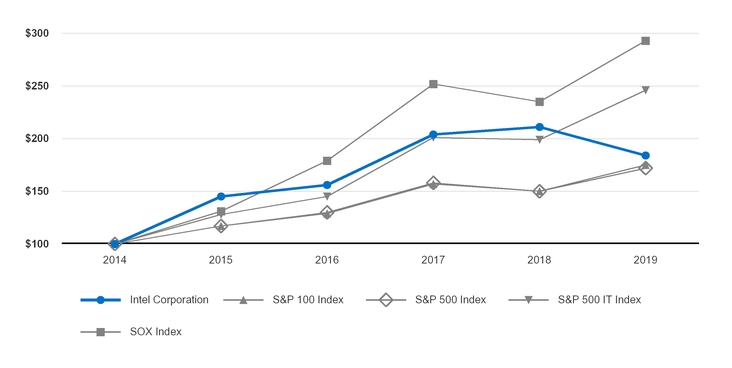
 OTHER KEY INFORMATION OTHER KEY INFORMATION | 61 | |
Years Ended | Dec 27, 2014 | Dec 26, 2015 | Dec 31, 2016 | Dec 30, 2017 | Dec 29, 2018 | Dec 28, 2019 | ||||||||||||||||||
Intel Corporation | $ | 100 | $ | 96 | $ | 103 | $ | 135 | $ | 140 | $ | 184 | ||||||||||||
S&P 100 Index | $ | 100 | $ | 102 | $ | 113 | $ | 137 | $ | 131 | $ | 175 | ||||||||||||
S&P 500 Index | $ | 100 | $ | 101 | $ | 112 | $ | 136 | $ | 129 | $ | 172 | ||||||||||||
S&P 500 IT Index | $ | 100 | $ | 104 | $ | 118 | $ | 163 | $ | 161 | $ | 246 | ||||||||||||
SOX Index | $ | 100 | $ | 99 | $ | 135 | $ | 190 | $ | 177 | $ | 293 | ||||||||||||
1 | The graph and table assume that $100 was invested on the last day of trading for the fiscal year ended December 27, 2014 in Intel's common stock, the S&P 100 Index, S&P 500 Index, S&P 500 IT Index, and PHLX Semiconductor Sector Index (SOX), and that all dividends were reinvested. |
ISSUER PURCHASES OF EQUITY SECURITIES
We have an ongoing authorization, originally approved by our Board of Directors in 2005, and subsequently amended, to repurchase shares of our common stock in open market or negotiated transactions. As of December 28, 2019, we were authorized to repurchase up to $110.0 billion, of which $23.8 billion remained available. This amount includes an increase of $20.0 billion in the authorization limit approved by our Board of Directors in October 2019.
Common stock repurchase activity under our publicly announced stock repurchase program during each quarter of 2019 was as follows:
Period | Total Number of Shares Purchased (In Millions) | Average Price Paid Per Share | Dollar Value of Shares That May Yet Be Purchased Under the Program (In Millions) | ||||||||
December 30, 2018 - March 30, 2019 | 49.5 | $ | 49.49 | $ | 14,883 | ||||||
March 31, 2019 - June 29, 2019 | 67.2 | $ | 46.78 | $ | 11,739 | ||||||
June 30, 2019 - September 28, 2019 | 92.0 | $ | 48.78 | $ | 7,249 | ||||||
September 29, 2019 - December 28, 2019 | 63.0 | $ | 55.32 | $ | 23,768 | ||||||
Total | 271.7 | ||||||||||
Common stock repurchase activity under our stock repurchase program during Q4 2019 was as follows:
Period | Total Number of Shares Purchased (In Millions) | Average Price Paid Per Share | Dollar Value of Shares That May Yet Be Purchased Under the Program (In Millions) | ||||||||
September 29, 2019 - October 26, 2019 | 24.0 | $ | 51.37 | $ | 26,021 | ||||||
October 27, 2019 - November 23, 2019 | 16.2 | $ | 57.67 | $ | 25,088 | ||||||
November 24, 2019 - December 28, 2019 | 22.8 | $ | 57.79 | $ | 23,768 | ||||||
Total | 63.0 | ||||||||||
We issue RSUs as part of our equity incentive plans. In our Consolidated Financial Statements, we treat shares of common stock withheld for tax purposes on behalf of our employees in connection with the vesting of RSUs as common stock repurchases because they reduce the number of shares that would have been issued upon vesting. These withheld shares of common stock are not considered common stock repurchases under our authorized common stock repurchase plan, and accordingly are not included in the common stock repurchase totals in the preceding table.
 OTHER KEY INFORMATION OTHER KEY INFORMATION | 62 | |
INFORMATION ABOUT OUR EXECUTIVE OFFICERS
EXECUTIVE OFFICERS (as of January 23, 2020) | AGE | OFFICE(S) | ||
Gregory M. Bryant | 51 | Executive Vice President; General Manager, Client Computing Group | ||
George S. Davis | 62 | Chief Financial Officer | ||
Dr. Venkata S.M. Renduchintala | 54 | Executive Vice President; Group President, Technology, Systems Architecture and Client Group; Chief Engineering Officer | ||
Steven R. Rodgers | 54 | Executive Vice President; General Counsel | ||
Navin Shenoy | 46 | Executive Vice President; General Manager, Data Platforms Group | ||
Robert H. Swan | 59 | Chief Executive Officer | ||
Gregory M. Bryant is our Executive Vice President and General Manager of the Client Computing Group, leading strategy and product development for client computing end-user solutions, including notebooks, desktops, and client adjacencies. Mr. Bryant served as Senior Vice President and General Manager of CCG from June 2017 to September 2019. From January 2015 to June 2017, he served as Corporate Vice President and General Manager of the Connected Home and Commercial Client Group within CCG. Prior to that, he was Vice President and General Manager for the Asia Pacific and Japan region from 2012 to 2015. From 2010 to 2012, he was a Vice President in the Sales and Marketing Group, and from 2007 to 2010, he was a Vice President in the Digital Enterprise Group. Mr. Bryant joined Intel in 1992 and has also held engineering, operations, and director roles in Intel’s information technology organization.
George S. Davis joined Intel in April 2019 as our Executive Vice President and Chief Financial Officer. He oversees Intel’s global finance and information technology organizations. Prior to joining Intel, Mr. Davis was Executive Vice President and Chief Financial Officer of Qualcomm, a global provider of wireless technologies, from March 2013 to April 2019, where he led the finance, information technology, and investor relations organizations. Before that, Mr. Davis was Chief Financial Officer of Applied Materials, Inc. from November 2006 to March 2013. He held several other leadership positions at Applied Materials from November 1999 to November 2006. Prior to joining Applied Materials, Mr. Davis served for 19 years with Atlantic Richfield Company in a number of finance and other corporate positions.
Dr. Venkata S.M. (“Murthy”) Renduchintala serves as our Executive Vice President; Group President of our Technology, Systems Architecture and Client Group and Chief Engineering Officer. In this role, Dr. Renduchintala oversees Intel's major technology, engineering, and manufacturing functions, including semiconductor process technology, manufacturing and operations, systems and product architecture, IP development, design and SoC engineering, software and security, and Intel Labs. Dr. Renduchintala joined Intel in November 2015 as Executive Vice President and President, Client and Internet of Things Businesses and System Architecture Group, which evolved into the Technology, Systems Architecture and Client Group in 2018, and he was named Executive Vice President; Group President and Chief Engineering Officer in April 2017. From 2004 to 2015, Dr. Renduchintala held various senior positions at Qualcomm, most recently as Co-President of Qualcomm CDMA Technologies from June 2012 to November 2015 and Executive Vice President of Qualcomm Technologies Inc. from October 2012 to November 2015. Before joining Qualcomm, Dr. Renduchintala served as Vice President and General Manager of the Cellular Systems Division of Skyworks Solutions Inc./Conexant Systems Inc. and he spent a decade with Philips Electronics, where he held various positions, including Vice President of Engineering for its consumer communications business. Dr. Renduchintala also serves on the board of directors of Accenture plc.
Steven R. Rodgers has been our Executive Vice President and General Counsel since January 2017 and oversees our legal, government, and China groups. He previously led our legal and government groups as Senior Vice President and General Counsel from January 2015 to January 2017 and as Corporate Vice President and General Counsel from June 2014 to January 2015. Mr. Rodgers joined Intel in 2000 and has held a number of roles in our legal department, including as Corporate Vice President and Deputy General Counsel from January 2014 until his appointment as Intel's fifth General Counsel in June 2014. Prior to joining Intel, Mr. Rodgers was a litigation partner at the firm of Brown & Bain, P.A.
 OTHER KEY INFORMATION OTHER KEY INFORMATION | 63 | |
Navin Shenoy is our Executive Vice President and General Manager of our Data Platforms Group. In this role, he oversees our DCG, IOTG, and PSG segments and leads strategy and product development for most of our data-centric offerings, including server, network, storage, AI, Internet of Things, and FPGA products, across a range of use cases that include cloud computing, virtualization of network infrastructure, and AI adoption. Mr. Shenoy has served in this role since May 2017, and his organization was renamed to the Data Platforms Group, from the Data Center Group, in November 2019. From May 2016 to May 2017, Mr. Shenoy was Senior Vice President and General Manager of CCG. From April 2012 to April 2016, he served as General Manager of the Mobility Client Platform Division, as Vice President from April 2012 until December 2014 and Corporate Vice President from January 2015 to May 2016. From October 2007 to April 2012, Mr. Shenoy served as Vice President and General Manager of our Asia-Pacific business. Mr. Shenoy joined Intel in 1995.
Robert ("Bob") H. Swan was appointed our seventh Chief Executive Officer and a member of our Board of Directors on January 30, 2019. Mr. Swan served as our Executive Vice President, Chief Financial Officer since joining Intel in October 2016 until January 2019, and he served as our interim Chief Executive Officer from June 2018 until January 2019. Prior to joining Intel, Mr. Swan served as an Operating Partner at General Atlantic LLC, a private equity firm, from September 2015 to September 2016. He served as Senior Vice President, Finance and Chief Financial Officer of eBay Inc. from March 2006 to July 2015. Previously, Mr. Swan served as Executive Vice President, Chief Financial Officer of Electronic Data Systems Corporation, Executive Vice President, Chief Financial Officer of TRW Inc., as well as Chief Financial Officer, Chief Operating Officer, and Chief Executive Officer of Webvan Group, Inc. Mr. Swan began his career in 1985 at General Electric, serving for 15 years in numerous senior finance roles. Mr. Swan also serves on the board of directors of eBay.
AVAILABILITY OF COMPANY INFORMATION
Intel was incorporated in California in 1968 and reincorporated in Delaware in 1989. Our Internet address is www.intel.com. We publish voluntary reports on our website that outline our performance with respect to corporate responsibility, including environmental, health, and safety compliance.
We use our Investor Relations website, www.intc.com, as a routine channel for distribution of important information, including news releases, analyst presentations, financial information, corporate governance practices, and corporate responsibility information. We post our filings at www.intc.com/sec the same day they are electronically filed with, or furnished to, the SEC, including our annual and quarterly reports on Forms 10-K and 10-Q and current reports on Form 8-K; our proxy statements; and any amendments to those reports or statements. We post our quarterly and annual earnings results at www.intc.com/results.cfm, and do not distribute our financial results via a news wire service. All such postings and filings are available on our Investor Relations website free of charge. In addition, our Investor Relations website allows interested persons to sign up to automatically receive e-mail alerts when we post financial information.
The content on any website referred to in this Form 10-K is not incorporated by reference in this Form 10-K unless expressly noted.
 OTHER KEY INFORMATION OTHER KEY INFORMATION | 64 | |
FINANCIAL STATEMENTS AND SUPPLEMENTAL DETAILS
We have defined certain terms and abbreviations used throughout our Form 10-K in "Key Terms" within the Financial Statements and Supplemental Details.
INDEX TO CONSOLIDATED FINANCIAL STATEMENTS | Page |
Reports of Independent Registered Public Accounting Firm | |
Consolidated Statements of Income | |
Consolidated Statements of Comprehensive Income | |
Consolidated Balance Sheets | |
Consolidated Statements of Cash Flows | |
Consolidated Statements of Stockholders’ Equity | |
Notes to Consolidated Financial Statements | |
Basis | |
Note 1: Basis of Presentation | |
Note 2: Accounting Policies | |
Note 3: Recent Accounting Standards | |
Performance and Operations | |
Note 4: Operating Segments | |
Note 5: Earnings Per Share | |
Note 6: Contract Liabilities | |
Note 7: Other Financial Statement Details | |
Note 8: Restructuring and Other Charges | |
Note 9: Income Taxes | |
Investments, Long-term Assets and Debt | |
Note 10: Investments | |
Note 11: Acquisitions and Divestitures | |
Note 12: Goodwill | |
Note 13: Identified Intangible Assets | |
Note 14: Borrowings | |
Note 15: Fair Value | |
Risk Management and Other | |
Note 16: Other Comprehensive Income (Loss) | |
Note 17: Derivative Financial Instruments | |
Note 18: Retirement Benefit Plans | |
Note 19: Employee Equity Incentive Plans | |
Note 20: Commitments and Contingencies | |
Key Terms | |
INDEX TO SUPPLEMENTAL DETAILS | |
Financial Information by Quarter | |
Controls and Procedures | |
Exhibits | |
Form 10-K Cross-Reference Index | |
 | 65 | |
REPORT OF INDEPENDENT REGISTERED PUBLIC ACCOUNTING FIRM |
TO THE STOCKHOLDERS AND THE BOARD OF DIRECTORS OF INTEL CORPORATION
Opinion on the Financial Statements
We have audited the accompanying Consolidated Balance Sheets of Intel Corporation (the Company) as of December 28, 2019 and December 29, 2018, the related Consolidated Statements of Income, Comprehensive Income, Cash Flows and Stockholders' Equity for each of the three years in the period ended December 28, 2019, and the related notes (collectively referred to as the "Consolidated Financial Statements"). In our opinion, the Consolidated Financial Statements present fairly, in all material respects, the financial position of the Company at December 28, 2019 and December 29, 2018, and the results of its operations and its cash flows for each of the three years in the period ended December 28, 2019, in conformity with U.S. generally accepted accounting principles.
We also have audited, in accordance with the standards of the Public Company Accounting Oversight Board (United States) (PCAOB), the Company’s internal control over financial reporting as of December 28, 2019, based on criteria established in Internal Control—Integrated Framework issued by the Committee of Sponsoring Organizations of the Treadway Commission (2013 framework) and our report dated January 23, 2020 expressed an unqualified opinion thereon.
Basis for Opinion
These financial statements are the responsibility of the Company's management. Our responsibility is to express an opinion on the Company's financial statements based on our audits. We are a public accounting firm registered with the PCAOB and are required to be independent with respect to the Company in accordance with the U.S. federal securities laws and the applicable rules and regulations of the Securities and Exchange Commission and the PCAOB.
We conducted our audits in accordance with the standards of the PCAOB. Those standards require that we plan and perform the audit to obtain reasonable assurance about whether the financial statements are free of material misstatement, whether due to error or fraud. Our audits included performing procedures to assess the risks of material misstatement of the financial statements, whether due to error or fraud, and performing procedures that respond to those risks. Such procedures included examining, on a test basis, evidence regarding the amounts and disclosures in the financial statements. Our audits also included evaluating the accounting principles used and significant estimates made by management, as well as evaluating the overall presentation of the financial statements. We believe that our audits provide a reasonable basis for our opinion.
Critical Audit Matter
The critical audit matter communicated below is a matter arising from the current period audit of the financial statements that was communicated or required to be communicated to the audit committee and that: (1) relates to accounts or disclosures that are material to the financial statements and (2) involved our especially challenging, subjective or complex judgments. The communication of the critical audit matter does not alter in any way our opinion on the Consolidated Financial Statements, taken as a whole, and we are not, by communicating the critical audit matter below, providing a separate opinion on the critical audit matter or on the accounts or disclosures to which it relates.
 AUDITOR'S REPORTS AUDITOR'S REPORTS | 66 | |
Inventory Valuation | ||
Description of the Matter | The Company’s net inventory totaled $8.7 billion as of December 28, 2019, representing 6.4% of total assets. As explained in "Note 2: Accounting Policies" within the Consolidated Financial Statements, the Company computes inventory cost on a first-in, first-out basis, and applies judgment in determining saleability of products and the valuation of inventories. The Company assesses inventory at each reporting date in order to assert that it is recorded at net realizable value, giving consideration to, among other factors: whether the products have achieved the substantive engineering milestones to qualify for sale to customers; the determination of normal capacity levels in its manufacturing process to determine which manufacturing overhead costs can be included in the valuation of inventory; whether the product is valued at the lower of cost or net realizable value; and the estimation of excess and obsolete inventory or that which is not of saleable quality. | |
Auditing management’s assessment of net realizable value for inventory was challenging because the determination of lower of cost or net realizable value and excess and obsolete inventory reserves is highly judgmental and considers a number of factors that are affected by market and economic conditions, such as customer forecasts, dynamic pricing environments, and industry supply and demand. Additionally, for certain new product launches there is limited historical data with which to evaluate forecasts. | ||
How We Addressed the Matter in Our Audit | We evaluated and tested the design and operating effectiveness of the Company’s internal controls over the costing of inventory, the determination of whether inventory is of salable quality, the calculation of lower of cost or net realizable value reserves including related estimated costs and selling prices, and the determination of demand forecasts and related application against on hand inventory. | |
Our audit procedures included, among others, testing the significant assumptions (e.g., estimated product costs and selling prices, and product demand forecasts) and the underlying data used in management’s inventory valuation assessment. We compared the significant assumptions used by management to current industry and economic trends. We assessed whether there were any potential sources of contrary information, including historical forecast accuracy or history of significant revisions to previously recorded inventory valuation adjustments, and performed sensitivity analyses over significant assumptions to evaluate the changes in inventory valuation that would result from changes in the assumptions. | ||
/s/ Ernst & Young LLP
We have served as the Company's auditor since 1968.
San Jose, California
January 23, 2020
 AUDITOR'S REPORTS AUDITOR'S REPORTS | 67 | |
REPORT OF INDEPENDENT REGISTERED PUBLIC ACCOUNTING FIRM |
TO THE STOCKHOLDERS AND THE BOARD OF DIRECTORS OF INTEL CORPORATION
Opinion on Internal Control Over Financial Reporting
We have audited Intel Corporation’s internal control over financial reporting as of December 28, 2019, based on criteria established in Internal Control—Integrated Framework issued by the Committee of Sponsoring Organizations of the Treadway Commission (2013 framework), (the COSO criteria). In our opinion, Intel Corporation (the Company) maintained, in all material respects, effective internal control over financial reporting as of December 28, 2019, based on the COSO criteria.
We also have audited, in accordance with the standards of the Public Company Accounting Oversight Board (United States) (PCAOB), the 2019 Consolidated Financial Statements of the Company and our report dated January 23, 2020 expressed an unqualified opinion thereon.
Basis for Opinion
The Company’s management is responsible for maintaining effective internal control over financial reporting and for its assessment of the effectiveness of internal control over financial reporting included in the accompanying Management Report on Internal Control Over Financial Reporting. Our responsibility is to express an opinion on the Company's internal control over financial reporting based on our audit. We are a public accounting firm registered with the PCAOB and are required to be independent with respect to the Company in accordance with the U.S. federal securities laws and the applicable rules and regulations of the Securities and Exchange Commission and the PCAOB.
We conducted our audit in accordance with the standards of the PCAOB. Those standards require that we plan and perform the audit to obtain reasonable assurance about whether effective internal control over financial reporting was maintained in all material respects.
Our audit included obtaining an understanding of internal control over financial reporting, assessing the risk that a material weakness exists, testing and evaluating the design and operating effectiveness of internal control based on the assessed risk, and performing such other procedures as we considered necessary in the circumstances. We believe that our audit provides a reasonable basis for our opinion.
Definition and Limitations of Internal Control Over Financial Reporting
A company‘s internal control over financial reporting is a process designed to provide reasonable assurance regarding the reliability of financial reporting and the preparation of financial statements for external purposes in accordance with generally accepted accounting principles. A company’s internal control over financial reporting includes those policies and procedures that (1) pertain to the maintenance of records that, in reasonable detail, accurately and fairly reflect the transactions and dispositions of the assets of the company; (2) provide reasonable assurance that transactions are recorded as necessary to permit preparation of financial statements in accordance with generally accepted accounting principles, and that receipts and expenditures of the company are being made only in accordance with authorizations of management and directors of the company; and (3) provide reasonable assurance regarding prevention or timely detection of unauthorized acquisition, use, or disposition of the company's assets that could have a material effect on the financial statements.
Because of its inherent limitations, internal control over financial reporting may not prevent or detect misstatements. Also, projections of any evaluation of effectiveness to future periods are subject to the risk that controls may become inadequate because of changes in conditions, or that the degree of compliance with the policies or procedures may deteriorate.
/s/ Ernst & Young LLP
San Jose, California
January 23, 2020
 AUDITOR'S REPORTS AUDITOR'S REPORTS | 68 | |
CONSOLIDATED STATEMENTS OF INCOME |
Years Ended (In Millions, Except Per Share Amounts) | Dec 28, 2019 | Dec 29, 2018 | Dec 30, 2017 | |||||||||
Net revenue | $ | $ | $ | |||||||||
Cost of sales | ||||||||||||
Gross margin | ||||||||||||
Research and development | ||||||||||||
Marketing, general and administrative | ||||||||||||
Restructuring and other charges | ( | ) | ||||||||||
Amortization of acquisition-related intangibles | ||||||||||||
Operating expenses | ||||||||||||
Operating income | ||||||||||||
Gains (losses) on equity investments, net | ( | ) | ||||||||||
Interest and other, net | ( | ) | ||||||||||
Income before taxes | ||||||||||||
Provision for taxes | ||||||||||||
Net income | $ | $ | $ | |||||||||
Earnings per share—Basic | $ | $ | $ | |||||||||
Earnings per share—Diluted | $ | $ | $ | |||||||||
Weighted average shares of common stock outstanding: | ||||||||||||
Basic | ||||||||||||
Diluted | ||||||||||||
See accompanying notes.
 FINANCIAL STATEMENTS FINANCIAL STATEMENTS | Consolidated Statements of Income | 69 |
CONSOLIDATED STATEMENTS OF COMPREHENSIVE INCOME | |
Years Ended (In Millions) | Dec 28, 2019 | Dec 29, 2018 | Dec 30, 2017 | |||||||||
Net income | $ | $ | $ | |||||||||
Changes in other comprehensive income, net of tax: | ||||||||||||
Net unrealized holding gains (losses) on available-for-sale equity investments | ( | ) | ||||||||||
Net unrealized holding gains (losses) on derivatives | ( | ) | ||||||||||
Actuarial valuation and other pension benefits (expenses), net | ( | ) | ||||||||||
Translation adjustments and other | ( | ) | ||||||||||
Other comprehensive income (loss) | ( | ) | ( | ) | ||||||||
Total comprehensive income | $ | $ | $ | |||||||||
See accompanying notes.
 FINANCIAL STATEMENTS FINANCIAL STATEMENTS | Consolidated Statements of Comprehensive Income | 70 |
CONSOLIDATED BALANCE SHEETS |
(In Millions, Except Par Value) | Dec 28, 2019 | Dec 29, 2018 | ||||||
Assets | ||||||||
Current assets: | ||||||||
Cash and cash equivalents | $ | $ | ||||||
Short-term investments | ||||||||
Trading assets | ||||||||
Accounts receivable, net of allowance for doubtful accounts | ||||||||
Inventories | ||||||||
Other current assets | ||||||||
Total current assets | ||||||||
Property, plant and equipment, net | ||||||||
Equity investments | ||||||||
Other long-term investments | ||||||||
Goodwill | ||||||||
Identified intangible assets, net | ||||||||
Other long-term assets | ||||||||
Total assets | $ | $ | ||||||
Liabilities, temporary equity, and stockholders’ equity | ||||||||
Current liabilities: | ||||||||
Short-term debt | $ | $ | ||||||
Accounts payable | ||||||||
Accrued compensation and benefits | ||||||||
Other accrued liabilities | ||||||||
Total current liabilities | ||||||||
Debt | ||||||||
Contract liabilities | ||||||||
Income taxes payable, non-current | ||||||||
Deferred income taxes | ||||||||
Other long-term liabilities | ||||||||
Commitments and Contingencies (Note 20) | ||||||||
Temporary equity | ||||||||
Stockholders’ equity: | ||||||||
Preferred stock, $0.001 par value, 50 shares authorized; none issued | ||||||||
Common stock, $0.001 par value, 10,000 shares authorized; 4,290 shares issued and outstanding (4,516 issued and outstanding in 2018) and capital in excess of par value | ||||||||
Accumulated other comprehensive income (loss) | ( | ) | ( | ) | ||||
Retained earnings | ||||||||
Total stockholders’ equity | ||||||||
Total liabilities, temporary equity, and stockholders’ equity | $ | $ | ||||||
See accompanying notes.
 FINANCIAL STATEMENTS FINANCIAL STATEMENTS | Consolidated Balance Sheets | 71 |
CONSOLIDATED STATEMENTS OF CASH FLOWS |
Years Ended (In Millions) | Dec 28, 2019 | Dec 29, 2018 | Dec 30, 2017 | |||||||||
Cash and cash equivalents, beginning of period | $ | $ | $ | |||||||||
Cash flows provided by (used for) operating activities: | ||||||||||||
Net income | ||||||||||||
Adjustments to reconcile net income to net cash provided by operating activities: | ||||||||||||
Depreciation | ||||||||||||
Share-based compensation | ||||||||||||
Amortization of intangibles | ||||||||||||
(Gains) losses on equity investments, net | ( | ) | ( | ) | ||||||||
(Gains) losses on divestitures | ( | ) | ( | ) | ( | ) | ||||||
Changes in assets and liabilities: | ||||||||||||
Accounts receivable | ( | ) | ( | ) | ( | ) | ||||||
Inventories | ( | ) | ( | ) | ( | ) | ||||||
Accounts payable | ||||||||||||
Accrued compensation and benefits | ( | ) | ||||||||||
Customer deposits and prepaid supply agreements | ( | ) | ||||||||||
Income taxes | ( | ) | ||||||||||
Other assets and liabilities | ( | ) | ||||||||||
Total adjustments | ||||||||||||
Net cash provided by operating activities | ||||||||||||
Cash flows provided by (used for) investing activities: | ||||||||||||
Additions to property, plant and equipment | ( | ) | ( | ) | ( | ) | ||||||
Acquisitions, net of cash acquired | ( | ) | ( | ) | ( | ) | ||||||
Purchases of available-for-sale debt investments | ( | ) | ( | ) | ( | ) | ||||||
Sales of available-for-sale debt investments | ||||||||||||
Maturities of available-for-sale debt investments | ||||||||||||
Purchases of trading assets | ( | ) | ( | ) | ( | ) | ||||||
Maturities and sales of trading assets | ||||||||||||
Purchases of equity investments | ( | ) | ( | ) | ( | ) | ||||||
Sales of equity investments | ||||||||||||
Proceeds from divestitures | ||||||||||||
Other investing | ( | ) | ||||||||||
Net cash used for investing activities | ( | ) | ( | ) | ( | ) | ||||||
Cash flows provided by (used for) financing activities: | ||||||||||||
Issuance of long-term debt, net of issuance costs | ||||||||||||
Repayment of debt and debt conversion | ( | ) | ( | ) | ( | ) | ||||||
Proceeds from sales of common stock through employee equity incentive plans | ||||||||||||
Repurchase of common stock | ( | ) | ( | ) | ( | ) | ||||||
Payment of dividends to stockholders | ( | ) | ( | ) | ( | ) | ||||||
Other financing | ( | ) | ( | ) | ||||||||
Net cash provided by (used for) financing activities | ( | ) | ( | ) | ( | ) | ||||||
Net increase (decrease) in cash and cash equivalents | ( | ) | ( | ) | ||||||||
Cash and cash equivalents, end of period | $ | $ | $ | |||||||||
Supplemental disclosures: | ||||||||||||
Acquisition of property, plant and equipment included in accounts payable and accrued liabilities | $ | $ | $ | |||||||||
Cash paid during the year for: | ||||||||||||
Interest, net of capitalized interest | $ | $ | $ | |||||||||
Income taxes, net of refunds | $ | $ | $ | |||||||||
See accompanying notes.
 FINANCIAL STATEMENTS FINANCIAL STATEMENTS | Consolidated Statements of Cash Flows | 72 |
CONSOLIDATED STATEMENTS OF STOCKHOLDERS' EQUITY |
Common Stock and Capital in Excess of Par Value | Accumulated Other Comprehensive Income (Loss) | Retained Earnings | Total | ||||||||||||||||
(In Millions, Except Per Share Amounts) | Number of Shares | Amount | |||||||||||||||||
Balance as of December 31, 2016 | $ | $ | $ | $ | |||||||||||||||
Components of comprehensive income, net of tax: | |||||||||||||||||||
Net income | — | — | — | ||||||||||||||||
Other comprehensive income (loss) | — | — | — | ||||||||||||||||
Total comprehensive income | |||||||||||||||||||
Employee equity incentive plans and other ¹ | — | ( | ) | ||||||||||||||||
Share-based compensation | — | — | — | ||||||||||||||||
Convertible debt | — | ( | ) | — | — | ( | ) | ||||||||||||
Repurchase of common stock | ( | ) | ( | ) | — | ( | ) | ( | ) | ||||||||||
Restricted stock unit withholdings | ( | ) | ( | ) | — | ( | ) | ( | ) | ||||||||||
Cash dividends declared ($1.0775 per share of common stock) | — | — | — | ( | ) | ( | ) | ||||||||||||
Balance as of December 30, 2017 | |||||||||||||||||||
Adjustment to opening balance for change in accounting principle | — | — | ( | ) | |||||||||||||||
Opening balance as of December 31, 2017 | ( | ) | |||||||||||||||||
Components of comprehensive income, net of tax: | |||||||||||||||||||
Net income | — | — | — | ||||||||||||||||
Other comprehensive income (loss) | — | — | ( | ) | — | ( | ) | ||||||||||||
Total comprehensive income | |||||||||||||||||||
Employee equity incentive plans and other ¹ | — | — | |||||||||||||||||
Share-based compensation | — | — | — | ||||||||||||||||
Temporary equity reduction | — | — | |||||||||||||||||
Convertible debt | — | ( | ) | — | — | ( | ) | ||||||||||||
Repurchase of common stock | ( | ) | ( | ) | — | ( | ) | ( | ) | ||||||||||
Restricted stock unit withholdings | ( | ) | ( | ) | — | ( | ) | ( | ) | ||||||||||
Cash dividends declared ($1.20 per share of common stock) | — | — | — | ( | ) | ( | ) | ||||||||||||
Balance as of December 29, 2018 | ( | ) | |||||||||||||||||
Components of comprehensive income, net of tax: | |||||||||||||||||||
Net income | — | — | — | ||||||||||||||||
Other comprehensive income (loss) | — | — | ( | ) | — | ( | ) | ||||||||||||
Total comprehensive income | |||||||||||||||||||
Employee equity incentive plans and other | — | — | |||||||||||||||||
Share-based compensation | — | — | — | ||||||||||||||||
Temporary equity reduction | — | — | — | ||||||||||||||||
Convertible debt | — | ( | ) | — | — | ( | ) | ||||||||||||
Repurchase of common stock | ( | ) | ( | ) | — | ( | ) | ( | ) | ||||||||||
Restricted stock unit withholdings | ( | ) | ( | ) | — | ( | ) | ( | ) | ||||||||||
Cash dividends declared ($1.26 per share of common stock) | — | — | — | ( | ) | ( | ) | ||||||||||||
Balance as of December 28, 2019 | $ | $ | ( | ) | $ | $ | |||||||||||||
1 | Includes approximately $ |
See accompanying notes.
 FINANCIAL STATEMENTS FINANCIAL STATEMENTS | Consolidated Statements of Stockholders' Equity | 73 |
NOTES TO CONSOLIDATED FINANCIAL STATEMENTS |
NOTE 1 : | BASIS OF PRESENTATION |
We have a 52- or 53-week fiscal year that ends on the last Saturday in December. Fiscal years 2019, 2018, and 2017 were 52-week fiscal years. Our Consolidated Financial Statements include the accounts of Intel and our subsidiaries. We have eliminated intercompany accounts and transactions. We have reclassified certain prior period amounts to conform to current period presentation.
USE OF ESTIMATES
The preparation of Consolidated Financial Statements in conformity with U.S. GAAP requires us to make estimates and judgments that affect the amounts reported in our Consolidated Financial Statements and the accompanying notes. The actual results that we experience may differ materially from our estimates.
NOTE 2 : | ACCOUNTING POLICIES |
REVENUE RECOGNITION
We recognize net product revenue when we satisfy performance obligations as evidenced by the transfer of control of our products or services to customers. Substantially all of our revenue is derived from product sales. In accordance with contract terms, revenue for product sales is recognized at the time of product shipment from our facilities or delivery to the customer location, as determined by the agreed upon shipping terms. Prior to 2018, we deferred product revenue and related costs of sales on sales made to distributors that allowed for price protections or right of return until the distributor sold through the merchandise. We include shipping charges billed to customers in net revenue, and include the related shipping costs in cost of sales.
We measure revenue based on the amount of consideration we expect to be entitled to in exchange for products or services. Variable consideration is estimated and reflected as an adjustment to the transaction price. We determine variable consideration, which consists primarily of various sales price concessions, by estimating the most likely amount of consideration we expect to receive from the customer based on historical analysis of customer purchase volumes. Sales rebates earned by customers are offset against their receivable balances. Rebates earned by customers when they do not have outstanding receivable balances are recorded within other accrued liabilities. The impacts of distributor sales price reductions resulting from price protection agreements are also estimated based on historical analysis of such activity and are reflected as a reduction in net revenue.
INVENTORIES
We compute inventory cost on a first-in, first-out basis. Our process and product development life cycle corresponds with substantive engineering milestones. These engineering milestones are regularly and consistently applied in assessing the point at which our activities and associated costs change in nature from R&D to cost of sales, and when cost of sales can be capitalized as inventory.
For a product to be manufactured in high volumes and sold to our customers under our standard warranty, it must meet our rigorous technical quality specifications. This milestone is known as PRQ. We have identified PRQ as the point at which the costs incurred to manufacture our products are included in the valuation of inventory. Prior to PRQ, costs that do not meet the criteria for R&D are included in cost of sales in the period incurred. A single PRQ has previously ranged up to $870 million for our high-volume products.
The valuation of inventory includes determining which fixed production overhead costs can be included in inventory based on the normal capacity of our manufacturing and assembly and test facilities. We apply our historical loadings compared to our total available capacity in a statistical model to determine our normal capacity level. If the factory loadings are below the established normal capacity level, a portion of our fixed production overhead costs would not be included in the cost of inventory; instead, it would be recognized as cost of sales in that period. We refer to these costs as excess capacity charges. Excess capacity charges are insignificant in the years presented. Charges in years prior to those presented have ranged up to $1.1 billion taken in connection with the 2009 economic recession.
 FINANCIAL STATEMENTS FINANCIAL STATEMENTS | Notes to Financial Statements | 74 |
Inventory is valued at the lower of cost or net realizable value, based upon assumptions about future demand and market conditions. Product-specific facts and circumstances reviewed in the inventory valuation process include a review of our customer base, the stage of the product life cycle, variations in market pricing, and an assessment of selling price in relation to product cost. Lower of cost or net realizable value inventory reserves fluctuate as we ramp new process technologies with costs improving over time due to scale and improved yields. Additionally, inventory valuation is impacted by cyclical changes in market conditions and the associated pricing environment.
The valuation of inventory also requires us to estimate obsolete and excess inventory, as well as inventory that is not of salable quality. We use the demand forecast to develop our short-term manufacturing plans to enable consistency between inventory valuations and build decisions. For certain new products, we have limited historical data when developing these demand forecasts. We compare the estimate of future demand to work in process and finished goods inventory levels to determine the amount, if any, of obsolete or excess inventory. When our demand forecast for specific products is greater than actual demand and we fail to reduce manufacturing output accordingly, we are required to write off inventory.
PROPERTY, PLANT AND EQUIPMENT
We compute depreciation using the straight-line method over the estimated useful life of assets. We also capitalize interest on borrowings related to eligible capital expenditures. Capitalized interest is added to the cost of qualified assets and depreciated together with that asset cost. We record capital-related government grants earned as a reduction to property, plant and equipment.
We evaluate the period over which we expect to recover the economic value of our property, plant and equipment, considering factors such as the process technology cadence between node transitions, changes in machinery and equipment technology, and re-use of machinery and tools across each generation of process technology. As we make manufacturing process conversions and other factory planning decisions, we use assumptions involving the use of management judgments regarding the remaining useful lives of assets, primarily process-specific semiconductor manufacturing tools and building improvements. When we determine that the useful lives of assets are shorter or longer than we had originally estimated, we adjust the rate of depreciation to reflect the assets’ revised useful lives.
Assets are “grouped” and evaluated for impairment at the lowest level of identifiable cash flows. We assess property, plant and equipment for impairment when events or changes in circumstances indicate that the carrying value of the assets or the asset grouping may not be recoverable. Factors that we consider in deciding when to perform an impairment review include significant under-performance of a business or product line in relation to expectations, significant negative industry or economic trends, and significant changes or planned changes in our use of the assets. We measure the recoverability of assets that we will continue to use in our operations by comparing the carrying value of the asset grouping to our estimate of the related total future undiscounted net cash flows arising from the use of that asset grouping. If an asset grouping carrying value is not recoverable through the related undiscounted cash flows, the asset grouping is considered to be impaired. We measure the impairment by comparing the difference between the asset grouping carrying value and its fair value.
FAIR VALUE
When determining fair value, we consider the principal or most advantageous market in which we would transact, as well as assumptions that market participants would use when pricing the asset or liability. Our financial assets are measured and recorded at fair value on a recurring basis, except for equity securities measured using the measurement alternative, equity method investments, cost method loans receivable, grants receivable, and reverse repurchase agreements with original maturities greater than three months. We assess fair value hierarchy levels for our issued debt and fixed-income investment portfolio based on the underlying instrument type.
The three levels of inputs that may be used to measure fair value are:
• | Level 1. Quoted prices in active markets for identical assets or liabilities. We evaluate security-specific market data when determining whether a market is active. |
• | Level 2. Observable inputs other than Level 1 prices, such as quoted prices for similar assets or liabilities, quoted prices in less active markets, or model-derived valuations. All significant inputs used in our valuations, such as discounted cash flows, are observable or can be derived principally from or corroborated with observable market data for substantially the full term of the assets or liabilities. We use LIBOR-based yield curves, overnight indexed swap curve, currency spot and forward rates, and credit ratings as significant inputs in our valuations. Level 2 inputs also include non-binding market consensus prices, as well as quoted prices that were adjusted for security-specific restrictions. When we use non-binding market consensus prices, we corroborate them with quoted market prices for similar instruments or compare them to output from internally developed pricing models such as discounted cash flow models. |
• | Level 3. Unobservable inputs to the valuation methodology that are significant to the measurement of the fair value of assets or liabilities. We monitor and review the inputs and results of these valuation models to help ensure the fair value measurements are reasonable and consistent with market experience in similar asset classes. Level 3 inputs also include non-binding market consensus prices or non-binding broker quotes that we were unable to corroborate with observable market data. |
 FINANCIAL STATEMENTS FINANCIAL STATEMENTS | Notes to Financial Statements | 75 |
DEBT INVESTMENTS
We consider all highly liquid debt investments with original maturities from the date of purchase of three months or less as cash equivalents. Cash equivalents can include investments such as corporate debt, financial institution instruments, government debt, and reverse repurchase agreements.
Marketable debt investments are generally designated as trading assets when a market risk is economically hedged at inception with a related derivative instrument, or when the marketable debt investment itself is used to economically hedge currency exchange rate risk from remeasurement. Investments designated as trading assets are reported at fair value. Gains or losses on these investments arising from changes in fair value due to interest rate and currency market fluctuations and credit market volatility, largely offset by losses or gains on the related derivative instruments and balance sheet remeasurement, are recorded in interest and other, net.
Marketable debt investments are considered available-for-sale investments when the interest rate and foreign currency risks are not hedged at the inception of the investment or when our criteria for designation as trading assets are not met. Available-for-sale debt investments with original maturities of approximately three months or less from the date of purchase are classified within cash and cash equivalents. Available-for-sale debt investments with original maturities at the date of purchase greater than approximately three months and remaining maturities of less than one year are classified as short-term investments. Available-for-sale debt investments with remaining maturities beyond one year are classified as other long-term investments. Available-for-sale debt investments are reported at fair value, with unrealized gains or losses, net of tax, recorded in accumulated other comprehensive income (loss). We determine the cost of the investment sold based on an average cost basis at the individual security level, and record the interest income and realized gains or losses on the sale of these investments in interest and other, net.
Our available-for-sale debt investments are subject to periodic impairment reviews. For these investments, we consider whether it is more likely than not that we will be required to sell the investment before recovery of its amortized cost basis, or whether recovery of the entire amortized cost basis of the investment is unlikely because a credit loss exists. When we do not expect to recover the entire amortized cost basis of the investment, we separate other-than-temporary impairments into amounts representing credit losses, which are recognized in interest and other, net, and amounts not related to credit losses, which are recognized in other comprehensive income (loss).
EQUITY INVESTMENTS
We regularly invest in equity securities of public and private companies to promote business and strategic objectives. Equity investments are measured and recorded as follows:
• | Marketable equity securities are equity securities with RDFV that are measured and recorded at fair value on a recurring basis with changes in fair value, whether realized or unrealized, recorded through the income statement. Prior to 2018, these securities were classified as available-for-sale securities and measured and recorded at fair value with unrealized changes in fair value recorded through other comprehensive income. |
• | Non-marketable equity securities are equity securities without RDFV that are measured and recorded using a measurement alternative that measures the securities at cost minus impairment, if any, plus or minus changes resulting from qualifying observable price changes. Prior to fiscal 2018, these securities were accounted for using the cost method of accounting, measured at cost less other-than-temporary impairment. |
• | Equity method investments are equity securities in investees we do not control but over which we have the ability to exercise significant influence. Equity method investments are measured at cost minus impairment, if any, plus or minus our share of equity method investee income or loss. Our proportionate share of the income or loss from equity method investments is recognized on a one-quarter lag. |
Realized and unrealized gains and losses resulting from changes in fair value or the sale of our equity investments are recorded in gains (losses) on equity investments, net. Prior to 2018, we recorded unrealized gains and losses through other comprehensive income (loss) and realized gains and losses on the sale, exchange, or impairment of these equity investments through gains (losses) on equity investments, net. The carrying value of our non-marketable equity securities is adjusted for qualifying observable price changes resulting from the issuance of similar or identical securities by the same issuer. Determining whether an observed transaction is similar to a security within our portfolio requires judgment based on the rights and preferences of the securities. Recording upward and downward adjustments to the carrying value of our equity securities as a result of observable price changes requires quantitative assessments of the fair value of our securities using various valuation methodologies and involves the use of estimates.
Non-marketable equity securities and equity method investments (collectively referred to as non-marketable equity investments) are also subject to periodic impairment reviews. Our quarterly impairment analysis considers both qualitative and quantitative factors that may have a significant impact on the investee's fair value. Qualitative factors considered include the investee's financial condition and business outlook, industry and sector performance, market for technology, operational and financing cash flow activities, and other relevant events and factors affecting the investee. When indicators of impairment exist, we prepare quantitative assessments of the fair value of our non-marketable equity investments using both the market and income approaches, which require judgment and the use of estimates, including discount rates, investee revenue and costs, and comparable market data of private and public companies, among others.
 FINANCIAL STATEMENTS FINANCIAL STATEMENTS | Notes to Financial Statements | 76 |
• | Non-marketable equity securities are tested for impairment using a qualitative model similar to the model used for goodwill and long-lived assets. Upon determining that an impairment may exist, the security's fair value is calculated and compared to its carrying value and an impairment is recognized immediately if the carrying value exceeds the fair value. Prior to 2018, non-marketable equity securities were tested for impairment using the other-than-temporary impairment model. |
• | Equity method investments are subject to periodic impairment reviews using the other-than-temporary impairment model, which considers the severity and duration of a decline in fair value below cost and our ability and intent to hold the investment for a sufficient period of time to allow for recovery. |
Impairments of equity investments are recorded in gains (losses) on equity investments, net.
DERIVATIVE FINANCIAL INSTRUMENTS
Our primary objective for holding derivative financial instruments is to manage currency exchange rate risk and interest rate risk, and, to a lesser extent, equity market risk, commodity price risk, and credit risk. We enter into master netting arrangements to mitigate credit risk in derivative transactions by permitting net settlement of transactions with the same counterparty. A master netting arrangement allows counterparties to net settle amounts owed to each other as a result of multiple, separate derivative transactions. We also enter into collateral security arrangements with certain of our counterparties to exchange cash collateral when the net fair value of certain derivative instruments fluctuates from contractually established thresholds. We record the collateral within other current assets and other long-term assets with a corresponding liability. For presentation on our Consolidated Balance Sheets, we do not offset fair value amounts recognized for derivative instruments under master netting arrangements. Our derivative financial instruments are presented at fair value on a gross basis and are included in other current assets, other long-term assets, other accrued liabilities, or other long-term liabilities.
Cash flow hedges use foreign currency contracts, such as currency forwards and currency interest rate swaps, to hedge exposures for the following items:
• | variability in the U.S.-dollar equivalent of non-U.S.-dollar-denominated cash flows associated with our forecasted operating and capital purchases spending; and |
• | coupon and principal payments for our non-U.S.-dollar-denominated indebtedness. |
The after-tax gains or losses from the effective portion of a cash flow hedge is reported as a component of accumulated other comprehensive income (loss) and reclassified into earnings in the same period or periods in which the hedged transaction affects earnings, and in the same line item on the Consolidated Statements of Income as the impact of the hedge transaction. For foreign currency contracts hedging our capital purchases, forward points are excluded from the hedge effectiveness assessment, and are recognized in earnings in interest and other, net. If the cash flow hedge transactions become improbable, the corresponding amounts deferred in accumulated other comprehensive income (loss) would be immediately reclassified to interest and other, net. These derivatives are classified in the Consolidated Statements of Cash Flows in the same section as the underlying item.
Fair value hedges use interest rate contracts, such as interest rate swaps, to hedge against changes in the fair value on certain of our fixed-rate indebtedness attributable to changes in the benchmark interest rate. The gains or losses on these hedges, as well as the offsetting losses or gains related to the changes in the fair value of the underlying hedged item attributable to the hedged risk, are recognized in earnings in the current period, primarily in interest and other, net. These derivatives are classified in the Consolidated Statements of Cash Flows in the same section as the underlying item, primarily within cash flows from financing activities.
Non-designated hedges use foreign currency contracts to economically hedge the functional currency equivalent cash flows of recognized monetary assets and liabilities, non-U.S.-dollar-denominated debt instruments classified as trading assets, and non-U.S.-dollar-denominated loans receivables recognized at fair value. We also use interest rate contracts to hedge interest rate risk related to our U.S.-dollar-denominated fixed-rate debt instruments classified as trading assets.
LOANS RECEIVABLE
 FINANCIAL STATEMENTS FINANCIAL STATEMENTS | Notes to Financial Statements | 77 |
CREDIT RISK
Financial instruments that potentially subject us to concentrations of credit risk consist principally of investments in debt instruments, derivative financial instruments, loans receivable, reverse repurchase agreements, and trade receivables. We enter into master netting arrangements to mitigate credit risk in derivative transactions by permitting net settlement of transactions with the same counterparty.
We generally place investments with high-credit-quality counterparties and, by policy, we limit the amount of credit exposure to any one counterparty based on our analysis of that counterparty’s relative credit standing. As required per our investment policy, substantially all of our investments in debt instruments and financing receivables are in investment-grade instruments. Credit-rating criteria for derivative instruments are similar to those for other investments. Due to master netting arrangements, the amounts subject to credit risk related to derivative instruments are generally limited to the amounts, if any, by which the counterparty’s obligations exceed our obligations with that counterparty. As of December 28, 2019, our total credit exposure to any single counterparty, excluding money market funds invested in U.S. treasury and U.S. agency securities and reverse repurchase agreements collateralized by treasury and agency securities, did not exceed $800 million. To further reduce credit risk, we obtain and secure available collateral from counterparties against obligations, including securities lending transactions, when we deem it appropriate.
A substantial majority of our trade receivables are derived from sales to OEMs and ODMs. We also have accounts receivable derived from sales to industrial and communications equipment manufacturers in the computing and communications industries. We believe the net accounts receivable balances from our three largest customers (39 % as of December 28, 2019) do not represent a significant credit risk, based on cash flow forecasts, balance sheet analysis, and past collection experience. For more information about the customers that represent our accounts receivable balance, see "Note 4: Operating Segments."
We have adopted credit policies and standards intended to accommodate industry growth and inherent risk. We believe credit risks are moderated by the financial stability of our major customers. We assess credit risk through quantitative and qualitative analysis. From this analysis, we establish shipping and credit limits, and determine whether we will seek to use one or more credit support protection devices, such as obtaining a parent guarantee, standby letter of credit, or credit insurance.
BUSINESS COMBINATIONS
We allocate the purchase price paid for assets acquired and liabilities assumed in connection with our acquisitions based on their estimated fair values at the time of acquisition. This allocation involves a number of assumptions, estimates, and judgments in determining the fair value of the following:
• | intangible assets, including the valuation methodology, estimations of future cash flows, discount rates, market segment growth rates, and our assumed market segment share, as well as the estimated useful life of intangible assets; |
• | deferred tax assets and liabilities, uncertain tax positions, and tax-related valuation allowances, which are initially estimated as of the acquisition date; |
• | inventory; property, plant and equipment; pre-existing liabilities or legal claims; deferred revenue; and contingent consideration, each as may be applicable; and |
• | goodwill as measured as the excess of consideration transferred over the net of the acquisition date fair values of the assets acquired and the liabilities assumed. |
Our assumptions and estimates are based upon comparable market data and information obtained from our management and the management of the acquired companies. We allocate goodwill to the reporting units of the business that are expected to benefit from the business combination.
GOODWILL
We perform an annual impairment assessment of goodwill at the reporting unit level in the fourth quarter of each year, or more frequently if indicators of potential impairment exist. The analysis may include both qualitative and quantitative factors to assess the likelihood of an impairment. The reporting unit’s carrying value used in an impairment test represents the assignment of various assets and liabilities, excluding certain corporate assets and liabilities, such as cash, investments, and debt.
Qualitative factors include industry and market considerations, overall financial performance, and other relevant events and factors affecting the reporting unit. Additionally, as part of this assessment, we may perform a quantitative analysis to support the qualitative factors above by applying sensitivities to assumptions and inputs used in measuring a reporting unit’s fair value.
Our quantitative impairment test considers both the income approach and the market approach to estimate a reporting unit’s fair value. Significant estimates include market segment growth rates, our assumed market segment share, estimated costs, and discount rates based on a reporting unit's weighted average cost of capital.
 FINANCIAL STATEMENTS FINANCIAL STATEMENTS | Notes to Financial Statements | 78 |
IDENTIFIED INTANGIBLE ASSETS
We amortize acquisition-related intangible assets that are subject to amortization over their estimated useful life. Acquisition-related in-process R&D assets represent the fair value of incomplete R&D projects that had not reached technological feasibility as of the date of acquisition; initially, these are classified as in-process R&D and are not subject to amortization. Once these R&D projects are completed, the asset balances are transferred from in-process R&D to acquisition-related developed technology and are subject to amortization from this point forward. The asset balances relating to projects that are abandoned after acquisition are impaired and expensed to R&D.
EMPLOYEE EQUITY INCENTIVE PLANS
We use the straight-line amortization method to recognize share-based compensation expense over the service period of the award, net of estimated forfeitures. Upon exercise, cancellation, forfeiture, or expiration of stock options, or upon vesting or forfeiture of RSUs, we eliminate deferred tax assets for options and RSUs with multiple vesting dates for each vesting period on a first-in, first-out basis as if each vesting period were a separate award.
INCOME TAXES
We compute the provision for income taxes using the asset and liability method, under which deferred tax assets and liabilities are recognized for the expected future tax consequences of temporary differences between the financial reporting and tax bases of assets and liabilities, and for operating losses and tax credit carryforwards. We measure deferred tax assets and liabilities using the currently enacted tax rates that apply to taxable income in effect for the years in which those tax assets are expected to be realized or settled.
We assess the likelihood that we will be able to recover our deferred tax assets. If recovery is not likely, we must increase our provision for taxes by recording a valuation allowance against the deferred tax assets that we estimate will not ultimately be recoverable. We believe that we will ultimately recover the deferred tax assets recorded on our Consolidated Balance Sheets. Recovery of a portion of our deferred tax assets is affected by management’s plans with respect to holding or disposing of certain investments; therefore, such changes could also affect our future provision for taxes.
We recognize tax benefits from uncertain tax positions only if (based on the technical merits of the position) it is more likely than not that the tax positions will be sustained on examination by the tax authority. The tax benefits recognized in the financial statements from such positions are measured based on the largest amount that is more than 50% likely to be realized upon ultimate settlement. We recognize interest and penalties related to unrecognized tax benefits within the provision for taxes on the Consolidated Statements of Income.
LOSS CONTINGENCIES
We are subject to loss contingencies, including various legal and regulatory proceedings, asserted and potential claims, liabilities related to repair or replacement of parts in connection with product defects, as well as product warranties and potential asset impairments that arise in the ordinary course of business. An estimated loss from such contingencies is recognized as a charge to income if it is probable that a liability has been incurred and the amount of the loss can be reasonably estimated.
NOTE 3 : | RECENT ACCOUNTING STANDARDS |
ACCOUNTING STANDARDS ADOPTED
Leases
Standard/Description: This new lease accounting standard requires that we recognize leased assets and corresponding liabilities on the balance sheet and provide enhanced disclosure of lease activity.
Effective Date and Adoption Considerations: Effective in the first quarter of 2019. The standard was adopted applying the modified retrospective approach at the beginning of the period of adoption. Our leased assets and corresponding liabilities exclude non-lease components.
 FINANCIAL STATEMENTS FINANCIAL STATEMENTS | Notes to Financial Statements | 79 |
Effect on Financial Statements or Other Significant Matters: Within the opening balances for the fiscal year beginning December 30, 2018, we recognized leased assets and corresponding liabilities in other long-term assets of $706 million, which includes $81 million of previously recognized prepaid land use rights, as well as corresponding accrued liabilities of $180 million and other long-term liabilities of $445 million.
Accounting Policy Updates and Disclosures: We determine if an arrangement is a lease at inception and classify it as finance or operating. Leased assets and corresponding liabilities are recognized based on the present value of the lease payments over the lease term. Our lease terms may include options to extend when it is reasonably certain that we will exercise that option. We have lease agreements with lease and non-lease components, and the non-lease components are accounted for separately and not included in our leased assets and corresponding liabilities. Leases primarily consist of real property, and, to a lesser extent, certain machinery and equipment.
We recognized leased assets in other long-term assets of $628 million and corresponding accrued liabilities of $175 million, and other long-term liabilities of $375 million as of December 28, 2019. Our leases have remaining terms of 1 to 9 years, some of which may include options to extend the leases for up to 39 years. The weighted average remaining lease term was 4.7 years, and the weighted average discount rate was 3.4 % as of December 28, 2019.
For the twelve months ended December 28, 2019, lease expense was $185 million. In accordance with the new leases standard, discounted and undiscounted lease payments under non-cancelable leases as of December 28, 2019, excluding non-lease components, were as follows:
(In Millions) | 2020 | 2021 | 2022 | 2023 | 2024 | 2025 and Thereafter | Total | |||||||||||||||||||||
Lease payments | $ | $ | $ | $ | $ | $ | $ | |||||||||||||||||||||
Present value of lease payments | $ | |||||||||||||||||||||||||||
Lease expense was $231 million in 2018 ($264 million in 2017). Prior to our adoption of the new leases standard, future minimum lease payments as of December 29, 2018, which were undiscounted and included lease and non-lease components, were as follows:
(In Millions) | 2019 | 2020 | 2021 | 2022 | 2023 | 2024 and Thereafter | Total | |||||||||||||||||||||
Minimum rental commitments under all non-cancelable leases | $ | $ | $ | $ | $ | $ | $ | |||||||||||||||||||||
 FINANCIAL STATEMENTS FINANCIAL STATEMENTS | Notes to Financial Statements | 80 |
NOTE 4 : | OPERATING SEGMENTS |
We manage our business through the following operating segments:
• | DCG |
• | IOTG |
• | Mobileye |
• | NSG |
• | PSG |
• | CCG |
• | All other |
We offer platform products that incorporate various components and technologies, including a microprocessor and chipset, a stand-alone SoC, or a multichip package. A platform product may be enhanced by additional hardware, software, and services offered by Intel. Platform products are used in various form factors across our DCG, IOTG, and CCG operating segments. We derive a substantial majority of our revenue from platform products, which are our principal products and considered as one class of product.
DCG and CCG are our reportable operating segments. IOTG, Mobileye, NSG, and PSG do not meet the quantitative thresholds to qualify as reportable operating segments; however, we have elected to disclose the results of these non-reportable operating segments. Our Internet of Things portfolio, presented as Internet of Things, is comprised of the IOTG and Mobileye operating segments.
We have sales and marketing, manufacturing, engineering, finance, and administration groups. Expenses for these groups are generally allocated to the operating segments.
The "all other" category includes revenue and expenses such as:
• | results of operations from non-reportable segments not otherwise presented; |
• | historical results of operations from divested businesses; |
• | results of operations of start-up businesses that support our initiatives, including our foundry business; |
• | amounts included within restructuring and other charges; |
• | a portion of employee benefits, compensation, and other expenses not allocated to the operating segments; and |
• | acquisition-related costs, including amortization and any impairment of acquisition-related intangibles and goodwill. |
The CODM, who is our CEO, allocates resources to and assesses the performance of each operating segment using information about the operating segment's revenue and operating income (loss). The CODM does not evaluate operating segments using discrete asset information and we do not identify or allocate assets by operating segments. Based on the interchangeable nature of our manufacturing and assembly and test assets, most of the related depreciation expense is not directly identifiable within our operating segments, as it is included in overhead cost pools and subsequently absorbed into inventory as each product passes through our manufacturing process. Because our products are then sold across multiple operating segments, it is impracticable to determine the total depreciation expense included as a component of each operating segment’s operating income (loss) results. Operating segments do not record inter-segment revenue. We do not allocate gains and losses from equity investments, interest and other income, or taxes to operating segments. Although the CODM uses operating income to evaluate the segments, operating costs included in one segment may benefit other segments. Except for these differences, the accounting policies for segment reporting are the same as for Intel as a whole.
 FINANCIAL STATEMENTS FINANCIAL STATEMENTS | Notes to Financial Statements | 81 |
Net revenue and operating income (loss) for each period were as follows:
Years Ended (In Millions) | Dec 28, 2019 | Dec 29, 2018 | Dec 30, 2017 | |||||||||
Net revenue: | ||||||||||||
Data Center Group | ||||||||||||
Platform | $ | $ | $ | |||||||||
Adjacent | ||||||||||||
Internet of Things | ||||||||||||
IOTG | ||||||||||||
Mobileye | ||||||||||||
Non-Volatile Memory Solutions Group | ||||||||||||
Programmable Solutions Group | ||||||||||||
Client Computing Group | ||||||||||||
Platform | ||||||||||||
Adjacent | ||||||||||||
All other | ||||||||||||
Total net revenue | $ | $ | $ | |||||||||
Operating income (loss): | ||||||||||||
Data Center Group | $ | $ | $ | |||||||||
Internet of Things | ||||||||||||
IOTG | ||||||||||||
Mobileye | ( | ) | ||||||||||
Non-Volatile Memory Solutions Group | ( | ) | ( | ) | ( | ) | ||||||
Programmable Solutions Group | ||||||||||||
Client Computing Group | ||||||||||||
All other | ( | ) | ( | ) | ( | ) | ||||||
Total operating income | $ | $ | $ | |||||||||
Disaggregated net revenue for each period was as follows:
Years Ended (In Millions) | Dec 28, 2019 | Dec 29, 2018 | Dec 30, 2017 | |||||||||
Platform revenue | ||||||||||||
DCG platform | $ | $ | $ | |||||||||
IOTG platform | ||||||||||||
CCG desktop platform | ||||||||||||
CCG notebook platform | ||||||||||||
Other platform1 | ||||||||||||
Adjacent revenue2 | ||||||||||||
ISecG divested business | ||||||||||||
Total revenue | $ | $ | $ | |||||||||
1 | Includes our tablet and service provider revenue. |
2 |
 FINANCIAL STATEMENTS FINANCIAL STATEMENTS | Notes to Financial Statements | 82 |
In 2019, our three largest customers accounted for 41 % of our net revenue (39 % in 2018, 40 % in 2017), with Dell Inc. accounting for 17 % (16 % in 2018, 16 % in 2017), Lenovo Group Limited accounting for 13 % (12 % in 2018, 13 % in 2017), and HP Inc. accounting for 11 % (11 % in 2018, 11 % in 2017). These three customers accounted for 39 % of our accounts receivable as of December 28, 2019 (45 % as of December 29, 2018). Substantially all of the revenue from these customers was from the sale of platforms and other components by the CCG and DCG operating segments.
Net revenue by country as presented below is based on the billing location of the customer. Revenue from unaffiliated customers for each period was as follows:
Years Ended (In Millions) | Dec 28, 2019 | Dec 29, 2018 | Dec 30, 2017 | |||||||||
China (including Hong Kong) | $ | $ | $ | |||||||||
Singapore | ||||||||||||
United States | ||||||||||||
Taiwan | ||||||||||||
Other countries | ||||||||||||
Total net revenue | $ | $ | $ | |||||||||
NOTE 5 : | EARNINGS PER SHARE |
We computed basic earnings per share of common stock based on the weighted average number of shares of common stock outstanding during the period. We computed diluted earnings per share of common stock based on the weighted average number of shares of common stock outstanding plus potentially dilutive shares of common stock outstanding during the period.
Years Ended (In Millions, Except Per Share Amounts) | Dec 28, 2019 | Dec 29, 2018 | Dec 30, 2017 | |||||||||
Net income available to common stockholders | $ | $ | $ | |||||||||
Weighted average shares of common stock outstanding—Basic | ||||||||||||
Dilutive effect of employee incentive plans | ||||||||||||
Dilutive effect of convertible debt | ||||||||||||
Weighted average shares of common stock outstanding—Diluted | ||||||||||||
Earnings per share—Basic | $ | $ | $ | |||||||||
Earnings per share—Diluted | $ | $ | $ | |||||||||
Potentially dilutive shares of common stock from employee incentive plans are determined by applying the treasury stock method to the assumed exercise of outstanding stock options, the assumed vesting of outstanding RSUs, and the assumed issuance of common stock under the 2006 ESPP. In December 2017, we paid cash to satisfy the conversion of our convertible debentures due 2035, which we excluded from our diluted earnings per share computation starting in the fourth quarter of 2017 and are no longer dilutive. In November 2019, we issued a notice of redemption for the remaining $372 million of 2009 Debentures with a redemption date of January 9, 2020. Our 2009 Debentures required settlement of the principal amount of the debt in cash upon conversion. Since the conversion premium was paid in cash or stock at our option, we determined the potentially dilutive shares of common stock by applying the treasury stock method. We included our 2009 Debentures in the calculation of diluted earnings per share of common stock in all periods presented because the average market price was above the conversion price.
Securities that would have been anti-dilutive are insignificant and are excluded from the computation of diluted earnings per share in all periods presented.
 FINANCIAL STATEMENTS FINANCIAL STATEMENTS | Notes to Financial Statements | 83 |
NOTE 6 : | CONTRACT LIABILITIES |
(In Millions) | Dec 28, 2019 | Dec 29, 2018 | ||||||
Prepaid supply agreements | $ | $ | ||||||
Other | ||||||||
Total contract liabilities | $ | $ | ||||||
Contract liabilities are primarily related to prepayments received from customers on long-term prepaid supply agreements toward future NSG product delivery. The short-term portion of contract liabilities is reported on the Consolidated Balance Sheets within other accrued liabilities.
The following table shows the changes in contract liability balances relating to long-term prepaid supply agreements during 2019:
(In Millions) | ||||
Prepaid supply agreements balance as of December 29, 2018 | $ | |||
Prepaids utilized | ( | ) | ||
Prepaid supply agreements balance as of December 28, 2019 | $ | |||
As new long-term prepaid supply agreements are entered into and performance obligations are negotiated, this component of the contract liability balance will increase, and as customers purchase product and utilize their prepaid balances, the balance will decrease.
We expect our remaining contract liability balance of $1.8 billion to be recognized into revenue over the next 4 years. The timing and amount of future anticipated revenue may vary from our expectations due to changes in supply, demand, and market pricing.
NOTE 7 : | OTHER FINANCIAL STATEMENT DETAILS |
INVENTORIES
(In Millions) | Dec 28, 2019 | Dec 29, 2018 | ||||||
Raw materials | $ | $ | ||||||
Work in process | ||||||||
Finished goods | ||||||||
Total inventories | $ | $ | ||||||
PROPERTY, PLANT AND EQUIPMENT
(In Millions) | Dec 28, 2019 | Dec 29, 2018 | ||||||
Land and buildings | $ | $ | ||||||
Machinery and equipment | ||||||||
Construction in progress | ||||||||
Total property, plant and equipment, gross | ||||||||
Less: accumulated depreciation | ( | ) | ( | ) | ||||
Total property, plant and equipment, net | $ | $ | ||||||
Substantially all of our depreciable property, plant and equipment assets are depreciated over the following estimated useful lives: machinery and equipment, 2 to 5 years, and buildings, 10 to 30 years.
 FINANCIAL STATEMENTS FINANCIAL STATEMENTS | Notes to Financial Statements | 84 |
Net property, plant and equipment by country at the end of each period was as follows:
(In Millions) | Dec 28, 2019 | Dec 29, 2018 | ||||||
United States | $ | $ | ||||||
Israel | ||||||||
China | ||||||||
Ireland | ||||||||
Other countries | ||||||||
Total property, plant and equipment, net | $ | $ | ||||||
OTHER LONG-TERM ASSETS
(In Millions) | Dec 28, 2019 | Dec 29, 2018 | ||||||
Non-current deferred tax assets | $ | $ | ||||||
Pre-payments for property, plant and equipment | ||||||||
Loans receivable | ||||||||
Other | ||||||||
Total other long-term assets | $ | $ | ||||||
OTHER ACCRUED LIABILITIES
Other accrued liabilities include deferred compensation of $2.1 billion as of December 28, 2019 ($1.7 billion as of December 29, 2018).
ADVERTISING
INTEREST AND OTHER, NET
The components of interest and other, net for each period were as follows:
Years Ended (In Millions) | Dec 28, 2019 | Dec 29, 2018 | Dec 30, 2017 | |||||||||
Interest income | $ | $ | $ | |||||||||
Interest expense | ( | ) | ( | ) | ( | ) | ||||||
Other, net | ( | ) | ||||||||||
Total interest and other, net | $ | $ | $ | ( | ) | |||||||
 FINANCIAL STATEMENTS FINANCIAL STATEMENTS | Notes to Financial Statements | 85 |
NOTE 8 : | RESTRUCTURING AND OTHER CHARGES |
Years Ended (In Millions) | Dec 28, 2019 | Dec 29, 2018 | Dec 30, 2017 | |||||||||
2019 Restructuring Program | $ | $ | $ | |||||||||
2016 Restructuring Program | ( | ) | ||||||||||
ISecG separation costs and other charges | ||||||||||||
Total restructuring and other charges | $ | $ | ( | ) | $ | |||||||
2019 RESTRUCTURING PROGRAM
A restructuring program was approved in the second quarter of 2019 to align our workforce with the planned exit of the smartphone modem business. We expect these actions to be substantially complete in the second quarter of 2020.
Restructuring and other charges (benefits) by type for the 2019 Restructuring Program were as follows:
Years Ended (In Millions) | Dec 28, 2019 | |||
Employee severance and benefit arrangements | $ | |||
Asset impairment and other charges | ||||
Total restructuring and other charges | $ | |||
NOTE 9 : | INCOME TAXES |
INCOME TAX PROVISION
Income before taxes and the provision for taxes consisted of the following:
Years Ended (In Millions) | Dec 28, 2019 | Dec 29, 2018 | Dec 30, 2017 | |||||||||
Income before taxes: | ||||||||||||
U.S. | $ | $ | $ | |||||||||
Non-U.S. | ||||||||||||
Total income before taxes | ||||||||||||
Provision for taxes: | ||||||||||||
Current: | ||||||||||||
Federal | ||||||||||||
State | ( | ) | ||||||||||
Non-U.S. | ||||||||||||
Total current provision for taxes | ||||||||||||
Deferred: | ||||||||||||
Federal | ( | ) | ||||||||||
Other | ( | ) | ( | ) | ( | ) | ||||||
Total deferred provision for taxes | ( | ) | ||||||||||
Total provision for taxes | $ | $ | $ | |||||||||
Effective tax rate | % | % | % | |||||||||
 FINANCIAL STATEMENTS FINANCIAL STATEMENTS | Notes to Financial Statements | 86 |
The difference between the tax provision at the statutory federal income tax rate and the tax provision as a percentage of income before income taxes (effective tax rate) for each period was as follows:
Years Ended | Dec 28, 2019 | Dec 29, 2018 | Dec 30, 2017 | ||||||
Statutory federal income tax rate | % | % | % | ||||||
Increase (reduction) in rate resulting from: | |||||||||
Non-U.S. income taxed at different rates | ( | ) | ( | ) | ( | ) | |||
Research and development tax credits | ( | ) | ( | ) | ( | ) | |||
Domestic manufacturing deduction benefit | ( | ) | |||||||
Foreign derived intangible income benefit | ( | ) | ( | ) | |||||
Tax Reform | ( | ) | |||||||
ISecG divestiture | |||||||||
Other | ( | ) | ( | ) | |||||
Effective tax rate | % | % | % | ||||||
The majority of the increase in our effective tax rate in 2019 compared to 2018 was driven by one-time benefits that occurred in 2018.
The majority of the decrease in our effective tax rate in 2018 compared to 2017 resulted from initial tax expense from Tax Reform and the tax impacts from the ISecG divestiture that we had in 2017, but not in 2018. The reduction of the U.S. statutory rate, combined with the net impact of the enactment or repeal of specific tax law provisions through Tax Reform, drove the remaining decrease in our effective tax rate in 2018.
We derive the effective tax rate benefit attributed to non-U.S. income taxed at different rates primarily from our operations in China, Hong Kong, Ireland, and Israel. The statutory tax rates in these jurisdictions range from 12.5 % to 25.0 %. In addition, we are subject to reduced tax rates in China and Israel as long as we conduct certain eligible activities and make certain capital investments. These conditional reduced tax rates expire at various dates through 2026 and we expect to apply for renewals upon expiration.
 FINANCIAL STATEMENTS FINANCIAL STATEMENTS | Notes to Financial Statements | 87 |
DEFERRED AND CURRENT INCOME TAXES
Deferred income taxes reflect the net tax effects of temporary differences between the carrying amounts of assets and liabilities for financial reporting purposes and the amounts for income tax purposes. Significant components of our deferred tax assets and liabilities at the end of each period were as follows:
(In Millions) | Dec 28, 2019 | Dec 29, 2018 | ||||||
Deferred tax assets: | ||||||||
Accrued compensation and other benefits | $ | $ | ||||||
Share-based compensation | ||||||||
Inventory | ||||||||
State credits and net operating losses | ||||||||
Other, net | ||||||||
Gross deferred tax assets | ||||||||
Valuation allowance | ( | ) | ( | ) | ||||
Total deferred tax assets | ||||||||
Deferred tax liabilities: | ||||||||
Property, plant and equipment | ( | ) | ( | ) | ||||
Licenses and intangibles | ( | ) | ( | ) | ||||
Convertible debt | ( | ) | ( | ) | ||||
Unrealized gains on investments and derivatives | ( | ) | ( | ) | ||||
Other, net | ( | ) | ( | ) | ||||
Total deferred tax liabilities | ( | ) | ( | ) | ||||
Net deferred tax assets (liabilities) | $ | ( | ) | $ | ( | ) | ||
Reported as: | ||||||||
Deferred tax assets | ||||||||
Deferred tax liabilities | ( | ) | ( | ) | ||||
Net deferred tax assets (liabilities) | $ | ( | ) | $ | ( | ) | ||
Change in valuation allowance for deferred tax assets were as follows:
Years Ended (In Millions) | Balance at Beginning of Year | Additions Charged to Expenses/ Other Accounts | Net (Deductions) Recoveries | Balance at End of Year | ||||||||||||
Valuation allowance for deferred tax assets | ||||||||||||||||
December 28, 2019 | $ | $ | $ | ( | ) | $ | ||||||||||
December 29, 2018 | $ | $ | $ | ( | ) | $ | ||||||||||
December 30, 2017 | $ | $ | $ | ( | ) | $ | ||||||||||
Deferred tax assets are included within other long-term assets on the Consolidated Balance Sheets.
The valuation allowance as of December 28, 2019 included allowances primarily related to unrealized state credit carryforwards of $1.5 billion.
As of December 28, 2019, our federal, and non-U.S. net operating loss carryforwards for income tax purposes were $427 million and $357 million, respectively. Most of the non-U.S. net operating loss carryforwards have no expiration date. The remaining non-U.S. and some U.S. federal and state net operating loss carryforwards expire at various dates through 2040. A significant amount of the net operating loss carryforwards in the U.S. relates to acquisitions and, as a result, is limited in the amount that can be recognized in any one year.
At December 28, 2019, we have undistributed earnings of certain foreign subsidiaries of approximately $22.0 billion that we have indefinitely invested, and on which we have not recognized deferred taxes. Estimating the amount of potential tax is not practicable because of the complexity and variety of assumptions necessary to compute the tax.
 FINANCIAL STATEMENTS FINANCIAL STATEMENTS | Notes to Financial Statements | 88 |
Current income taxes receivable of $76 million as of December 28, 2019 ($162 million as of December 29, 2018) are included in other current assets. Current income taxes payable of $575 million as of December 28, 2019 ($366.0 million as of December 29, 2018) are included in other accrued liabilities.
Long-term income taxes payable of $4.9 billion as of December 28, 2019 ($4.9 billion as of December 29, 2018) includes uncertain tax positions, reduced by the associated federal deduction for state taxes and non-U.S. tax credits. Long-term income taxes payable may also include other long-term tax liabilities that are not uncertain but have not yet been paid, including the substantial majority of the transition tax from Tax Reform, which is payable over eight years beginning in 2018.
UNCERTAIN TAX POSITIONS
Unrecognized tax benefits were $548 million as of December 28, 2019 ($283 million as of December 29, 2018 and $211 million as of December 30, 2017). If the remaining balance of unrecognized tax benefits were recognized in a future period, it would result in a tax benefit of $454 million as of December 28, 2019 ($178 million as of December 29, 2018) and a reduction in the effective tax rate. The tax benefit for settlements, effective settlements, and remeasurements was insignificant in all periods presented. Interest, penalties, and accrued interest related to unrecognized tax benefits were insignificant in the periods presented.
We comply with the laws, regulations, and filing requirements of all jurisdictions in which we conduct business. We regularly engage in discussions and negotiations with tax authorities regarding tax matters in various jurisdictions. Although the timing of the resolutions and/or closures of audits is highly uncertain, it is reasonably possible that certain U.S. federal and non-U.S. tax audits may be concluded within the next 12 months, which could increase or decrease the balance of our gross unrecognized tax benefits. We estimate that the unrecognized tax benefits as of December 28, 2019 could decrease by as much as $300 million in the next 12 months.
NOTE 10 : | INVESTMENTS |
DEBT INVESTMENTS
Trading Assets
Net gains related to trading assets still held at the reporting date were $26 million in 2019 (net losses of $188 million in 2018 and net gains of $414 million in 2017). Net gains on the related derivatives were $22 million in 2019 (net gains of $163 million in 2018 and net losses of $422 million in 2017).
Available-for-Sale Debt Investments
December 28, 2019 | December 29, 2018 | |||||||||||||||||||||||||||||||
(In Millions) | Adjusted Cost | Gross Unrealized Gains | Gross Unrealized Losses | Fair Value | Adjusted Cost | Gross Unrealized Gains | Gross Unrealized Losses | Fair Value | ||||||||||||||||||||||||
Corporate debt | $ | $ | $ | $ | $ | $ | $ | ( | ) | $ | ||||||||||||||||||||||
Financial institution instruments | ( | ) | ( | ) | ||||||||||||||||||||||||||||
Government debt | ( | ) | ||||||||||||||||||||||||||||||
Total available-for-sale debt investments | $ | $ | $ | ( | ) | $ | $ | $ | $ | ( | ) | $ | ||||||||||||||||||||
Government debt includes instruments such as non-U.S. government bonds and U.S. agency securities. Financial institution instruments include instruments issued or managed by financial institutions in various forms, such as commercial paper, fixed- and floating-rate bonds, money market fund deposits, and time deposits. Substantially all time deposits were issued by institutions outside the U.S. as of December 28, 2019 and December 29, 2018.
 FINANCIAL STATEMENTS FINANCIAL STATEMENTS | Notes to Financial Statements | 89 |
The fair values of available-for-sale debt investments by contractual maturity as of December 28, 2019 were as follows:
(In Millions) | Fair Value | |||
Due in 1 year or less | $ | |||
Due in 1–2 years | ||||
Due in 2–5 years | ||||
Due after 5 years | ||||
Instruments not due at a single maturity date | ||||
Total | $ | |||
EQUITY INVESTMENTS
(In Millions) | Dec 28, 2019 | Dec 29, 2018 | ||||||
Marketable equity securities | $ | $ | ||||||
Non-marketable equity securities | ||||||||
Equity method investments | ||||||||
Total | $ | $ | ||||||
The components of gains (losses) on equity investments, net for each period were as follows:
Years Ended (In Millions) | Dec 28, 2019 | Dec 29, 2018 | Dec 30, 2017 | |||||||||
Ongoing mark-to-market adjustments on marketable equity securities1 | $ | $ | ( | ) | ||||||||
Observable price adjustments on non-marketable equity securities1 | ||||||||||||
Impairment charges | ( | ) | ( | ) | ( | ) | ||||||
Sale of equity investments and other 2 | ||||||||||||
Total gains (losses) on equity investments, net | $ | $ | ( | ) | $ | |||||||
1 | Ongoing mark-to-market adjustments and observable price adjustments relate to the new financial instruments standard adopted in the first quarter of 2018, and are not applicable in prior periods. |
2 | Sale of equity investments and other includes realized gains (losses) on sales of non-marketable equity investments, our share of equity method investee gains (losses), and initial fair value adjustments recorded upon a security becoming marketable. In 2017, sales of equity investments and other also included realized gains (losses) on sales of available-for-sale equity securities, which are reflected in ongoing mark-to-market adjustments on marketable equity securities subsequent to 2017. |
In 2019, we recognized $293 million in observable price adjustments ($202 million in observable price adjustments in 2018).
In 2019, we also recognized impairments of $122 million on non-marketable equity securities ($132 million in 2018 and $555 million in 2017). During the second quarter of 2017, we determined we had an other-than-temporary decline in the fair value of our investment in Cloudera Inc. and recognized an impairment charge of $278 million.
In 2019, we recognized no equity method investee losses ($153 million in 2018 and $223 million in 2017).
Gains and losses for our marketable and non-marketable equity securities during each period were as follows:
(In Millions) | Dec 28, 2019 | Dec 29, 2018 | ||||||
Net gains (losses) recognized during the period on equity securities | $ | $ | ||||||
Less: Net (gains) losses recognized during the period on equity securities sold during the period | ( | ) | ( | ) | ||||
Unrealized gains (losses) recognized during the period on equity securities still held at the reporting date | $ | $ | ( | ) | ||||
ASML
As of December 29, 2018, Intel owned $1.1 billion of shares in ASML, all of which we sold in 2019. During 2017, we recognized $3.4 billion in realized gains on sales of a portion of our interest in ASML.
 FINANCIAL STATEMENTS FINANCIAL STATEMENTS | Notes to Financial Statements | 90 |
IMFT
IMFT was formed in 2006 by Micron and Intel to jointly develop NAND flash memory and 3D XPoint™ technology products. IMFT was an unconsolidated variable interest entity and all costs of IMFT were passed on to Micron and Intel through sale of products or services in proportional share of ownership. IMFT depended on Micron and Intel for any additional cash needs to be provided in the form of cash calls or MDF. During the third quarter of 2018, we recognized an impairment charge of $290 million related to IMFT. As of December 29, 2018, we had a carrying value of $1.6 billion in IMFT and owned a 49 % interest in the entity. Our proportional share of IMFT costs was approximately $550 million in 2019 (approximately $494 million in 2018 and $415 million in 2017).
In January 2019, Micron exercised its right to call our interest in IMFT and on October 31, 2019, Intel sold its non-controlling interest in IMFT to Micron. With the sale of our interest in IMFT and MDF repayment throughout the year, we received $1.7 billion in cash proceeds during 2019. With the sale of our interest, we reported a gain of $107 million in the fourth quarter of 2019. We will continue to purchase products manufactured by Micron at the IMFT facility under established supply agreements.
McAfee
During the second quarter of 2017, we closed our divestiture of the ISecG business and retained a 49 % interest in McAfee as partial consideration. Our investment is accounted for under the equity method of accounting. During 2019, we received $632 million in dividend distributions from McAfee. During 2017, we received $735 million in dividend distributions from McAfee. As of December 28, 2019, we had no accounting carrying value in McAfee. For further information related to the divestiture of the ISecG business, see "Note 11: Acquisitions and Divestitures."
Beijing Unisoc Technology Ltd. (Unisoc)
NOTE 11 : | ACQUISITIONS AND DIVESTITURES |
ACQUISITIONS
We completed five acquisitions in both 2019 and 2018, all of which qualified as business combinations. Except for the acquisition of Habana Labs, these acquisitions are not significant to our results of operations, individually or in the aggregate. The consideration for the acquisitions in 2019 and 2018 primarily consisted of cash and was allocated to goodwill and identified intangible assets. For information on the assignment of goodwill to our operating segments, see "Note 12: Goodwill," and for information on the classification of intangible assets, see "Note 13: Identified Intangible Assets."
Habana Labs
On December 12, 2019, we acquired Habana Labs, an Israel-based developer of programmable deep learning accelerators targeting AI workloads in the data center. Habana Labs strengthens our AI portfolio and accelerates our efforts to capitalize on the nascent, fast-growing AI silicon market opportunity. Total consideration to acquire Habana Labs was $1.7 billion. The fair values of the assets acquired relate to goodwill of $1.5 billion and acquisition-related intangible assets of $250 million, which was primarily in-process research and development. The goodwill and operating results of Habana Labs are included in our DCG operating segment.
Goodwill of $1.5 billion arising from the acquisition is attributed to the expected synergies and other benefits that will be generated from the combination of Intel and Habana Labs. Substantially all of the goodwill recognized is not expected to be deductible for tax purposes.
 FINANCIAL STATEMENTS FINANCIAL STATEMENTS | Notes to Financial Statements | 91 |
DIVESTITURES
Smartphone Modem Business
On December 2, 2019, we completed the divestiture of the majority of our smartphone modem business, including certain employees, IP, equipment, and leases. Net assets sold were $267 million. We recognized a pre-tax gain of $690 million on the divestiture.
Wind River
During the second quarter of 2018, we completed the divestiture of Wind River and recognized a pre-tax gain of $494 million.
Intel Security Group
During the second quarter of 2017, we closed the transaction with TPG VII Manta Holdings, L.P., now known as Manta Holdings, L.P., transferring certain assets and liabilities relating to ISecG to a newly formed, jointly owned, separate cybersecurity company called McAfee. As of the transaction close date, we recognized a pre-tax gain of $387 million within Interest and other, net, which is net of $507 million of currency translation adjustment losses reclassified from accumulated other comprehensive income (loss) associated with currency charges on the carrying values of ISecG goodwill and identified intangible assets. In addition, we recognized a tax expense of $822 million.
NOTE 12 : | GOODWILL |
Goodwill activity for each period was as follows:
(In Millions) | Dec 29, 2018 | Acquisitions | Transfers | Other | Dec 28, 2019 | |||||||||||||||
Data Center Group | $ | $ | $ | $ | $ | |||||||||||||||
Internet of Things Group | ||||||||||||||||||||
Mobileye | ||||||||||||||||||||
Programmable Solutions Group | ||||||||||||||||||||
Client Computing Group | ( | ) | ||||||||||||||||||
All other | ||||||||||||||||||||
Total | $ | $ | $ | $ | ( | ) | $ | |||||||||||||
(In Millions) | Dec 30, 2017 | Acquisitions | Transfers | Other | Dec 29, 2018 | |||||||||||||||
Data Center Group | $ | $ | $ | $ | $ | |||||||||||||||
Internet of Things Group | ( | ) | ||||||||||||||||||
Mobileye | ||||||||||||||||||||
Programmable Solutions Group | ||||||||||||||||||||
Client Computing Group | ||||||||||||||||||||
All other | ( | |||||||||||||||||||
Total | $ | $ | $ | $ | ( | ) | $ | |||||||||||||
 FINANCIAL STATEMENTS FINANCIAL STATEMENTS | Notes to Financial Statements | 92 |
NOTE 13 : | IDENTIFIED INTANGIBLE ASSETS |
December 28, 2019 | December 29, 2018 | |||||||||||||||||||||||
(In Millions) | Gross Assets | Accumulated Amortization | Net | Gross Assets | Accumulated Amortization | Net | ||||||||||||||||||
Developed technology | $ | $ | ( | ) | $ | $ | $ | ( | ) | $ | ||||||||||||||
Customer relationships and brands | ( | ) | ( | ) | ||||||||||||||||||||
Licensed technology and patents | ( | ) | ( | ) | ||||||||||||||||||||
In-process R&D | — | — | ||||||||||||||||||||||
Other non-amortizing intangibles | — | — | ||||||||||||||||||||||
Total identified intangible assets | $ | $ | ( | ) | $ | $ | $ | ( | ) | $ | ||||||||||||||
Amortization expenses recorded for identified intangible assets in the Consolidated Statements of Income for each period and the weighted average useful life were as follows:
Years Ended (In Millions) | Location | Dec 28, 2019 | Dec 29, 2018 | Dec 30, 2017 | Weighted Average Useful Life1 | |||||||||||
Developed technology | Cost of sales | $ | $ | $ | ||||||||||||
Customer relationships and brands | Amortization of acquisition-related intangibles | |||||||||||||||
Licensed technology and patents | Cost of sales | |||||||||||||||
Total amortization expenses | $ | $ | $ | |||||||||||||
1 |
We expect future amortization expense for the next five years and thereafter to be as follows:
2020 | 2021 | 2022 | 2023 | 2024 | Thereafter | Total | ||||||||||||||||||||||
Future amortization expenses | $ | $ | $ | $ | $ | $ | $ | |||||||||||||||||||||
NOTE 14 : | BORROWINGS |
SHORT-TERM DEBT
As of December 28, 2019, short-term debt was $3.7 billion, primarily comprised of our current portion of long-term debt. As of December 29, 2018, short-term debt was $1.3 billion, comprised of $761 million current portion of long-term debt and $500 million commercial paper and drafts payable.
Our current portion of long-term debt includes our 2009 Debentures, as well as debt classified as short-term based on contractual maturity.
We have an ongoing authorization from our Board of Directors to borrow up to $10.0 billion under our commercial paper program.
 FINANCIAL STATEMENTS FINANCIAL STATEMENTS | Notes to Financial Statements | 93 |
LONG-TERM DEBT
Dec 28, 2019 | Dec 29, 2018 | |||||||||
(In Millions) | Effective Interest Rate | Amount | Amount | |||||||
Floating-rate senior notes: | ||||||||||
Three-month LIBOR plus 0.08%, due May 2020 | $ | $ | ||||||||
Three-month LIBOR plus 0.35%, due May 2022 | ||||||||||
Fixed-rate senior notes: | ||||||||||
3.25%, due December 20191 | ||||||||||
1.85%, due May 2020 | ||||||||||
2.45%, due July 2020 | ||||||||||
1.70%, due May 2021 | ||||||||||
3.30%, due October 2021 | ||||||||||
2.35%, due May 2022 | ||||||||||
3.10%, due July 2022 | ||||||||||
4.00%, due December 20221 | ||||||||||
2.70%, due December 2022 | ||||||||||
4.10%, due November 2023 | ||||||||||
2.88%, due May 2024 | ||||||||||
2.70%, due June 2024 | ||||||||||
3.70%, due July 2025 | ||||||||||
2.60%, due May 2026 | ||||||||||
3.15%, due May 2027 | ||||||||||
2.45%, due November 2029 | ||||||||||
4.00%, due December 2032 | ||||||||||
4.80%, due October 2041 | ||||||||||
4.25%, due December 2042 | ||||||||||
4.90%, due July 2045 | ||||||||||
4.70%, due December 2045 | ||||||||||
4.10%, due May 2046 | ||||||||||
4.10%, due May 2047 | ||||||||||
4.10%, due August 2047 | ||||||||||
3.73%, due December 2047 | ||||||||||
3.25%, due November 2049 | ||||||||||
Oregon and Arizona bonds: | ||||||||||
2.40% - 2.70%, due December 2035 - 2040 | ||||||||||
5.00%, due March 2049 | ||||||||||
5.00%, due June 2049 | ||||||||||
Junior subordinated convertible debentures: | ||||||||||
3.25%, due August 20392 | ||||||||||
Total senior notes and other borrowings | ||||||||||
Unamortized premium/discount and issuance costs | ( | ) | ( | ) | ||||||
Hedge accounting fair value adjustments | ( | ) | ||||||||
Long-term debt | ||||||||||
Current portion of long-term debt | ( | ) | ( | ) | ||||||
Total long-term debt | $ | $ | ||||||||
1 | To manage foreign currency risk associated with the Australian-dollar-denominated notes issued in 2015, we entered into currency interest rate swaps with an aggregate notional amount of $ |
2 | Effective interest rate for the year ended December 29, 2018 was |
 FINANCIAL STATEMENTS FINANCIAL STATEMENTS | Notes to Financial Statements | 94 |
The fair value of our convertible debentures is determined using discounted cash flow models with observable market inputs, and takes into consideration variables such as interest rate changes, comparable instruments, subordination discount, and credit-rating changes. As of December 28, 2019 and December 29, 2018, the fair value of short- and long-term debt (excluding commercial paper and drafts payable) was $30.6 billion and $27.1 billion, respectively. These liabilities are classified as Level 2 within the fair value hierarchy, based on the nature of the fair value inputs.
Senior Notes
During 2019, we issued a total of $2.8 billion aggregate principal amount of senior notes. Net proceeds from the offering are being used for general corporate purposes, which may include refinancing outstanding debt and repurchasing shares of our common stock.
In 2019, we redeemed our $915 million, 4.70 % senior notes due December 2045.
Our floating-rate senior notes pay interest quarterly and our fixed-rate senior notes pay interest semiannually. We may redeem the fixed-rate notes prior to their maturity at our option at specified redemption prices and subject to certain restrictions. The obligations under the notes rank equally in right of payment with all of our other existing and future senior unsecured indebtedness and will effectively rank junior to all liabilities of our subsidiaries.
Oregon and Arizona Bonds
In 2019, we received proceeds of $648 million in aggregate from the sale of the 2019 Arizona Bonds and the 2019 Oregon Bonds. The bonds are our unsecured general obligations in accordance with loan agreements we entered into with the Industrial Development Authority of the City of Chandler, Arizona and the State of Oregon Business Development Commission. The bonds mature in 2049 and carry an interest rate of 5.00 %. The 2019 Arizona Bonds and the 2019 Oregon Bonds are subject to mandatory tender in June 2024 and March 2022, respectively, at which time we can re-market the bonds as either fixed-rate bonds for a specified period or as variable-rate bonds until another fixed-rate period is selected or until their final maturity date.
In 2018, we remarketed $423 million principal of the 2018 Arizona Bonds and the 2018 Oregon Bonds. The bonds are our unsecured general obligations in accordance with loan agreements we entered into with the Industrial Development Authority of the City of Chandler, Arizona and the State of Oregon Business Development Commission. The bonds mature between 2035 and 2040 and carry interest rates of 2.40 % - 2.70 %. Each series of the 2018 Arizona Bonds and the 2018 Oregon Bonds is subject to mandatory tender in August 2023, at which time we can remarket the bonds as either fixed-rate bonds for a specified period, or as variable-rate bonds until another fixed-rate period is selected or their final maturity date.
Convertible Debentures
In 2009, we issued the 2009 Debentures, which pay a fixed rate of interest semiannually. In 2019, we paid $1.5 billion in cash to satisfy conversion obligations for $615 million in principal, resulting in a cumulative loss of $156 million in interest and other, net, and $1.0 billion as a reduction to stockholders' equity related to the conversion feature.
The 2009 Debentures are convertible, subject to certain conditions. Holders can surrender the 2009 Debentures for conversion if the closing price of Intel common stock has been at least 130 % of the conversion price then in effect for at least 20 trading days during the 30 consecutive trading-day period ending on the last trading day of the preceding fiscal quarter. We settle conversion of the 2009 Debentures in cash up to the face value, and any amount in excess of face value is settled in cash or stock at our option. As of August 5, 2019, we can redeem, for cash, all or part of the 2009 Debentures for the principal amount, plus any accrued and unpaid interest, if the closing price of Intel common stock has been at least 150 % of the conversion price then in effect for at least 20 trading days during any 30 consecutive trading-day period. In November 2019, we issued a notice of redemption for the remaining $372 million of 2009 Debentures with a redemption date of January 9, 2020. During the fourth quarter of 2019, the closing stock price conversion right condition of the 2009 Debentures continued to be met and therefore the debentures are convertible at the option of the holders until January 6, 2020, prior to our redemption. Our 2009 Debentures required settlement of the principal amount of the debt in cash upon conversion.
As a result, the $217 million carrying amount of the 2009 Debentures was classified as short-term debt on our Consolidated Balance Sheet as of December 28, 2019 ($569 million as of December 29, 2018). The excess of the amount required to be settled in cash if converted over the carrying amount of the 2009 Debentures of $155 million has been classified as temporary equity on our Consolidated Balance Sheet as of December 28, 2019 ($419 million as of December 29, 2018).
The 2009 Debentures are subordinated in right of payment to any existing and future senior debt and to the other liabilities of our subsidiaries. We have concluded that the 2009 Debentures are not conventional convertible debt instruments and that the embedded stock conversion options qualify as derivatives. In addition, we have concluded that the embedded conversion options would be classified in stockholders' equity if they were freestanding derivative instruments and are not accounted for separately as derivative liabilities.
 FINANCIAL STATEMENTS FINANCIAL STATEMENTS | Notes to Financial Statements | 95 |
2009 Debentures | ||||||||
(In Millions, Except Per Share Amounts) | Dec 28, 2019 | Dec 29, 2018 | ||||||
Outstanding principal | $ | $ | ||||||
Unamortized discount1 | $ | $ | ||||||
Net debt carrying amount | $ | $ | ||||||
Conversion rate (shares of common stock per $1,000 principal amount of debentures) | ||||||||
Effective conversion price (per share of common stock) | $ | $ | ||||||
1 | The unamortized discounts for the 2009 Debentures are amortized over the remaining life of the debt. |
Debt Maturities
Our aggregate debt maturities, excluding commercial paper and drafts payable, based on outstanding principal as of December 28, 2019, by year payable, are as follows:
(In Millions) | 2020 | 2021 | 2022 | 2023 | 2024 | 2025 and thereafter | Total | |||||||||||||||||||||
$ | $ | $ | $ | $ | $ | $ | ||||||||||||||||||||||
 FINANCIAL STATEMENTS FINANCIAL STATEMENTS | Notes to Financial Statements | 96 |
NOTE 15 : | FAIR VALUE |
ASSETS AND LIABILITIES MEASURED AND RECORDED AT FAIR VALUE ON A RECURRING BASIS
December 28, 2019 | December 29, 2018 | |||||||||||||||||||||||||||||||
Fair Value Measured and Recorded at Reporting Date Using | Total | Fair Value Measured and Recorded at Reporting Date Using | Total | |||||||||||||||||||||||||||||
(In Millions) | Level 1 | Level 2 | Level 3 | Level 1 | Level 2 | Level 3 | ||||||||||||||||||||||||||
Assets | ||||||||||||||||||||||||||||||||
Cash equivalents: | ||||||||||||||||||||||||||||||||
Corporate debt | $ | $ | $ | $ | $ | $ | $ | $ | ||||||||||||||||||||||||
Financial institution instruments1 | ||||||||||||||||||||||||||||||||
Reverse repurchase agreements | ||||||||||||||||||||||||||||||||
Short-term investments: | ||||||||||||||||||||||||||||||||
Corporate debt | ||||||||||||||||||||||||||||||||
Financial institution instruments1 | ||||||||||||||||||||||||||||||||
Government debt2 | ||||||||||||||||||||||||||||||||
Trading assets: | ||||||||||||||||||||||||||||||||
Corporate debt | ||||||||||||||||||||||||||||||||
Financial institution instruments1 | ||||||||||||||||||||||||||||||||
Government debt2 | ||||||||||||||||||||||||||||||||
Other current assets: | ||||||||||||||||||||||||||||||||
Derivative assets | ||||||||||||||||||||||||||||||||
Loans receivable3 | ||||||||||||||||||||||||||||||||
Marketable equity securities | ||||||||||||||||||||||||||||||||
Other long-term investments: | ||||||||||||||||||||||||||||||||
Corporate debt | ||||||||||||||||||||||||||||||||
Financial institution instruments1 | ||||||||||||||||||||||||||||||||
Government debt2 | ||||||||||||||||||||||||||||||||
Other long-term assets: | ||||||||||||||||||||||||||||||||
Derivative assets | ||||||||||||||||||||||||||||||||
Loans receivable3 | ||||||||||||||||||||||||||||||||
Total assets measured and recorded at fair value | $ | $ | $ | $ | $ | $ | $ | $ | ||||||||||||||||||||||||
Liabilities | ||||||||||||||||||||||||||||||||
Other accrued liabilities: | ||||||||||||||||||||||||||||||||
Derivative liabilities | $ | $ | $ | $ | $ | $ | $ | $ | ||||||||||||||||||||||||
Other long-term liabilities: | ||||||||||||||||||||||||||||||||
Derivative liabilities | ||||||||||||||||||||||||||||||||
Total liabilities measured and recorded at fair value | $ | $ | $ | $ | $ | $ | $ | $ | ||||||||||||||||||||||||
1 | Level 1 investments in financial institution instruments consist of money market funds. Level 2 investments consist primarily of commercial paper, certificates of deposit, time deposits, and notes and bonds issued by financial institutions. |
2 | Level 2 investments in government debt consist primarily of U.S. agency notes and non-U.S. government debt. |
3 | The fair value of our loans receivable for which we elected the fair value option did not significantly differ from the contractual principal balance based on the contractual currency. |
 FINANCIAL STATEMENTS FINANCIAL STATEMENTS | Notes to Financial Statements | 97 |
ASSETS MEASURED AND RECORDED AT FAIR VALUE ON A NON-RECURRING BASIS
Our non-marketable equity securities, equity method investments, and certain non-financial assets, such as intangible assets and property, plant and equipment, are recorded at fair value only if an impairment or observable price adjustment is recognized in the current period. If an impairment or observable price adjustment is recognized on our non-marketable equity securities during the period, we classify these assets as Level 3 within the fair value hierarchy based on the nature of the fair value inputs.
We classified non-marketable equity securities and non-marketable equity method investments as Level 3. Impairments recognized on these investments held as of December 28, 2019 were $113 million ($416 million held as of December 29, 2018 and $537 million held as of December 30, 2017).
FINANCIAL INSTRUMENTS NOT RECORDED AT FAIR VALUE ON A RECURRING BASIS
Financial instruments not recorded at fair value on a recurring basis include non-marketable equity securities and equity method investments that have not been remeasured or impaired in the current period, grants receivable, loans receivable, reverse repurchase agreements, and our short-term and long-term debt.
NOTE 16 : | OTHER COMPREHENSIVE INCOME (LOSS) |
The changes in accumulated other comprehensive income (loss) by component and related tax effects for each period were as follows:
(In Millions) | Unrealized Holding Gains (Losses) on Available-for-Sale Equity Investments | Unrealized Holding Gains (Losses) on Derivatives | Actuarial Valuation and Other Pension Expenses | Translation Adjustments and Other | Total | |||||||||||||||
December 31, 2016 | $ | $ | ( | ) | $ | ( | ) | $ | ( | ) | $ | |||||||||
Other comprehensive income (loss) before reclassifications | ( | ) | ||||||||||||||||||
Amounts reclassified out of accumulated other comprehensive income (loss) | ( | ) | ( | ) | ( | ) | ||||||||||||||
Tax effects | ( | ) | ( | ) | ||||||||||||||||
Other comprehensive income (loss) | ( | ) | ||||||||||||||||||
December 30, 2017 | ( | ) | ( | ) | ||||||||||||||||
Impact of change in accounting standards | ( | ) | ( | ) | ( | ) | ( | ) | ||||||||||||
Opening Balance as of December 31, 2017 | ( | ) | ( | ) | ( | ) | ||||||||||||||
Other comprehensive income (loss) before reclassifications | ( | ) | ( | ) | ( | ) | ||||||||||||||
Amounts reclassified out of accumulated other comprehensive income (loss) | ||||||||||||||||||||
Tax effects | ( | ) | ( | ) | ||||||||||||||||
Other comprehensive income (loss) | ( | ) | ( | ) | ( | ) | ||||||||||||||
December 29, 2018 | ( | ) | ( | ) | ( | ) | ( | ) | ||||||||||||
Other comprehensive income (loss) before reclassifications | ( | ) | ( | ) | ( | ) | ||||||||||||||
Amounts reclassified out of accumulated other comprehensive income (loss) | ( | ) | ||||||||||||||||||
Tax effects | ( | ) | ( | ) | ||||||||||||||||
Other comprehensive income (loss) | ( | ) | ( | ) | ||||||||||||||||
December 28, 2019 | $ | $ | $ | ( | ) | $ | $ | ( | ) | |||||||||||
The amortization of pension and postretirement benefit components is included in the computation of net periodic benefit cost. For more information, see "Note 18: Retirement Benefit Plans."
 FINANCIAL STATEMENTS FINANCIAL STATEMENTS | Notes to Financial Statements | 98 |
NOTE 17 : | DERIVATIVE FINANCIAL INSTRUMENTS |
VOLUME OF DERIVATIVE ACTIVITY
Total gross notional amounts for outstanding derivatives (recorded at fair value) at the end of each period were as follows:
(In Millions) | Dec 28, 2019 | Dec 29, 2018 | Dec 30, 2017 | |||||||||
Foreign currency contracts | $ | $ | $ | |||||||||
Interest rate contracts | ||||||||||||
Other | ||||||||||||
Total | $ | $ | $ | |||||||||
FAIR VALUE OF DERIVATIVE INSTRUMENTS IN THE CONSOLIDATED BALANCE SHEETS
December 28, 2019 | December 29, 2018 | |||||||||||||||
(In Millions) | Assets1 | Liabilities2 | Assets1 | Liabilities2 | ||||||||||||
Derivatives designated as hedging instruments | ||||||||||||||||
Foreign currency contracts3 | $ | $ | $ | $ | ||||||||||||
Interest rate contracts | ||||||||||||||||
Total derivatives designated as hedging instruments | ||||||||||||||||
Derivatives not designated as hedging instruments | ||||||||||||||||
Foreign currency contracts3 | ||||||||||||||||
Interest rate contracts | ||||||||||||||||
Equity contracts | ||||||||||||||||
Total derivatives not designated as hedging instruments | ||||||||||||||||
Total derivatives | $ | $ | $ | $ | ||||||||||||
1 | Derivative assets are recorded as other assets, current and non-current. |
2 | Derivative liabilities are recorded as other liabilities, current and non-current. |
3 | The majority of these instruments mature within 12 months. |
 FINANCIAL STATEMENTS FINANCIAL STATEMENTS | Notes to Financial Statements | 99 |
AMOUNTS OFFSET IN THE CONSOLIDATED BALANCE SHEETS
The gross amounts of our derivative instruments and reverse repurchase agreements subject to master netting arrangements with various counterparties, and cash and non-cash collateral posted under such agreements at the end of each period were as follows:
December 28, 2019 | ||||||||||||||||||||||||
Gross Amounts Not Offset in the Balance Sheet | ||||||||||||||||||||||||
(In Millions) | Gross Amounts Recognized | Gross Amounts Offset in the Balance Sheet | Net Amounts Presented in the Balance Sheet | Financial Instruments | Cash and Non-Cash Collateral Received or Pledged | Net Amount | ||||||||||||||||||
Assets: | ||||||||||||||||||||||||
Derivative assets subject to master netting arrangements | $ | $ | $ | $ | ( | ) | $ | ( | ) | $ | ||||||||||||||
Reverse repurchase agreements | ( | ) | ||||||||||||||||||||||
Total assets | ( | ) | ( | ) | ||||||||||||||||||||
Liabilities: | ||||||||||||||||||||||||
Derivative liabilities subject to master netting arrangements | ( | ) | ( | ) | ||||||||||||||||||||
Total liabilities | $ | $ | $ | $ | ( | ) | $ | ( | ) | $ | ||||||||||||||
December 29, 2018 | ||||||||||||||||||||||||
Gross Amounts Not Offset in the Balance Sheet | ||||||||||||||||||||||||
(In Millions) | Gross Amounts Recognized | Gross Amounts Offset in the Balance Sheet | Net Amounts Presented in the Balance Sheet | Financial Instruments | Cash and Non-Cash Collateral Received or Pledged | Net Amount | ||||||||||||||||||
Assets: | ||||||||||||||||||||||||
Derivative assets subject to master netting arrangements | $ | $ | $ | $ | ( | ) | $ | ( | ) | $ | ||||||||||||||
Reverse repurchase agreements | ( | ) | ||||||||||||||||||||||
Total assets | ( | ) | ( | ) | ||||||||||||||||||||
Liabilities: | ||||||||||||||||||||||||
Derivative liabilities subject to master netting arrangements | ( | ) | ( | ) | ||||||||||||||||||||
Total liabilities | $ | $ | $ | $ | ( | ) | $ | ( | ) | $ | ||||||||||||||
We obtain and secure available collateral from counterparties against obligations, including securities lending transactions and reverse repurchase agreements, when we deem it appropriate.
 FINANCIAL STATEMENTS FINANCIAL STATEMENTS | Notes to Financial Statements | 100 |
DERIVATIVES IN CASH FLOW HEDGING RELATIONSHIPS
The before-tax net gains or losses attributed to the effective portion of cash flow hedges recognized in other comprehensive income (loss) were $11 million net losses in 2019 ($310 million net losses in 2018 and $605 million net gains in 2017). Substantially all of our cash flow hedges are foreign currency contracts for all periods presented.
Amounts excluded from effectiveness testing were insignificant during all periods presented.
For information on the unrealized holding gains (losses) on derivatives reclassified out of accumulated other comprehensive income into the Consolidated Statements of Income, see "Note 16: Other Comprehensive Income (Loss)."
DERIVATIVES IN FAIR VALUE HEDGING RELATIONSHIPS
The effects of derivative instruments designated as fair value hedges, recognized in interest and other, net for each period were as follows:
Gains (Losses) Recognized in Statement of Income on Derivatives | ||||||||||||
Years Ended (In Millions) | Dec 28, 2019 | Dec 29, 2018 | Dec 30, 2017 | |||||||||
Interest rate contracts | $ | $ | ( | ) | $ | ( | ) | |||||
Hedged items | ( | ) | ||||||||||
Total | $ | $ | $ | |||||||||
The amounts recorded on the Consolidated Balance Sheet related to cumulative basis adjustments for fair value hedges for each period were as follows:
Line Item in the Consolidated Balance Sheet in Which the Hedged Item Is Included | Carrying Amount of the Hedged Item Asset/(Liabilities) | Cumulative Amount of Fair Value Hedging Adjustment Included in the Carrying Amount Assets/(Liabilities) | ||||||||||||||
Years Ended (In Millions) | Dec 28, 2019 | Dec 29, 2018 | Dec 28, 2019 | Dec 29, 2018 | ||||||||||||
Long-term debt | $ | ( | ) | $ | ( | ) | $ | ( | ) | $ | ||||||
DERIVATIVES NOT DESIGNATED AS HEDGING INSTRUMENTS
The effects of derivative instruments not designated as hedging instruments on the Consolidated Statements of Income for each period were as follows:
Years Ended (In Millions) | Location of Gains (Losses) Recognized in Income on Derivatives | Dec 28, 2019 | Dec 29, 2018 | Dec 30, 2017 | ||||||||||
Foreign currency contracts | Interest and other, net | $ | $ | $ | ( | ) | ||||||||
Interest rate contracts | Interest and other, net | ( | ) | |||||||||||
Other | Various | ( | ) | |||||||||||
Total | $ | $ | $ | ( | ) | |||||||||
 FINANCIAL STATEMENTS FINANCIAL STATEMENTS | Notes to Financial Statements | 101 |
NOTE 18 : | RETIREMENT BENEFIT PLANS |
DEFINED CONTRIBUTION PLANS
We provide tax-qualified defined contribution plans for the benefit of eligible employees, former employees, and retirees in the U.S. and certain other countries. The plans are designed to provide employees with an accumulation of funds for retirement on a tax-deferred basis. For the benefit of eligible U.S. employees, we also provide an unfunded non-tax-qualified supplemental deferred compensation plan for certain highly compensated employees.
We expensed $379 million for discretionary contributions to the U.S. qualified defined contribution and non-qualified deferred compensation plans in 2019 ($372 million in 2018 and $346 million in 2017).
U.S. RETIREE MEDICAL PLAN
Upon retirement, we provide benefits to eligible U.S. employees who were hired prior to 2014 under the U.S. Retiree Medical Plan. The benefits can be used to pay all or a portion of the cost to purchase eligible coverage in a medical plan.
As of December 28, 2019 and December 29, 2018, the projected benefit obligation was $633 million and $547 million, respectively, which used the discount rate of 3.3 % and 4.4 %, respectively. The December 28, 2019 and December 29, 2018 corresponding fair value of plan assets was $553 million and $476 million, respectively.
The investment strategy for U.S. Retiree Medical Plan assets is to invest primarily in liquid assets, due to the level of expected future benefit payments. The assets are invested solely in a tax-aware global equity portfolio, which is actively managed by an external investment manager. The tax-aware global equity portfolio is composed of a diversified mix of equities in developed countries. As of December 28, 2019, substantially all of the U.S. Retiree Medical Plan assets were invested in exchange-traded equity securities and were measured at fair value using Level 1 inputs.
The estimated benefit payments for this plan over the next 10 years are as follows:
(In Millions) | 2020 | 2021 | 2022 | 2023 | 2024 | 2025-2029 | ||||||||||||||||||
Postretirement Medical Benefits | $ | $ | $ | $ | $ | $ | ||||||||||||||||||
PENSION BENEFIT PLANS
We provide defined-benefit pension plans in certain countries, most significantly the U.S., Ireland, Germany, and Israel. The substantial majority of the plans' benefits have been frozen and beginning on January 1, 2020, future benefit accruals for the U.S. Pension Plan will be frozen to remaining eligible employees, which reduced our projected benefit obligation by $150 million at December 29, 2018.
 FINANCIAL STATEMENTS FINANCIAL STATEMENTS | Notes to Financial Statements | 102 |
BENEFIT OBLIGATION AND PLAN ASSETS FOR PENSION BENEFIT PLANS
The vested benefit obligation for a defined-benefit pension plan is the actuarial present value of the vested benefits to which the employee is currently entitled based on the employee's expected date of separation or retirement.
(In Millions) | Dec 28, 2019 | Dec 29, 2018 | ||||||
Changes in projected benefit obligation: | ||||||||
Beginning projected benefit obligation | $ | $ | ||||||
Service cost | ||||||||
Interest cost | ||||||||
Actuarial (gain) loss | ( | ) | ||||||
Currency exchange rate changes | ( | ) | ( | ) | ||||
Plan curtailments | ( | ) | ||||||
Plan settlements | ( | ) | ( | ) | ||||
Other | ( | ) | ( | ) | ||||
Ending projected benefit obligation1 | ||||||||
Changes in fair value of plan assets: | ||||||||
Beginning fair value of plan assets | ||||||||
Actual return on plan assets | ( | ) | ||||||
Employer contributions | ||||||||
Currency exchange rate changes | ( | ) | ||||||
Plan settlements | ( | ) | ( | ) | ||||
Other | ( | ) | ( | ) | ||||
Ending fair value of plan assets2 | ||||||||
Net funded status | $ | $ | ||||||
Amounts recognized in the Consolidated Balance Sheets | ||||||||
Other long-term assets | $ | $ | ||||||
Other long-term liabilities | $ | $ | ||||||
Accumulated other comprehensive loss (income), before tax3 | $ | $ | ||||||
1 | The projected benefit obligation was approximately |
2 | The fair value of plan assets was approximately |
3 |
Changes in actuarial gains and losses in the projected benefit obligation are generally driven by discount rate movement. We use the corridor approach to amortize actuarial gains and losses. Under this approach, net actuarial gains or losses in excess of 10 % of the larger of the projected benefit obligation or the fair value of plan assets are amortized on a straight-line basis.
As of December 28, 2019, all plans had accumulated benefit obligations and projected benefit obligations in excess of plan assets. As of December 29, 2018, the accumulated benefit obligations were $1.2 billion and $2.0 billion for the U.S. Pension Plan and non-U.S. plans, respectively. In 2018, the U.S. Pension Plan was in the net asset position and all non-U.S. plans had accumulated benefit obligations and projected benefit obligations in excess of plan assets.
 FINANCIAL STATEMENTS FINANCIAL STATEMENTS | Notes to Financial Statements | 103 |
(In Millions) | Dec 28, 2019 | Dec 29, 2018 | ||||||
Plans with accumulated benefit obligation in excess of plan assets | ||||||||
Accumulated benefit obligation | $ | $ | ||||||
Plan assets | $ | $ | ||||||
Plans with projected benefit obligation in excess of plan assets | ||||||||
Projected benefit obligation | $ | $ | ||||||
Plan assets | $ | $ | ||||||
ASSUMPTIONS FOR PENSION BENEFIT PLANS
Dec 28, 2019 | Dec 29, 2018 | |||||
Weighted average actuarial assumptions used to determine benefit obligations | ||||||
Discount rate | % | % | ||||
Rate of compensation increase | % | % | ||||
2019 | 2018 | 2017 | |||||||
Weighted average actuarial assumptions used to determine costs | |||||||||
Discount rate | % | % | % | ||||||
Expected long-term rate of return on plan assets | % | % | % | ||||||
Rate of compensation increase | % | % | % | ||||||
We establish the discount rate for each pension plan by analyzing current market long-term bond rates and matching the bond maturity with the average duration of the pension liabilities.
We establish the long-term expected rate of return by developing a forward-looking, long-term return assumption for each pension fund asset class, taking into account factors such as the expected real return for the specific asset class and inflation. A single, long-term rate of return is then calculated as the weighted average of the target asset allocation percentages and the long-term return assumption for each asset class.
FUNDING
Policy. Our practice is to fund the various pension plans in amounts sufficient to meet the minimum requirements of applicable local laws and regulations. Additional funding may be provided as deemed appropriate. Funding for the U.S. Retiree Medical Plan is discretionary under applicable laws and regulations; additional funding may be provided as deemed appropriate.
Funding Status. On a worldwide basis, our pension and retiree medical plans were 65 % funded as of December 28, 2019. The U.S. Pension Plan, which accounts for 32 % of the worldwide pension and retiree medical benefit obligations, was 96 % funded. Funded status is not indicative of our ability to pay ongoing pension benefits or of our obligation to fund retirement trusts. Required pension funding for U.S. retirement plans is determined in accordance with ERISA, which sets required minimum contributions. Cumulative company funding to the U.S. Pension Plan currently exceeds the minimum ERISA funding requirements.
NET PERIODIC BENEFIT COST
The net periodic benefit cost for pension and U.S. retiree medical benefits was $135 million in 2019 ($197 million in 2018 and $243 million in 2017).
 FINANCIAL STATEMENTS FINANCIAL STATEMENTS | Notes to Financial Statements | 104 |
PENSION PLAN ASSETS
December 28, 2019 | Dec 29, 2018 | |||||||||||||||||||
Fair Value Measured at Reporting Date Using | ||||||||||||||||||||
(In Millions) | Level 1 | Level 2 | Level 3 | Total | Total | |||||||||||||||
Equity securities | $ | $ | $ | $ | $ | |||||||||||||||
Fixed income | ||||||||||||||||||||
Assets measured by fair value hierarchy | $ | $ | $ | $ | $ | |||||||||||||||
Assets measured at net asset value | ||||||||||||||||||||
Cash and cash equivalents | ||||||||||||||||||||
Total pension plan assets at fair value | $ | $ | ||||||||||||||||||
U.S. Plan Assets
The investment strategy for U.S. Pension Plan assets is to manage the funded status volatility, taking into consideration the investment horizon and expected volatility to help ensure that sufficient assets are available to pay pension benefits as they come due. The allocation to each asset class will fluctuate with market conditions, such as volatility and liquidity concerns, and will typically be rebalanced when outside the target ranges, which are approximately 90 % fixed income and 10 % equity investments. During 2019, the U.S. Pension Plan assets were invested in collective investment trust funds, which are measured at net asset value.
Non-U.S. Plan Assets
The investments of the non-U.S. plans are managed by insurance companies, pension funds, or third-party trustees, consistent with regulations or market practice of the country where the assets are invested. The investment manager makes investment decisions within the guidelines set by Intel or local regulations. Investments managed by qualified insurance companies or pension funds under standard contracts follow local regulations, and we are not actively involved in their investment strategies. For the assets that we have discretion to set investment guidelines, the assets are invested in developed country equity investments and fixed-income investments, either through index funds or direct investment. In general, the investment strategy is designed to accumulate a diversified portfolio among markets, asset classes, or individual securities to reduce market risk and to help ensure that the pension assets are available to pay benefits as they come due. The target allocation of the non-U.S. plan assets that we have control over was approximately 45 % fixed income, 35 % equity, and 20 % hedge fund investments in 2019.
The equity investments in the non-U.S. plan assets are invested in a diversified mix of equities of developed countries, including the U.S., and emerging markets throughout the world.
We have control over the investment strategy related to the majority of the assets measured at net asset value, which are invested in hedge funds, bond index funds, and equity index funds.
ESTIMATED FUTURE BENEFIT PAYMENTS FOR PENSION BENEFIT PLANS
Estimated benefit payments over the next 10 years are as follows:
(In Millions) | 2020 | 2021 | 2022 | 2023 | 2024 | 2025-2029 | ||||||||||||||||||
Pension benefits | $ | $ | $ | $ | $ | $ | ||||||||||||||||||
NOTE 19 : | EMPLOYEE EQUITY INCENTIVE PLANS |
Our equity incentive plans are broad-based, long-term programs intended to attract and retain talented employees and align stockholder and employee interests. Our plans include our 2006 Plan and our 2006 ESPP.
Under the 2006 Plan, 866 million shares of common stock have been authorized for issuance as equity awards to employees and non-employee directors through June 2023. As of December 28, 2019, 228 million shares of common stock remained available for future grants.
 FINANCIAL STATEMENTS FINANCIAL STATEMENTS | Notes to Financial Statements | 105 |
Under the 2006 Plan, we grant RSUs and stock options. We grant RSUs with a service condition as well as RSUs with a market condition, performance condition, and a service condition, which we call PSUs. Prior to granting PSUs, we granted OSUs, which were RSUs with only market and service conditions. PSUs are granted to a group of senior officers and employees. For PSUs granted in 2019, the number of shares of our common stock to be received at vesting will range from 0 % to 200 % of the target grant amount, equally based on two metrics: our three-year cumulative non-GAAP EPS growth relative to a target rate and TSR of our common stock measured against the benchmark TSR of the S&P 500 IT Sector Index over a three-year period. TSR is a measure of stock price appreciation plus any dividends paid in this performance period. As of December 28, 2019, 13 million PSUs and OSUs were outstanding. The PSUs granted in 2019 vest three years from the grant date, and OSUs, which were granted prior to 2019, generally vest three years and one month from the grant date. Other RSU awards and option awards generally vest over four years from the grant date. Stock options generally expire ten years from the date of grant.
SHARE-BASED COMPENSATION
Share-based compensation recognized in 2019 was $1.7 billion ($1.5 billion in 2018 and $1.4 billion in 2017). During 2019, the tax benefit that we realized for the tax deduction from share-based awards totaled $359 million ($399 million in 2018 and $520 million in 2017).
We estimate the fair value of RSUs with a service condition or performance condition using the value of our common stock on the date of grant, reduced by the present value of dividends expected to be paid on our shares of common stock prior to vesting. We estimate the fair value of RSUs with a market condition using a Monte Carlo simulation model on the date of grant using historical volatility.
RESTRICTED STOCK UNITS
Weighted average assumptions used in estimating grant values were as follows:
Dec 28, 2019 | Dec 29, 2018 | Dec 30, 2017 | ||||||||||
Estimated values | $ | $ | $ | |||||||||
Risk-free interest rate | % | % | % | |||||||||
Dividend yield | % | % | % | |||||||||
Volatility | % | % | % | |||||||||
Summary of activities:
Number of Stock Units (In Millions) | Weighted Average Grant-Date Fair Value | ||||||
December 29, 2018 | $ | ||||||
Granted | $ | ||||||
Vested | ( | ) | $ | ||||
Forfeited | ( | ) | $ | ||||
December 28, 2019 | $ | ||||||
Expected to vest | $ | ||||||
The aggregate fair value of awards that vested in 2019 was $1.9 billion ($2.0 billion in 2018 and $1.6 billion in 2017), which represents the market value of our common stock on the date that the RSUs vested. The grant-date fair value of awards that vested in 2019 was $1.3 billion ($1.2 billion in 2018 and $1.1 billion in 2017). The number of RSUs vested includes shares of common stock that we withheld on behalf of employees to satisfy the minimum statutory tax withholding requirements. RSUs that are expected to vest are net of estimated future forfeitures.
As of December 28, 2019, unrecognized compensation costs related to RSUs granted under our equity incentive plans were $2.1 billion. We expect to recognize those costs over a weighted average period of 1.3 years.
STOCK PURCHASE PLAN
The 2006 ESPP allows eligible employees to purchase shares of our common stock at 85 % of the value of our common stock on specific dates. Under the 2006 ESPP, 373 million shares of common stock are authorized for issuance through August 2021. As of December 28, 2019, 119 million shares of common stock remained available for issuance.
Employees purchased 17.1 million shares of common stock in 2019 for $688 million under the 2006 ESPP (13.7 million shares of common stock for $468 million in 2018 and 14.5 million shares of common stock for $432 million in 2017). As of December 28, 2019, unrecognized share-based compensation costs related to rights to acquire shares of common stock under the 2006 ESPP totaled $42 million. We expect to recognize those costs over a period of approximately two months .
 FINANCIAL STATEMENTS FINANCIAL STATEMENTS | Notes to Financial Statements | 106 |
NOTE 20 : | COMMITMENTS AND CONTINGENCIES |
COMMITMENTS
Commitments for construction or purchase of property, plant and equipment totaled $10.9 billion as of December 28, 2019 ($9.0 billion as of December 29, 2018), a substantial majority of which will be due within the next 12 months. Other purchase obligations and commitments totaled approximately $2.8 billion as of December 28, 2019 (approximately $3.2 billion as of December 29, 2018). Other purchase obligations and commitments include payments due under various types of licenses and agreements to purchase goods or services. For further information on our lease commitments, see "Note 3: Recent Accounting Standards."
LEGAL PROCEEDINGS
We are a party to various legal proceedings, including those noted in this section. Although management at present believes that the ultimate outcome of these proceedings, individually and in the aggregate, will not materially harm our financial position, results of operations, cash flows, or overall trends, legal proceedings and related government investigations are subject to inherent uncertainties, and unfavorable rulings or other events could occur. Unfavorable resolutions could include substantial monetary damages. In addition, in matters for which injunctive relief or other conduct remedies are sought, unfavorable resolutions could include an injunction or other order prohibiting us from selling one or more products at all or in particular ways, precluding particular business practices, or requiring other remedies. An unfavorable outcome may result in a material adverse impact on our business, results of operations, financial position, and overall trends. We might also conclude that settling one or more such matters is in the best interests of our stockholders, employees, and customers, and any such settlement could include substantial payments. Except as specifically described below, we have not concluded that settlement of any of the legal proceedings noted in this section is appropriate at this time.
European Commission Competition Matter
In 2001, the EC commenced an investigation regarding claims by Advanced Micro Devices, Inc. (AMD) that we used unfair business practices to persuade customers to buy our microprocessors. We received numerous requests for information and documents from the EC and we responded to each of those requests. The EC issued a Statement of Objections in July 2007 and held a hearing on that Statement in March 2008. The EC issued a Supplemental Statement of Objections in July 2008. In May 2009, the EC issued a decision finding that we had violated Article 82 of the EC Treaty and Article 54 of the European Economic Area Agreement. In general, the EC found that we violated Article 82 (later renumbered as Article 102 by a new treaty) by offering alleged "conditional rebates and payments" that required our customers to purchase all or most of their x86 microprocessors from us. The EC also found that we violated Article 82 by making alleged "payments to prevent sales of specific rival products." The EC imposed a fine in the amount of €1.1 billion ($1.4 billion as of May 2009), which we subsequently paid during the third quarter of 2009, and ordered us to "immediately bring to an end the infringement referred to in" the EC decision.
The EC decision contained no specific direction on whether or how we should modify our business practices. Instead, the decision stated that we should "cease and desist" from further conduct that, in the EC's opinion, would violate applicable law. We took steps, which are subject to the EC's ongoing review, to comply with that decision pending appeal. We had discussions with the EC to better understand the decision and to explain changes to our business practices.
We appealed the EC decision to the Court of First Instance (which has been renamed the General Court) in July 2009. The hearing of our appeal took place in July 2012. In June 2014, the General Court rejected our appeal in its entirety. In August 2014, we filed an appeal with the European Court of Justice. In November 2014, Intervener Association for Competitive Technologies filed comments in support of Intel’s grounds of appeal. The EC and interveners filed briefs in November 2014, we filed a reply in February 2015, and the EC filed a rejoinder in April 2015. The Court of Justice held oral argument in June 2016. In October 2016, Advocate General Wahl, an advisor to the Court of Justice, issued a non-binding advisory opinion that favored Intel on a number of grounds. The Court of Justice issued its decision in September 2017, setting aside the judgment of the General Court and sending the case back to the General Court to examine whether the rebates at issue were capable of restricting competition. The General Court has appointed a panel of five judges to consider our appeal of the EC’s 2009 decision in light of the Court of Justice’s clarifications of the law. In November 2017, the parties filed initial “Observations” about the Court of Justice’s decision and the appeal, and were invited by the General Court to offer supplemental comments to each other’s “Observations,” which the parties submitted in March 2018. Responses to other questions posed by the General Court were filed in May and June 2018. The General Court has scheduled oral argument for March 2020. Pending the final decision in this matter, the fine paid by Intel has been placed by the EC in commercial bank accounts where it accrues interest.
Litigation Related to Security Vulnerabilities
In June 2017, a Google research team notified us and other companies that it had identified security vulnerabilities (now commonly referred to as “Spectre” and “Meltdown”) that affect many types of microprocessors, including our products. As is standard when findings like these are presented, we worked together with other companies in the industry to verify the research, and develop and validate software and firmware updates for impacted technologies. On January 3, 2018, information on the security vulnerabilities was publicly reported, before software and firmware updates to address the vulnerabilities were made widely available. Numerous lawsuits relating to the Spectre and Meltdown security vulnerabilities, as well as another variant of these vulnerabilities (“Foreshadow”) that has since been identified, have been filed against Intel and, in certain cases, our current and former executives and directors, in U.S. federal and state courts and in certain courts in other countries.
 FINANCIAL STATEMENTS FINANCIAL STATEMENTS | Notes to Financial Statements | 107 |
As of January 22, 2020, consumer class action lawsuits relating to certain security vulnerabilities publicly disclosed in 2018 were pending in the U.S., Canada, and Israel. The plaintiffs, who purport to represent various classes of purchasers of our products, generally claim to have been harmed by Intel's actions and/or omissions in connection with the security vulnerabilities and assert a variety of common law and statutory claims seeking monetary damages and equitable relief. In the U.S., numerous individual class action suits filed in various jurisdictions were consolidated in April 2018 for all pretrial proceedings in the U.S. District Court for the District of Oregon. Intel filed a motion to dismiss that consolidated action in October 2018, and a hearing on that motion was held in February 2019. In Canada, in one case pending in the Superior Court of Justice of Ontario, an initial status conference has not yet been scheduled. In a second case pending in the Superior Court of Justice of Quebec, the court has stayed the case until April 2020. In Israel, both consumer class action lawsuits were filed in the District Court of Haifa. In the first case, the District Court denied the parties' joint motion to stay filed in January 2019, but to date has deferred Intel's deadline to respond to the complaint in view of Intel's pending motion to dismiss in the consolidated proceeding in the U.S. Intel filed a motion to stay the second case pending resolution of the consolidated proceeding in the U.S., and a hearing on that motion has been scheduled for May 2020. Additional lawsuits and claims may be asserted seeking monetary damages or other related relief. We dispute the pending claims described above and intend to defend those lawsuits vigorously. Given the procedural posture and the nature of those cases, including that the pending proceedings are in the early stages, that alleged damages have not been specified, that uncertainty exists as to the likelihood of a class or classes being certified or the ultimate size of any class or classes if certified, and that there are significant factual and legal issues to be resolved, we are unable to make a reasonable estimate of the potential loss or range of losses, if any, that might arise from those matters.
In addition to these lawsuits, Intel stockholders have filed multiple shareholder derivative lawsuits since January 2018 against certain current and former members of our Board of Directors and certain current and former officers, alleging that the defendants breached their duties to Intel in connection with the disclosure of the security vulnerabilities and the failure to take action in relation to alleged insider trading. The complaints seek to recover damages from the defendants on behalf of Intel. Some of the derivative actions were filed in the U.S. District Court for the Northern District of California and were consolidated, and the others were filed in the Superior Court of the State of California in San Mateo County and were consolidated. The federal court granted defendants' motion to dismiss the consolidated complaint in the federal action in August 2018 on the ground that plaintiffs failed to plead facts sufficient to show they were excused from making a pre-lawsuit demand on the Board. The federal court granted plaintiffs leave to amend their complaint, but subsequently dismissed the cases without prejudice in January 2019 at plaintiffs' request. In August 2018, the California Superior Court granted defendants' motion to dismiss the consolidated complaint in the state court action on the ground that plaintiffs failed to plead facts sufficient to show they were excused from making a pre-lawsuit demand on the Board, but granted plaintiffs leave to amend. In July 2019, the California Superior Court dismissed plaintiffs' amended complaint on the same grounds as the previous complaint, but again granted plaintiffs leave to amend. In November 2019, the California Superior Court dismissed plaintiffs' second amended complaint on the same grounds as the two previous complaints, but again granted plaintiffs leave to amend. Defendants' motion to dismiss plaintiffs' third amended complaint is scheduled for hearing in March 2020.
 FINANCIAL STATEMENTS FINANCIAL STATEMENTS | Notes to Financial Statements | 108 |
KEY TERMS |
We use terms throughout our document that are specific to Intel or that are abbreviations that may not be commonly known or used. Below is a list of these terms used in our document.
TERM | DEFINITION | |
2006 Plan | 2006 Equity Incentive Plan | |
2006 ESPP | 2006 Employee Stock Purchase Plan | |
2009 Debentures | 3.25% junior subordinated convertible debentures due 2039 | |
2018 Arizona Bonds | Bonds remarketed in 2018, which were issued by the Industrial Development Authority of the City of Chandler, Arizona and which are our unsecured obligations | |
2018 Oregon Bonds | Bonds remarketed in 2018, which were issued by the State of Oregon Business Development Commission and which are our unsecured obligations | |
2019 Arizona Bonds | Bonds issued in 2019 by the Industrial Development Authority of the City of Chandler, Arizona that are our unsecured obligations | |
2019 Oregon Bonds | Bonds issued in 2019 by the State of Oregon Business Development Commission that are our unsecured obligations | |
5G | The next-generation mobile network, which is expected to bring dramatic improvements in network speeds and latency, and which we view as a transformative technology and opportunity for many industries | |
ADAS | Advanced driver-assistance systems | |
ASIC | Application-specific integrated circuit | |
AV | Autonomous vehicle | |
CAGR | Compound annual growth rate | |
CDP | A nonprofit organization that runs a global disclosure system for investors, companies, cities, states, and regions to manage their environmental impacts | |
CODM | Chief operating decision maker | |
Cloudification | Refers to the application of cloud technologies and business practices to infrastructure outside the centralized cloud data center—bringing the same programmability, flexibility, and economies of scale to the network and edge. | |
CPU | Processor or central processing unit | |
Data-centric businesses | Includes our Data Center Group (DCG), Internet of Things Group (IOTG), Mobileye, Non-Volatile Memory Solutions Group (NSG), Programmable Solutions Group (PSG), and all other businesses | |
EC | European Commission | |
Edge (or intelligent edge) | Allocated resources that move, store, and process data closer to the source or point of service delivery | |
ERISA | Employee Retirement Income Security Act | |
Form 10-K | Annual Report on Form 10-K | |
FPGA | Field-programmable gate array | |
GHG | Greenhouse gas | |
GPU | Graphics processing unit | |
IDM | Integrated device manufacturer | |
IMFT | IM Flash Technologies, LLC | |
Internet of Things | Refers to the Internet of Things market in which we sell our IOTG and Mobileye products | |
I/O | Input/output | |
IP | Intellectual property | |
ISecG | Intel Security Group (divested in Q2 2017) | |
LEED* | Leadership in Energy and Environmental Design, which is the most widely used green building rating system in the world | |
Levels of autonomous driving: | ||
(L1) Level 1 | Most functions are controlled by a human driver; certain functions (parking assist, acceleration, and limited steering) can be done automatically by the vehicle | |
 SUPPLEMENTAL DETAILS SUPPLEMENTAL DETAILS | 109 | |
(L2) Level 2 | The system controls both steering and acceleration using information about the driving environment (e.g., lane centering and cruise control), but with the expectation that a human will perform all remaining aspects of driving; the driver can have his or her hands off the steering wheel, but must monitor the “dynamic driving task” at all times | |
(L2+) Level 2+ | The system controls both steering and acceleration using multi camera sensor suite and/ or high definition maps to enhance and solidify L2 capabilities. | |
(L3) Level 3 | The system performs all aspects of the driving task with the expectation that a human will respond appropriately if intervention is necessary. The vehicle transfers control to the driver when necessary; the driver must be ready to retake control at all times, but does not need to continuously monitor conditions | |
(L4) Level 4 | The system performs all aspects of the driving task even if the driver does not respond appropriately to a request for intervention, including all safety-critical driving functions and monitoring roadway conditions for an entire trip. For a defined use case (e.g., urban driving), no driver intervention is required at all | |
(L5) Level 5 | The system performs all aspects of the driving task under all roadway and environmental conditions. System performance is equal to a human driver in every scenario, including extreme environments | |
MaaS | Mobility-as-a-Service | |
McAfee | Business, post divestiture of ISecG in Q2 2017, which we retained an interest in as part of our investment strategy | |
MD&A | Management's Discussion & Analysis | |
MDF | Member debt financing | |
MG&A | Marketing, general and administrative | |
NAND | NAND flash memory | |
nm | Nanometer | |
ODM | Original design manufacturer | |
OEM | Original equipment manufacturer | |
PC-centric business | Our Client Computing Group (CCG) business, including both platform and adjacent products | |
PLD | Programmable logic device | |
Program (specific to Mobileye business) | A process that takes two to three years of intense activity with the carmaker and Tier 1 after a design win until Mobileye technology is launched into production | |
PRQ | Product Release Qualification, which is the milestone when costs to manufacture a product are included in inventory valuation | |
QLC | Quad-level cell | |
R&D | Research and development | |
RDFV | Readily determinable fair value | |
REM | Road Experience Management | |
RSU | Restricted stock unit | |
SEC | U.S. Securities and Exchange Commission | |
SiP | System-in-package, a number of integrated circuits enclosed in a single chip carrier package | |
SoC | System-on-Chip | |
SSD | Solid-state drive | |
TAM | Total addressable market | |
Tax Reform | U.S. Tax Cuts and Jobs Act | |
TCFD | Task Force on Climate-Related Financial Disclosures | |
TLC | Triple-level cell | |
TSR | Total stockholder return | |
U.S. GAAP | U.S. Generally Accepted Accounting Principles | |
U.S. Pension Plan | U.S. Intel Minimum Pension Plan | |
U.S. Retiree Medical Plan | U.S. Postretirement Medical Benefits Plan | |
VPU | Vision processing unit | |
Wind River | Wind River Systems, Inc. (divested in Q2 2018) | |
xPU | A term for processors that are designed for one of four major computing architectures: CPU, GPU, AI accelerator, and FPGA | |
 SUPPLEMENTAL DETAILS SUPPLEMENTAL DETAILS | 110 | |
FINANCIAL INFORMATION BY QUARTER (UNAUDITED) |
2019 for Quarter Ended (In Millions, Except Per Share Amounts) | December 28 | September 28 | June 29 | March 30 | ||||||||||||
Net revenue | $ | 20,209 | $ | 19,190 | $ | 16,505 | $ | 16,061 | ||||||||
Gross margin | $ | 11,878 | $ | 11,295 | $ | 9,878 | $ | 9,089 | ||||||||
Net income | $ | 6,905 | $ | 5,990 | $ | 4,179 | $ | 3,974 | ||||||||
Earnings per share—Basic | $ | 1.60 | $ | 1.36 | $ | 0.94 | $ | 0.88 | ||||||||
Earnings per share—Diluted | $ | 1.58 | $ | 1.35 | $ | 0.92 | $ | 0.87 | ||||||||
Dividends per share of common stock: | ||||||||||||||||
Declared | $ | — | $ | 0.63 | $ | — | $ | 0.63 | ||||||||
Paid | $ | 0.315 | $ | 0.315 | $ | 0.315 | $ | 0.315 | ||||||||
2018 for Quarter Ended (In Millions, Except Per Share Amounts) | December 29 | September 29 | June 30 | March 31 | ||||||||||||
Net revenue | $ | 18,657 | $ | 19,163 | $ | 16,962 | $ | 16,066 | ||||||||
Gross margin | $ | 11,227 | $ | 12,360 | $ | 10,419 | $ | 9,731 | ||||||||
Net income (loss) | $ | 5,195 | $ | 6,398 | $ | 5,006 | $ | 4,454 | ||||||||
Earnings per share—Basic | $ | 1.14 | $ | 1.40 | $ | 1.08 | $ | 0.95 | ||||||||
Earnings per share—Diluted | $ | 1.12 | $ | 1.38 | $ | 1.05 | $ | 0.93 | ||||||||
Dividends per share of common stock: | ||||||||||||||||
Declared | $ | — | $ | 0.60 | $ | — | $ | 0.60 | ||||||||
Paid | $ | 0.30 | $ | 0.30 | $ | 0.30 | $ | 0.30 | ||||||||
 SUPPLEMENTAL DETAILS SUPPLEMENTAL DETAILS | 111 | |
CONTROLS AND PROCEDURES |
EVALUATION OF DISCLOSURE CONTROLS AND PROCEDURES
Based on management’s evaluation (with the participation of our principal executive officer and principal financial officer), as of the end of the period covered by this report, our principal executive officer and principal financial officer have concluded that our disclosure controls and procedures (as defined in Rules 13a-15(e) and 15d-15(e) under the Securities Exchange Act of 1934, as amended (the Exchange Act)), are effective to provide reasonable assurance that information required to be disclosed by us in reports that we file or submit under the Exchange Act is recorded, processed, summarized, and reported within the time periods specified in SEC rules and forms, and is accumulated and communicated to management, including our principal executive officer and principal financial officer, as appropriate, to allow timely decisions regarding required disclosure.
CHANGES IN INTERNAL CONTROL OVER FINANCIAL REPORTING
There were no changes to our internal control over financial reporting (as defined in Rules 13a-15(f) and 15d-15(f) under the Exchange Act) that occurred during the quarter ended December 28, 2019 that have materially affected, or are reasonably likely to materially affect, our internal control over financial reporting.
MANAGEMENT REPORT ON INTERNAL CONTROL OVER FINANCIAL REPORTING
Our management is responsible for establishing and maintaining adequate internal control over financial reporting (as defined in Rules 13a-15(f) and 15d-15(f) under the Exchange Act) to provide reasonable assurance regarding the reliability of our financial reporting and the preparation of Consolidated Financial Statements for external purposes in accordance with U.S. GAAP.
Management assessed our internal control over financial reporting as of December 28, 2019. Management based its assessment on criteria established in Internal Control—Integrated Framework issued by the Committee of Sponsoring Organizations of the Treadway Commission (2013 framework). Management’s assessment included evaluation of elements such as the design and operating effectiveness of key financial reporting controls, process documentation, accounting policies, and our overall control environment.
Based on this assessment, management has concluded that our internal control over financial reporting was effective as of the end of the fiscal year to provide reasonable assurance regarding the reliability of financial reporting and the preparation of Consolidated Financial Statements for external reporting purposes in accordance with U.S. GAAP. We reviewed the results of management’s assessment with the Audit Committee of our Board of Directors.
Our independent registered public accounting firm, Ernst & Young LLP, independently assessed the effectiveness of the company’s internal control over financial reporting, as stated in the firm’s attestation report, which is included within Financial Statements and Supplemental Details.
INHERENT LIMITATIONS ON EFFECTIVENESS OF CONTROLS
Our management, including the principal executive officer and principal financial officer, does not expect that our disclosure controls and procedures or our internal control over financial reporting will prevent or detect all errors and all fraud. A control system, no matter how well-designed and operated, can provide only reasonable, not absolute, assurance that the control system’s objectives will be met. The design of a control system must reflect the fact that there are resource constraints, and the benefits of controls must be considered relative to their costs. Further, because of the inherent limitations in all control systems, no evaluation of controls can provide absolute assurance that misstatements due to error or fraud will not occur or that all control issues and instances of fraud, if any, have been detected.
 SUPPLEMENTAL DETAILS SUPPLEMENTAL DETAILS | 112 | |
EXHIBITS |
1. | Financial Statements: See "Index to Consolidated Financial Statements" within the Consolidated Financial Statements. |
2. | Financial Statement Schedules; not applicable or the required information is otherwise included in the Consolidated Financial Statements and accompanying notes. |
3. | Exhibits: The exhibits listed in the accompanying index to exhibits are filed, furnished, or incorporated by reference as part of this Form 10-K. |
Certain of the agreements filed as exhibits to this Form 10-K contain representations and warranties by the parties to the agreements that have been made solely for the benefit of the parties to the agreement. These representations and warranties:
• | may have been qualified by disclosures that were made to the other parties in connection with the negotiation of the agreements, which disclosures are not necessarily reflected in the agreements; |
• | may apply standards of materiality that differ from those of a reasonable investor; and |
• | were made only as of specified dates contained in the agreements and are subject to subsequent developments and changed circumstances. |
Accordingly, these representations and warranties may not describe the actual state of affairs as of the date that these representations and warranties were made or at any other time. Investors should not rely on them as statements of fact.
 SUPPLEMENTAL DETAILS SUPPLEMENTAL DETAILS | 113 | |
Exhibit Index
Exhibit Number | Incorporated by Reference | Filed or Furnished Herewith | |||||||||||
Exhibit Description | Form | File Number | Exhibit | Filing Date | |||||||||
2.1 | 8-K | 000-06217 | 2.1 | 3/13/2017 | |||||||||
3.1 | 8-K | 000-06217 | 3.1 | 5/22/2006 | |||||||||
3.2 | 8-K | 000-06217 | 3.2 | 1/17/2019 | |||||||||
4.1 | S-3ASR | 333-132865 | 4.4 | 3/30/2006 | |||||||||
4.2 | 10-K | 000-06217 | 4.2.4 | 2/20/2008 | |||||||||
4.3 | 10-Q | 000-06217 | 4.1 | 11/2/2009 | |||||||||
4.4 | 8-K | 000-06217 | 4.01 | 9/19/2011 | |||||||||
4.5 | 8-K | 000-06217 | 4.01 | 12/11/2012 | |||||||||
4.6 | 8-K | 000-06217 | 4.01 | 12/14/2012 | |||||||||
4.7 | 8-K | 000-06217 | 4.1 | 7/29/2015 | |||||||||
4.8 | 8-K | 000-06217 | 4.1 | 5/19/2016 | |||||||||
4.9 | 8-K | 000-06217 | 4.1 | 5/11/2017 | |||||||||
4.10 | 8-K | 000-06217 | 4.1 | 6/16/2017 | |||||||||
4.11 | 8-K | 000-06217 | 4.1 | 8/14/2017 | |||||||||
4.12 | 10-K | 000-06217 | 4.2.13 | 2/16/2018 | |||||||||
4.13 | 8-K | 000-06217 | 4.1 | 11/21/2019 | |||||||||
 SUPPLEMENTAL DETAILS SUPPLEMENTAL DETAILS | 114 | |
Exhibit Number | Incorporated by Reference | Filed or Furnished Herewith | |||||||||||
Exhibit Description | Form | File Number | Exhibit | Filing Date | |||||||||
4.14 | 10-Q | 000-06217 | 4.1 | 10/24/2019 | |||||||||
4.15 | 8-K | 000-06217 | 99.2 | 12/28/2015 | |||||||||
Certain instruments defining the rights of holders of long-term debt of Intel Corporation are omitted pursuant to Item 601(b)(4)(iii) of Regulation S-K. Intel Corporation hereby agrees to furnish to the Securities and Exchange Commission, upon request, copies of such instruments. | |||||||||||||
4.16 | X | ||||||||||||
10.1† | 10-Q | 000-06217 | 10.1 | 7/26/2019 | |||||||||
10.1.2† | 10-Q | 000-06217 | 10.3 | 8/3/2009 | |||||||||
10.1.3† | 10-Q | 000-06217 | 10.1 | 10/25/2018 | |||||||||
10.1.4† | 10-Q | 000-06217 | 10.3 | 4/27/2015 | |||||||||
10.1.5† | 10-Q | 000-06217 | 10.3 | 4/26/2019 | |||||||||
10.1.6† | 10-Q | 000-06217 | 10.4 | 4/26/2019 | |||||||||
10.1.7† | 10-K | 000-06217 | 10.1.6 | 2/16/2018 | |||||||||
10.1.8† | 10-Q | 000-06217 | 10.2 | 10/25/2018 | |||||||||
10.1.9† | 10-Q | 000-06217 | 10.8 | 4/26/2019 | |||||||||
10.1.10† | 10-Q | 000-06217 | 10.1 | 4/27/2017 | |||||||||
10.1.11† | 10-Q | 000-06217 | 10.3 | 10/25/2018 | |||||||||
10.1.12† | 10-Q | 000-06217 | 10.5 | 4/26/2019 | |||||||||
10.1.13† | 10-Q | 000-06217 | 10.6 | 4/26/2019 | |||||||||
 SUPPLEMENTAL DETAILS SUPPLEMENTAL DETAILS | 115 | |
Exhibit Number | Incorporated by Reference | Filed or Furnished Herewith | |||||||||||
Exhibit Description | Form | File Number | Exhibit | Filing Date | |||||||||
10.1.14† | 10-Q | 000-06217 | 10.9 | 4/26/2019 | |||||||||
10.1.15† | 10-Q | 000-06217 | 10.10 | 4/26/2019 | |||||||||
10.1.16† | 10-Q | 000-06217 | 10.7 | 4/26/2019 | |||||||||
10.1.17† | 10-Q | 000-06217 | 10.1 | 4/27/2015 | |||||||||
10.1.18† | 10-Q | 000-06217 | 10.11 | 4/26/2019 | |||||||||
10.1.19† | 10-Q | 000-06217 | 10.2 | 4/27/2017 | |||||||||
10.2† | 10-K | 000-06217 | 10.2 | 2/1/2019 | |||||||||
10.3† | 10-K | 000-06217 | 10.9.2 | 2/14/2014 | |||||||||
10.4† | 10-K | 000-06217 | 10.15 | 2/22/2005 | |||||||||
10.5† | 10-Q | 000-06217 | 10.2 | 10/31/2016 | |||||||||
10.6† | S-8 | 333-172024 | 99.1 | 2/2/2011 | |||||||||
10.7† | 10-K | 000-06217 | 10.41 | 2/26/2007 | |||||||||
10.8 | 8-K | 000-06217 | 10.1 | 11/12/2009 | |||||||||
10.9†† | 8-K | 000-06217 | 10.1 | 1/10/2011 | |||||||||
10.10† | 10-K | 000-06217 | 10.14 | 2/12/2016 | |||||||||
10.11† | 8-K | 000-06217 | 10.1 | 1/31/2019 | |||||||||
10.12† | 8-K | 000-06217 | 10.1 | 4/3/2019 | |||||||||
10.13† | 10-K | 000-06217 | 10.13 | 2/16/2018 | |||||||||
10.14† | 10-Q | 000-06217 | 10.12 | 4/26/2019 | |||||||||
21.1 | X | ||||||||||||
23.1 | X | ||||||||||||
 SUPPLEMENTAL DETAILS SUPPLEMENTAL DETAILS | 116 | |
Exhibit Number | Incorporated by Reference | Filed or Furnished Herewith | |||||||||||
Exhibit Description | Form | File Number | Exhibit | Filing Date | |||||||||
31.1 | X | ||||||||||||
31.2 | X | ||||||||||||
32.1 | X | ||||||||||||
99.1 | X | ||||||||||||
101.INS | XBRL Instance Document - the instance document does not appear in the Interactive Data File because its XBRL tags are embedded within the Inline XBRL document | X | |||||||||||
101.SCH | XBRL Taxonomy Extension Schema Document | X | |||||||||||
101.CAL | XBRL Taxonomy Extension Calculation Linkbase Document | X | |||||||||||
101.DEF | XBRL Taxonomy Extension Definition Linkbase Document | X | |||||||||||
101.LAB | XBRL Taxonomy Extension Label Linkbase Document | X | |||||||||||
101.PRE | XBRL Taxonomy Extension Presentation Linkbase Document | X | |||||||||||
104 | Cover Page Interactive Data File - formatted in Inline XBRL and included as Exhibit 101 | X | |||||||||||
† | Management contracts or compensation plans or arrangements in which directors or executive officers are eligible to participate. |
†† Portions of this exhibit have been omitted pursuant to an order granting confidential treatment.
 SUPPLEMENTAL DETAILS SUPPLEMENTAL DETAILS | 117 | |
FORM 10-K CROSS-REFERENCE INDEX |
Item Number | Item | |
Part I | ||
Item 1. | Business: | |
General development of business | ||
Narrative description of business | ||
Available information | Page 64 | |
Item 1A. | Risk Factors | |
Item 1B. | Unresolved Staff Comments | Not applicable |
Item 2. | Properties | |
Item 3. | Legal Proceedings | |
Item 4. | Mine Safety Disclosures | Not applicable |
Part II | ||
Item 5. | Market for Registrant's Common Equity, Related Stockholder Matters and Issuer Purchases of Equity Securities | |
Item 6. | Selected Financial Data | Page 47 |
Item 7. | Management's Discussion and Analysis of Financial Condition and Results of Operations: | |
Results of operations | ||
Liquidity | ||
Capital resources | ||
Off balance sheet arrangements | (a) | |
Contractual obligations | Page 43 | |
Critical accounting estimates and policies | ||
Item 7A. | Quantitative and Qualitative Disclosures About Market Risk | |
Item 8. | Financial Statements and Supplementary Data | |
Item 9. | Changes in and Disagreements with Accountants on Accounting and Financial Disclosure | Not applicable |
Item 9A. | Controls and Procedures | Page 112 |
Item 9B. | Other Information | Not applicable |
Part III | ||
Item 10. | Directors, Executive Officers and Corporate Governance | |
Item 11. | Executive Compensation | (c) |
Item 12. | Security Ownership of Certain Beneficial Owners and Management and Related Stockholder Matters | (d) |
Item 13. | Certain Relationships and Related Transactions, and Director Independence | (e) |
Item 14. | Principal Accounting Fees and Services | (f) |
Part IV | ||
Item 15. | Exhibits and Financial Statement Schedules | |
Item 16. | Form 10-K Summary | Not applicable |
Signatures | Page 119 | |
(a) | As of December 28, 2019, we did not have any significant off-balance-sheet arrangements, as defined in Item 303(a)(4)(ii) of SEC Regulation S-K. |
(b) | Incorporated by reference to "Proposal 1: Election of Directors," "Corporate Governance," "Code of Conduct," and "Other Matters-Delinquent Section 16(a) Reports" in the 2020 Proxy Statement. The information under the heading "Information about Our Executive Officers" within Other Key Information is also incorporated by reference in this section. |
(c) | Incorporated by reference to "Director Compensation," "Compensation Discussion and Analysis," "Report of the Compensation Committee," and "Executive Compensation" in the 2020 Proxy Statement. |
(d) | Incorporated by reference to "Security Ownership of Certain Beneficial Owners and Management" and “Equity Compensation Plan Information” in the 2020 Proxy Statement. |
(e) | Incorporated by reference to "Corporate Governance" and "Certain Relationships and Related Transactions" in the 2020 Proxy Statement. |
(f) | Incorporated by reference to "Report of the Audit Committee" and "Proposal 2: Ratification of Selection of Independent Registered Public Accounting Firm" in the 2020 Proxy Statement. |
 SUPPLEMENTAL DETAILS SUPPLEMENTAL DETAILS | 118 | |
SIGNATURES |
Pursuant to the requirements of Section 13 or 15(d) of the Securities Exchange Act of 1934, the Registrant has duly caused this report to be signed on its behalf by the undersigned, thereunto duly authorized.
INTEL CORPORATION Registrant | |||
By: | /s/ ROBERT H. SWAN | ||
Robert H. Swan | |||
Chief Executive Officer, Director, and Principal Executive Officer | |||
January 23, 2020 | |||
Pursuant to the requirements of the Securities Exchange Act of 1934, this report has been signed below by the following persons on behalf of the Registrant and in the capacities and on the dates indicated.
/s/ ROBERT H. SWAN | /s/ GEORGE S. DAVIS | |||
Robert H. Swan | George S. Davis | |||
Chief Executive Officer, Director, and Principal Executive Officer | Executive Vice President, | |||
January 23, 2020 | Chief Financial Officer and Principal Financial Officer | |||
January 23, 2020 | ||||
/s/ KEVIN T. MCBRIDE | ||||
Kevin T. McBride | ||||
Vice President of Finance, Corporate Controller and Principal Accounting Officer | ||||
January 23, 2020 | ||||
/s/ ANDY D. BRYANT | /s/ DR. RISA LAVIZZO-MOUREY | |||
Andy D. Bryant | Dr. Risa Lavizzo-Mourey | |||
Director | Director | |||
January 23, 2020 | January 23, 2020 | |||
/s/ JAMES J. GOETZ | /s/ DR. TSU-JAE KING LIU | |||
James J. Goetz | Dr. Tsu-Jae King Liu | |||
Director | Director | |||
January 23, 2020 | January 23, 2020 | |||
/s/ ALYSSA HENRY | /s/ GREGORY D. SMITH | |||
Alyssa Henry | Gregory D. Smith | |||
Director | Director | |||
January 23, 2020 | January 23, 2020 | |||
/s/ REED E. HUNDT | /s/ ANDREW WILSON | |||
Reed E. Hundt | Andrew Wilson | |||
Director | Director | |||
January 23, 2020 | January 23, 2020 | |||
/s/ DR. OMAR ISHRAK | /s/ FRANK D. YEARY | |||
Dr. Omar Ishrak | Frank D. Yeary | |||
Chairman of the Board and Director | Director | |||
January 23, 2020 | January 23, 2020 | |||
 SUPPLEMENTAL DETAILS SUPPLEMENTAL DETAILS | 119 | |